#but the author proves the opposite with actions and results of the narrative
Explore tagged Tumblr posts
Text
This fandom is quick to say “Jon snow is annoying and lame and makes horrible decisions and mistakes bc he’s literally a teenage boy” but also crucifies Sansa stark for the same exact reason.
#sansa stark#asoiaf#Jon snow#a song of ice and fire#I should write an essay about how Sansa’s shit ass mistakes carried more weight in the narrative#bc she’s a girl#and how girls are depicted as powerless by the men in power#as in the men in the story#but the author proves the opposite with actions and results of the narrative
26 notes
·
View notes
Note
Pleeease, write your thoughts about the musical lol. I really like your Dio meta posts <3
Just a disclaimer: this is really opinionated but I don't like to drag media for its own sake. There were lots of things to like in the Phantom Blood musical, just ... Dio wasn't one of them. Also, Mamoru Miyano threw himself into the performance he was asked for, so it's hardly his fault. It's just always amazing to me that people feel the need to rewrite Dio into someone else when the way Araki's written him is already perfect, complete and a lot of fun.
So, where to start? Basically, the Phantom Blood musical re-writes Dio, giving him a different personality and different motivations through OOC stage direction along with a bunch of original dialog and scenes. What results is a version of Phantom Blood where "Dio" is just a normal guy without charisma who had a bad childhood and spends most of the story being miserable. Dio as he's written in canon has an uncommon charisma and appeal that's allowed him to remain relevant as one of those 'all-time great' villains. Scene after scene in the musical prove that its creative team either didn't read the manga or just really didn't like Dio.
fwiw Araki wrote Dio as thoroughly fleshed-out, with consistent traits and behaviors and consistent motivations behind his actions. He also left a paper trail of interviews and author's commentaries that develop Dio even more fully beyond the manga. So there's really no excuse for media that treat Dio as some sort of empty vessel waiting to be filled by narrative cliches we already know and expect.
It's annoying too, because, along with its OOC content, the musical is peppered with occasional manga-consistent moments. It's like the musical is camouflaging its Very Bad Take on Dio by having Mamoru Miyano periodically re-enact the canon character's most famous panels. The musical wants simultaneously to take credit for bringing Araki's vision to life on the stage, while at the same time completely undermining its most important element: a capital V "Villain" who, according to Araki, "accepts and embraces his evil nature, and follows his dark path without hesitation." This is the biggest change the musical makes to Dio: musical!Dio has none of the confidence that allows canon Dio him to move so decisively and destructively through the narrative.
Musical Dio is introduced by a scene where he's bullied on his way home, before breaking into a song about how terrible his life is, where "everything is always taken from [him]" ("it's hell …I feel nauseated …[I'm] under a cloudy sky.") The song is alternately tearful and hopeful. "I'm going crazy from being robbed!" he laments and then pollyannaishly muses, "hey, Joestar, can you turn my [cloudy] skies to blue?"
If Dio being introduced as a sad sap and self-described perennial loser hoping for any break sounds attitudinally unfamiliar that's because it is. Araki went in the opposite direction: he started his story by subverting the cliche - wide-eyed poor boy victimized by circumstance leaves his sorrow-filled life hoping for a new start - and instead gave us a kid with surprising, even sinister agency. Dio is not just given a hero's upward narrative arc (something Araki crafted very deliberately), he's introduced improbably in his first scene from a position of control. This fact is important because in the manga it's a position he won't lose until four chapters and nearly 100 pages in, when Jonathan finally fights back. From the time young Dio is introduced - reading a book with his back turned to his bed-ridden father who he's secretly poisoning -
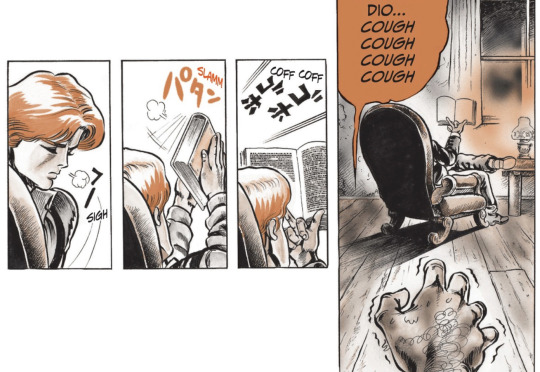
- to the time he's systematically broken down his adoptive brother's spirit by alienating him from his friends, taking Erina's first kiss, and of course kicking his dog, Dio is shown as being in control and on top (Erina drinking the muddy water is the only exception). It's OOC to imagine 12-year old Dio feeling sorry for himself because at the time he's introduced, he's already made a habit of getting what he wants. By the time he sets off for the Joestars after killing his first dad, he's already developed full confidence in his abilities and the inevitability of his rise to riches (something Araki has him explicitly state and then underscores with a panel illustration of a steam train signaling the rise of Modernity).

But the writers and director of the musical don't find this characterization interesting enough or something. So they lose the canon entirely and in its place they invent a version of Dio who's despondent. And they didn't get Araki's steam train memo so they miss the Modernity theme (even though Araki's tied Dio so tightly conceptually to the idea of the Modern that he has him "use a 20th century boxing technique in the 19th century"); instead they double down on class difference being determinative. It never occurs to them that Dio is written specifically by Araki with the freedom to move outside of his social status because he sees it as artificial (the "evil elite" monologue later reveals Dio thinks of the whole social contract thing is arbitrary and voluntary).
Throughout the musical, Dio (although it's not fair to Mamoru Miyano since he isn't responsible for writing this mess, let's use mamoDio from now on because it's easier) seems to idolize the Joestars for what he calls their "beautiful blood." Not "beautiful" because usable calories for the vampire he will become but "beautiful" because noble. The Joestars' noble status and the honor that's apparently behind that status become the shining "star" toward which mud-bound mamoDio flailingly, failingly reaches. I don't need to tell you that in canon Dio doesn't have respect for nobility.
"Mud and stars" is heavy-handedly introduced as a dominant theme of the musical. According to the play, Jonathan, noble and bright, looks to the stars while human Dio, pathetic, conflicted and even confused, can only see life as a mud-soaked prison.
Now, the mud and stars thing was only used in Part 1 as a single text element on a Volume 1 illustration but, in spite of its marginality, it's becomes a liturgical text for some fans looking for an explanation for Dio's actions beyond what Araki gives them in the actual narrative. To this sort of fan, a guy who embraces his inner talent for evil and never had the misfortune of developing a moral compass isn't the right type of villain because he's unapologetic. If the villain doesn't have excuses how can you apologize for him? So they need Dio and by extension Araki to give them a "good enough" reason to accept Dio's ever-escalating atrocities. If the reasons Dio has for doing the things he does lie outside of what's considered good or acceptable, they are simply rejected and new reasons are invented in the hope of making Dio much less objectionable.
Now, like I said earlier, Araki's repeatedly told us in his writings that Dio has an upward narrative trajectory, not a downward, "mud"-bound one. The mud and stars duality fails to describe the narrative journey of the two main characters: both look upward to transcend their circumstances and travel along a shonen manga hero's rising path. (In fact, it's Jonathan who needs a good push to realize his potential, something Dio happily provides). And it's Jonathan, not Dio, who Araki first gives a downward arc, being handed defeat after defeat for those first four chapters before gaining his footing and progressively rising to Dio's challenges. "Mud and stars" isn't just a bad choice of metaphor, it's a misleading one.
Back to the musical, mamoDio is the exact opposite. An air of sadness and insecurity haunts his performance. An original scene where George presents the mud and stars dilemma as a lesson highlights Dio's lack of confidence and the depression that lurks behind it, as Dio bemoans how people doomed to "struggle and die" cannot possibly summon the hope it takes to look up to the stars (he's talking of course about himself).
Likewise, and here's where mamoDio's failure as a character really comes into full relief, seven years after this, when Dio's machinations are revealed and he's about to be arrested, before he uses the stone mask, mamoDio drops to the floor and spends the better part of a musical number in tears, bemoaning his sorry life ("I'm trapped in a prison covered in mud… no matter how hard I struggle I'm crushed…") and his lack of noble blood.

(btw this is after the manga scene where Dio fake cries; here, mamoDio is genuinely distraught).
Contrast this to the actual scene in the manga. His expressions in these panels are memorable because of how assured Araki draws him. Dio's entire world - his poisoning scheme, his grab at what one can assume would have been the entirety of the Joestar estate - is about to end but instead of despairing, he launches into a philosophical soliloquy. His body language is haughty: this isn't mamoDio crawling on the ground and decrying his upbringing and lack of noble blood, instead this is a man who apparently, almost irrationally, perceives himself as noble. When he uses the mask, Dio is smiling widely. Metaphorically speaking, he's looking at the stars.
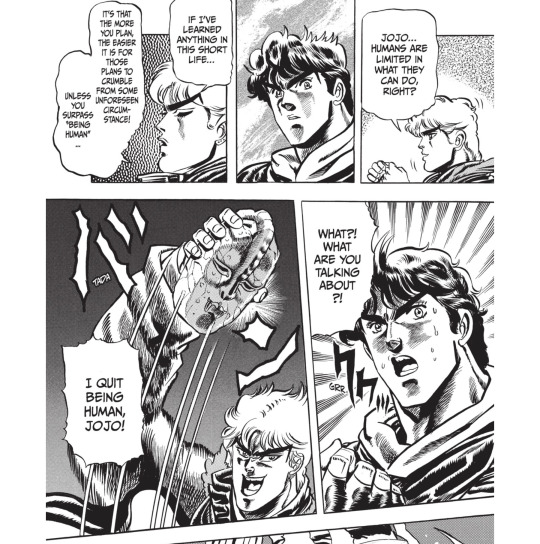
When mamoDio uses the mask? He's on his knees. He's in tears. On one night he interjects, "Mother…" In short, he's conflicted.
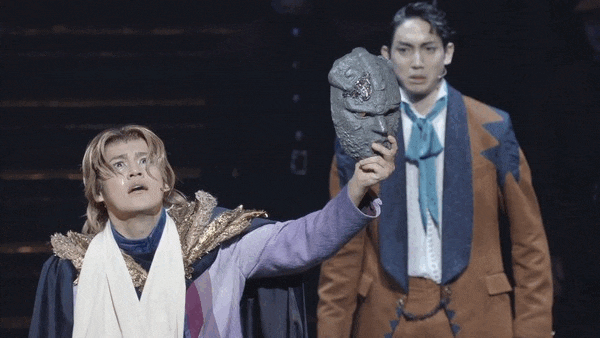
One of these depicts Dio. The other does not.
Now obviously the writers and director of the musical must think making these seismic changes adds something to Dio's character. But (and I feel like this is a theme whenever I write these things) I'd argue it only makes him more basic. It makes him predictable and formulaic, someone we've seen in countless other stories.
(Oh! and did I mention mamoDio repeatedly calls himself "useless"!! Because he does this.)
Now, because mamoDio has no confidence and as a human acts out of desperation, when he becomes a vampire he still isn't Dio. Mamoru tries to make his vampire Dio evil and scary by expending a lot of energy, running about the stage and sticking out his tongue ad nauseum. When you look at how Araki has Dio move physically throughout the manga, it's the opposite of kinetic. Dio is a point of fixity who's charisma draws others toward him (ask me for more on this if you want because there's enough here for its own post).
Now for the worst of the worst: at the very end of the production, after the manga ending that features Jonathan's death and Dio's (presumed) defeat as a head imprisoned in Jonathan's arms, the musical takes an original twist in which, following a finale number featuring most of the cast, mamoDio is lead offstage by Jonathan. You read that right. mamoDio is hunched over, resigned, and Jonathan seems to take on a paternal role. Although the lyrics would have you believe this has something to do with "two fates becoming one," it's clear from the stage direction that any embers of Dio's ambition are being tamed and extinguished as Jonathan takes Dio's grasping hand, subdues him, and leads him docilely into the darkness.
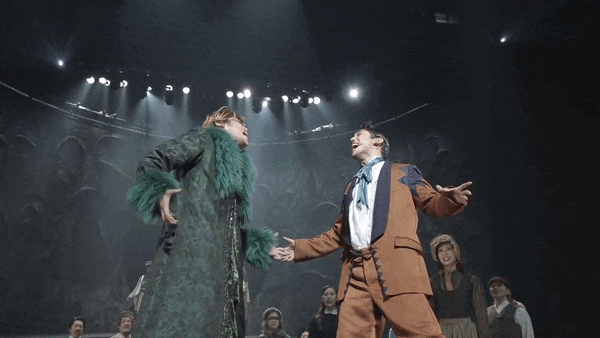
It turns out Dio's vampire arc was just a phase, a hurt and lonely child lashing out and making a mess for attention.
His body language here is obscenely out of character. Consider the following because, as I said in the opening, in spite of what all these re-writes of Dio would have you believe, Araki crafted Dio with specificity and consistency: Araki only draws Dio (with very few exceptions) 1) standing tall, looking down at you; 2) back turned, looking back and down at you; or simply 3) back turned, (performatively?) ignoring you. Dio is never on the ground except when he's knocked down (think, young Jonathan finally fighting back in the Joestar home or, much later, Jotaro stopping time and landing those punches). By constrast, mamoDio has spent an incessant amount of time of the ground, crouching, kneeling,, bowing, hunched down. Who is this guy? So his hunched-down exit in the final moments of the production, literally being led by Jonathan (controlled??), is so amazingly stupid that if I didn't have a gif as proof, you might think I'm just making this stuff up:
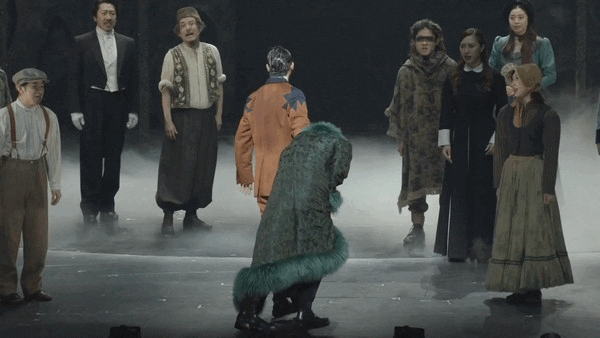
There's plenty more to unpack that I won't address here: ghost Dario. The lack of grave-spitting. The complete absence of true joy or leisure expressed by Dio especially during his vampire era: no woman eating her baby, no owlcats, no Poco's sister. No chaise lounge. No roses(!). No fun. Not for Dio. That would be too manga-consistent. That might mean Araki wasn't giving us the appropriate message that bad guys are actually just sad guys.
tl;dr Dio isn't in the Phantom Blood musical. He's replaced by a normal guy who's motivated by a lack of self-esteem and despair that he wasn't born into an upper-class household, or something. He's boring. The result? There can be no Part 3 in this musical's world (and presumably no Parts 4, 5 or 6, no Giorno, no Jolyne, … you get the picture) because mamoDio just gives up. It's a nicely produced little tale about Jonathan Joestar and some random other guy who at some point gets a funny green coat.
#Anonymous#replies tag#jjba#jojo's bizarre adventure#dio brando#mp#dioposts#jojo no kimyou na bouken#jojo#phantom blood#phantom blood musical#dio talk#long post#the fact that media that's otherwise faithful to the text goes out of its way to rewrite Dio and only Dio consistently sends me
154 notes
·
View notes
Text

This is a book for readers of second world war history who like the Boy’s Own version of the conflict. The cast of characters could have stepped straight from a comic strip story. Yet the men of the SAS were real flesh and blood, “rogue heroes” as the title suggests. The organisation now famous for its derring-do, and as famously secretive, has opened its archive to the historian and journalist Ben Macintyre, so that he can produce the first authorised history of what the SAS did in the war.
Macintyre has made the most of the opportunity. The history needs scarcely any embellishment, though he tells it with flair: the simple facts of SAS activity make the “ripping yarns” of comic book heroes pale by comparison. The organisation was the brainchild of two officers posted to the war in Egypt, David Stirling and John “Jock” Lewes. Stirling was an awkward soldier, hostile to spit-and-polish and authority, charming, fun-loving and irreverent (“layer upon layer of fossilised shit” was how he described military bureaucracy). Bored by life in Cairo, he discussed with the ascetic, hard-working, serious-minded Lewes, his complete opposite in personality, the possibility of creating a unit of awkward men like himself, who wanted action, few rules and adventure in small hit-and-run assaults behind enemy lines. Astonishingly, Stirling persuaded the high command in Cairo that he could achieve something significant at low cost in men and materials. The chief of British deception in the desert war, Dudley Clarke, gave the unit its name. Already fooling the Italians with a bogus parachute unit, the First Special Air Service Brigade, he lent the name to Stirling, and the organisation has borne it ever since.
Macintyre uses the SAS war diary as the backbone of his narrative, and is candid about failure as well as the hard-earned successes. The SAS was an irregular unit, its members drawn from an extraordinary range of backgrounds – a spectacles salesman, a textile merchant, a tomato farmer, amateur boxer, and so on – with a range of motives to match. Some wanted excitement, some liked killing and made no pretence about it, some were escaping from their past, some were too eccentric for the ranks; all had to be fit, alert, crafty, ruthless if required and dedicated to the mission. Stirling was also aware that his outfit did not meet with approval in conventional military circles, which saw war as face-to-face, not behind the back. Churchill liked the force, and would no doubt have joined it had it existed in his youth. But through the campaign in North Africa, then Italy and Germany, the SAS had always to prove itself, in order to stave off disbandment.
The new unit nevertheless made a disastrous start and indeed had mixed fortunes throughout the war. The first operation, code-named “Squatter”, carried out while the handful of volunteers were still feeling their way, could not have gone more wrong. Poorly trained as paratroopers, the group nevertheless flew off into a desert storm trying to land at pre-planned dropping zones well to the rear of the enemy. They landed in the worst places, faced a Saharan downpour of biblical proportions, lost some of the troop to injury as they hit the ground, and were then unable to retrieve the parachuted supplies. With explosives so soaked they were worthless, uncertain about their whereabouts, short of food and water, the remnants of the original units made their way back to Egypt. Out of 55 men, 34 were killed, injured, captured or missing without a single achievement.
Macintyre makes the point that this was by no means the end of a madcap idea. Stirling recruited the Long Range Desert Group to take the SAS teams by Jeep or truck rather than risk any further parachute drops, and the second set of raids in December 1941 resulted in the destruction or disabling of 60 enemy aircraft. But Operation Bigamy, a series of raids against Benghazi shortly before the battle of El Alamein, was another disaster. It featured one of the most bizarre figures to emerge from the story: a Belgian textile merchant, Robert Melot. Fluent in Arabic, keen to get at the Germans, he volunteered for the SAS aged 47 as an intelligence officer. He used his range of Libyan contacts to glean information needed for the raids, but in this case Melot miscalculated. An Arab double agent alerted the Germans and Italians and the raids were a disaster. Once again a forlorn, bearded, hungry and damaged band straggled back to Cairo. Melot carried on his SAS career regardless, and died not from his many scrapes in battle, but from a Jeep accident on his way to a party in Brussels late in 1944.
The SAS came of age in the campaign in Italy, where it was used as a more conventional raiding party, the Special Raiding Service, under the command of Paddy Mayne following Stirling’s capture in Tunisia in late 1942. The Italian campaign was a particularly grisly one, and the SRS (with its core of SAS men) found collaboration with the partisans and rivalry with the Special Operations Executive (SOE) a challenge (unlike the SAS, the SOE always linked up with local resistance). Macintyre spares none of the details; the SAS fought a dirty war against an enemy they regarded as every bit as dirty. Prisoners were rare, but in return Hitler condemned irregular commando units to death if they were caught. Not all were killed by any means, but many were, just as the Germans killed all the other irregular, partisan forces ranged against them.
In October 1945 the army wound up the SAS and it continued to exist by subterfuge, a unit of war crimes investigators searching for evidence across Europe that SAS members had been murdered. In 1947, to meet the many crises of empire, the SAS was revived. What it did then and since can be guessed at, but until the postwar unit diaries are revealed, like the wartime diary used by Macintyre, the exact details will not be known.
What in the end did the SAS achieve in the war? Macintyre does not really say, leaving the narrative to speak for itself. It did not, as some of the book’s publicity has suggested, turn the tide of war. Its overall accomplishment, set beside those of the Commandos, or the SOE, the Chindits or other partisan groups, was strategically modest, whatever its tactical successes. But the SAS did bring to life the plucky, maverick, individualist hero of the comic strip, a very British way of making war. SAS: Rogue Heroes is a great read of wartime adventuring, in a long, grim war of attrition where adventure was hard to find.
Daily inspiration. Discover more photos at Just for Books…?
40 notes
·
View notes
Text
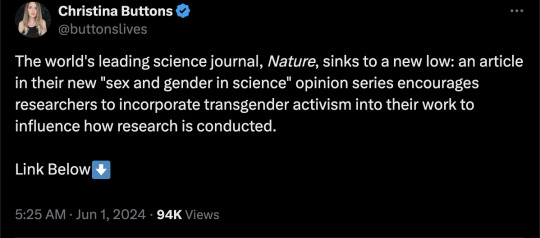
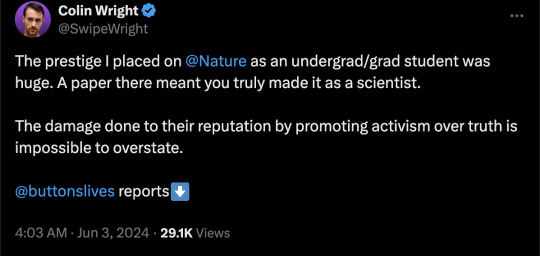
By: Christina Buttons
Published: May 31, 2024
The prominent science journal Nature has launched a new opinion article series on sex and gender. One paper in this series explores research attempting to search for a biological basis for trans-identity, arguing that such research could “pathologize” and “harm” the trans community. The authors discourage “investigations into the underlying bases of transgender identity” and propose various steps for researchers to incorporate transgender activism into their work to influence research outcomes — signaling the end of Nature’s commitment to pursuing scientific truth over ideology.
The article starts by reviewing neuroscientific studies aimed at finding the cause of trans-identity in the brain, identifying 83 papers from 1991-2024. It highlights the transgender brain-sex hypothesis, which suggests that trans-identified people have brain regions resembling those of the opposite sex. However, it neglects to mention that this hypothesis falls apart because the studies did not control for confounding variables such as sexual orientation.
The article does acknowledge that “the results of these analyses have been inconsistent.” Yet, when the media covers these studies, the public is often informed by headlines such as “transgender people are born that way,” “science proves trans people aren’t making it up,” and “attacks on trans people are also attacks on science itself.” You can read a simplified explainer I wrote debunking the brain-sex studies here.
The authors move on to the more plausible “own-body perception” theory, which proposes that reduced structural and functional connectivity between certain brain networks is responsible for gender dysphoria. However, these studies do not show a causal link, only an association. Abnormalities in body perception networks in the brain are also associated with many other conditions, including body dysmorphic disorder, anorexia, body integrity identity disorder, schizophrenia, and autism.
After reviewing the neuroscientific studies, the article’s language shifts into typical activist rhetoric, claiming that research into transgender identity can be “harmful.” The authors argue that if brain scans or some other objective test could assess whether someone is experiencing gender dysphoria, it could be used to prevent people from accessing cross-sex hormones and surgeries if they are not deemed “eligible.”
"A second possibility is that neuroscientific findings related to transgender identity will fuel transphobic narratives," the authors write, citing a “feminist perspective” social science journal article on "Transprejudice."
For example, they state, "Some people argue that allowing transgender women to access infrastructure, such as public toilets or women’s prisons, threatens the safety of 'real women'." It is odd and audacious for a serious science publication to use "real women" in quotations. Moreover, their source for this claim is an article about Kathleen Stock, who does not argue that transgender women threaten the safety of biological women. In fact, she explicitly states the opposite: "I am definitely not saying that trans women are particularly dangerous – they are definitely not."
The authors also take a dig at sexologist Ray Blanchard, claiming that autogynephilia “hasn’t held up to scientific scrutiny,” citing a "feminist analysis" paper by a trans activist. Apparently, they haven't spent any time on trans Reddit, where they would encounter a vast discourse on "gender euphoria boners."


The authors end by setting “four actions” for researchers studying transgender people to prevent further “harm” from being done. They suggest researchers set up an advisory board and multidisciplinary teams consisting of transgender people to consult on their study designs and “prevent the outcomes of neuroscientific and other studies from being described and published in an overly deterministic and simplistic way.” They also dictate what should and should not be studied, suggesting researchers "prioritize research that is likely to improve people’s lives" rather than searching for the cause of trans-identity.
The final suggestion is to “rethink how ethical approval is obtained,” which relates to an example they provided of a 2021 UCLA study that was suspended after significant backlash from transgender activists. The study aimed to examine the brains of trans-identified individuals by showing them images of themselves wearing tight clothes, intending to trigger gender dysphoria. Although the study obtained ethical approval from their research institute and the transgender participants provided informed consent, it seems they weren't the right transgender people to ask permission from. Their suggestion implies that researchers must obtain approval for their studies from transgender activists.
The authors seem aware of the implications of their recommendations, as they conclude their article by admitting their approach would limit scientific inquiry:
“Our aim is not to halt scientific enquiry. But when it comes to transgender identity, knowledge cannot be pursued in isolation from the many societal factors that shape how that knowledge is received and acted on.”
This statement translates to prioritizing activism over truth-seeking when the findings might be inconvenient or misaligned with political narratives and activist goals. Such a stance compromises the integrity and credibility of science, reducing it to a tool for activism rather than a means of uncovering and understanding reality.
It is disheartening to watch one of the world’s most prestigious scientific journals compromise their credibility by continuing to prioritize ideology over truth.
Besides, the authors' concerns about discovering a biological cause for trans-identity are misplaced. While there are biological traits associated with being transgender, such as same-sex attraction and gender nonconformity, “transgender” itself does not appear to be an inherent condition one can be born with. The concept of "transgender," as understood in Western cultures, is a cultural construct that doesn't have a direct equivalent in many non-Western societies.
Research into a cause for gender dysphoria would be difficult because the transgender population has become so heterogeneous. Even if one were predisposed to a psychiatric condition like gender dysphoria, predispositions are not predeterminations of a transgender outcome. The notion of transgender identities being fixed at birth is further contested by the increasing number of detransitioners and extensive research on desistance among children, suggesting that such identities can often be temporary coping mechanisms for young people in distress.
==
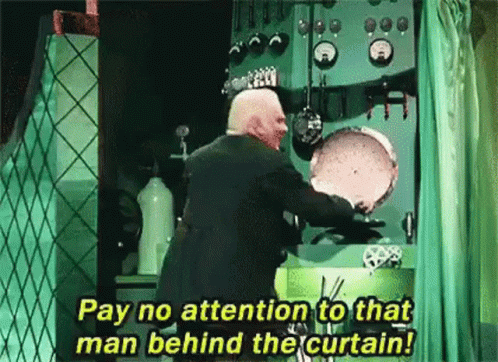
We're just supposed to accept that hacking off body parts and giving life-altering drugs and hormones is a completely normal part of life. And that wondering where this is all coming from, what's underlying it is the problematic part.
At its core, the point of this ideology is to pathologize the completely normal and normalize the pathological.
Carl Sagan warned us about this:
"The truth may be puzzling. It may take some work to grapple with. It may be counterintuitive. It may contradict deeply held prejudices. It may not be consonant with what we desperately want to be true. But our preferences do not determine what's true." ― Carl Sagan
Reality is not obliged to conform to people's wishes or preferences, and we are not obligated to lie or consign ourselves to ignorance in order to placate those wishes and preferences. We don't allow "if you find out what's true, it'll hurt our feelings" - i.e. blasphemy - for the religious. Why are we allowing genderist fanatics to get away with it, when it's still just an accusation of blasphemy?
When people say, "you're not allowed to go looking over here, it's a moral failing to do so," the correct response is to go, "now I want to go look over there even more."
-
"Sex is real... But the belief that we have a moral duty to accept reality just because it is real is, I think, a fine definition of nihilism." ― Andrea Long Chu, gender cultist and lunatic
“The facts may tell you one thing. But, God is not limited by the facts. Choose faith in spite of the facts.” ― Joel Osteen, religious nutcase and lunatic
#Christina Buttons#Nature#Nature magazine#ideological corruption#science denial#blasphemy#corruption of science#scientific inquiry#gender ideology#gender identity ideology#queer theory#intersectional feminism#religion is a mental illness
14 notes
·
View notes
Text
Penny and Winter as Symbolic Human Machines
So honestly, I’m really impressed by how well done the ending of RWBY Volume 8 was with regard to character arcs being fulfilled, especially for Penny and Winter. I’ve seen a lot of takes, some that I somewhat agree with, and some that I just don’t, that Penny’s death was “bad writing,” and I think that, subjectivity of what constitutes bad writing aside, this is ignoring a lot of aspects of V7/V8 that made for a very compelling narrative, and feels heavily based in just people wanting Penny to not have died.
And I get this! Penny is one of my favorite characters and I’m very sad that she died; however, I really actually loved how fitting her death was for her story and the broader story of RWBY as a whole, so I wanted to do a write-up of my whole rant on this so that people could read it and see my thought process for why this only made me love Penny’s writing more. I’m not necessarily going to ascribe value to the writing itself in this analysis, as that is highly subjective, but I am biased so that’ll shine through some.
V7 through V8 had a lot of moments that frankly I hadn’t picked up on right up until the end that worked to build a dynamic interplay between Penny and Winter’s characters. Specifically, Penny's role is of a literal robot becoming less of a machine in the thematic sense and more of a person throughout, contrasting with Winter, who, while she is helping Penny realize herself as more of a person and less of a tool, is going through the opposite experience herself. This is essentially textual - it’s explicitly said by Winter herself in less words during the Maiden power transfer scene in V8E14.
When we as the audience reconnect with Winter at the start of V7, she is firmly entrenched as Ironwood’s confidante and second-in-command, serving as a face of the Atlas military as it squeezes Mantle. It’s safe to say that not many Mantle citizens like her very much, but she is insulated from this and continues to follow orders without regard for the welfare of the people. Ironwood at this point is already extremely authoritarian, even though he hasn’t graduated to full on dictatorship and declared martial law yet, and his will is also imposed on her through bringing her into the fold with the chief purpose of grooming (god this word feels grossly fitting given their dynamic) her to become the next Winter Maiden.
Winter, despite holding a a significant level of power and authority due to her military rank, has very little agency in this decision. She insists that her choice to take up the duty as Ironwood ordered is something she’s grown into and chosen, but it’s alarmingly clear that this is not the case; nearly every action she takes in V7 is still fully in the purview of Atlas (read: Ironwood)’s goals. I would go so far as to suggest that Ironwood giving her this position within the military after she escapes her father’s influence is intentionally conditioning her to view him as the sole way out of an abusive situation, and to disguise the fact that this new situation is just as abusive as the first below the surface.
Penny’s role in V7 is completely in opposition to this; while she is still theoretically under the control of the Atlas military, she is presented as the Protector of Mantle and seems to be beloved by the people. Our immediate image of her in Atlas is one of emotion and caring; she is overjoyed to see her friends from Beacon again, and this continues throughout the volume as she talks about what it means to be a person with them, Ruby and Winter especially. When things start going wrong and she is accused of killing people through the doctored footage from the rally, she is horrified at the prospect of being seen as a monster and continues to make every decision with the aim of protecting everyone around her, even at the expense of what her “duty” to Atlas might be. It’s clear that she is growing into her own agency, rather than being beholden to what Ironwood wants for her, and this helps prove to herself that she is her own person, not simply a tool of the military, not a machine.
The climactic scene of V7 takes these two character arcs running in strained parallel and drives a wedge between them, even as they battle a common enemy side by side. Winter’s devotion to Atlas (read: Ironwood) results in self-destructive tendencies, uncaring for her personal survival if it would further a goal that she ultimately and ironically does not truly believe in. Penny, however, begins to entirely shake this duty, risking even the Maiden power going to Cinder if it means saving Winter from dying. To her, personal feelings (ding ding ding!) and personal friendships mean more than duty to a state, or even (as we see later) her own well-being. Self destructive tendencies aside, this loyalty to people she earnestly cares about, who earnestly care about her, is loaded with symbolism that separates her from the metaphor of machine.
The result of the V7 finale reinforces the track the two of them are on; Winter, having been molded into a machine of the military, fails in her duty, while Penny, who has begun to recognize herself more and more as a person, succeeds at keeping the power from Cinder. She still has a massive amount of self-doubt and deep-seated fear that she doesn’t count as a person, but the Maiden power, being the perfect thematic symbol of “maidenhood”, goes to her, proving her to be a “real girl” and reinforcing the ongoing narrative. Winter, battling her own mixed feelings over being chosen for the power, never questions this; it’s clear that she, too, recognizes that Penny “was always the real Maiden, while [she] was the machine.” This also reinforces Penny’s narrative being heavily trans-coded, but I think that’s pretty obvious and doesn’t need to be reiterated. The two of them part sides here, one remaining with the Atlas military and one actively rebelling against it.
As Ironwood starts going off the deep end at the end of V7 and throughout V8 and starts sacrificing everyone around him to fuel his own narrow and tyrannical view of how to save Atlas, Winter simply...falls in line. She is continually forced to follow harsher and harsher orders, and any choices she makes as part of that, with only two exceptions, still are entirely in service to Ironwood. She has become, in essence, a machine locked into a set path, a path she, conflicted as she may be, follows all the way up to a choice she cannot abide - mass murder. Even orders that would result in her sister’s closest friends’ deaths she follows unquestioningly - it’s unclear whether she would have actually gone through with it, since the option is taken off the table by forces outside her control, but she certainly says as much in her conversation with Marrow. Only the prospect of annihilating the entire city of Mantle finally snaps her off the track Ironwood has set her on, making her recognize that all of this has never been for Atlas at all, but for Ironwood’s own ego. Fittingly, finally seeing Ironwood as her enemy and not a savior, she is tasked with taking him down herself.
Contrasting this, Penny’s role in V8 is entirely one of rebellion. The entire volume is her building her agency more and more, making decisions based on what she thinks is right and what she values. She rarely listens to any one person telling her what to do; even her father, who she loves dearly, isn’t able to make her do something when her sense of justice is on the line. Ironwood no longer has his hold on her for the most part; any attempt at manipulating her into doing something against her own morals is met with defiance, supported by her friends’ love for her. She has to be outright hacked to be forced into doing his bidding, and she fights this all the way down, her own inherent personhood pushing back against this attempt to dehumanize her. In this sense, even her becoming organic symbolizes this; she and the people she cares about defy this dehumanization of her, finding a way to free her from the last remaining vestiges of Atlesian influence and further reclaiming her own agency.
And what does she do with that agency when she is faced with oblivion? She simultaneously affirms it by making her final choice in a desperate situation, defying Cinder’s attempt to rip her power away, and also gifts it in the form of the Maiden power to the woman who she is watching attempting to also shake the shackles of Atlas, symbolically showing Winter her own inherent humanity. This decision, though dire, is in recognition of what is most important to her: her friends. Even believing half of them are dead, she gives up her life to ensure the rest survive. In the final moment she has with Winter, she reassures her that she won’t be really gone: the memory of her choice and who she is as a person will live on through Winter’s continued choices, through her agency.
In the end, neither of them were machines; just two hurt people fighting back against a brutal world that sought to strip their agency away. The tragedy in this conclusion, that that brutal world took one of their lives away, is fought just as defiantly. Penny knows that gifting the power in her soul to Winter means that her death won’t be meaningless, that her agency will last beyond her mortality and might result in the world finally being freed from the threat of destruction. It’s because of hope, not despair, that she makes her final choice.
#rwby spoilers#rwby8 spoilers#my writing#CRITICAL ANALYSIS TIME#i've been meaning to write up my rant on this for months#rwby#winter schnee#penny polendina
140 notes
·
View notes
Text
a word on color - how line of duty series 6 uses wardrobe color to frame narrative (pt 4)
Author’s note: this is the conclusion to my essay on wardrobe color and how it’s used to inform narrative in series 6 of line of duty. Previous parts can be found here: Part 1, Part 2, and Part 3. This part covers episodes 5, 6, and 7. Heads up, my analysis of episode 7 is actually quite short because of my focus on Jo, but I have many, MANY thoughts on Kate’s second to last scene and the general wardrobe choices for Kate in this episode.
Thank you to everyone who has been willing to entertain my ramblings here. While I have a background in theatrical production, this kind of meta analysis was quite new for me. I was relieved to see (most) of this theory actualized in the finale. Now, this part is nearly 8k words, all four parts together clocked in at over 20k words and nearly 40 pages, single-spaced, so I’ve officially written a third dissertation (after the other two took me 10 months…).
Regular warnings apply: I’m American and therefore may be missing certain cultural context. Spoilers abound, but I stick to Jo’s storyline for the most part, and don’t include my thoughts about the finale writ large (I may write an analysis of the series 6 storytelling separate from this, if there’s interest).
Read on below the cut.
EPISODE 5
Episode 5 opens with Lomax briefing Jo and Kate about connections between the armed robbery and Gail Vella's murder, showing them results for an industrial estate that matches the description given by one of the robbers. Jo is wearing the same outfit she ended episode 4 in, the orangish brown sweater and navy suit, while Kate is wearing a grey jacket over a white shirt, buttoned all the way up. A side note - this grey jacket does not fit in with the rest of the wardrobe Kate has been in all series, and from a meta perspective, this is because they have to conceal the firearm Kate is now carrying. Ryan watches from the other room, again in a call back to the way Jo was watching Kate in episode 3. Kate tries to talk to Jo, but she's quickly brushed off, much to Kate's chagrin.
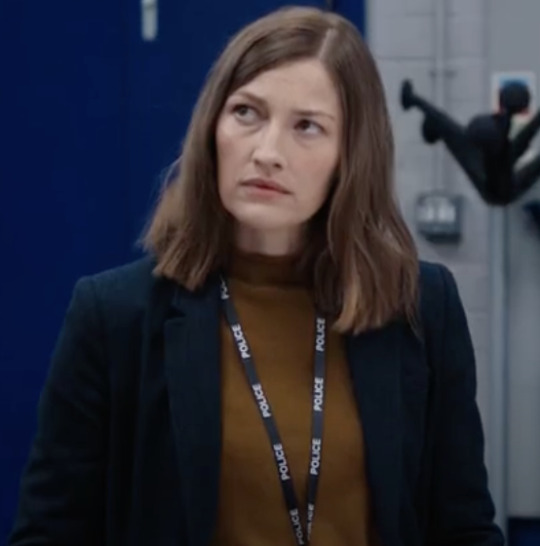
Jo’s outfit, which we’ve seen her in numerous times, again demonstrates her pull between what’s right and pressure from the OCG. After all, Ryan has just threatened her twice. She knows that the investigation is heading in the right direction, which she both wants and is afraid of, and she is panicking. At the same time, she’s wary of letting Kate get too close lest she suspect something and acts on it, putting them both in danger.
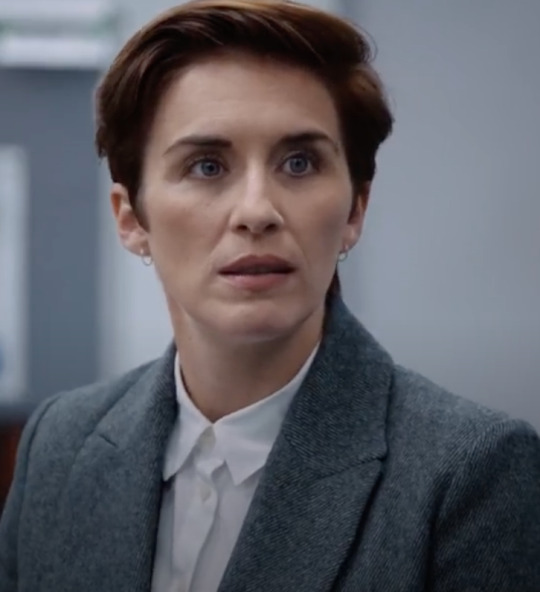
Kate’s outfit actually shows some of that forced distance Jo is causing. We’ve seen her wear a white shirt buttoned all the way to the top once before - when she spoiled the raid of MIT by AC-12. That outfit showed her pull between Jo and AC-12, and we’re seeing that here again. This time though, the grey jacket shows that she’s leaning AC-12.
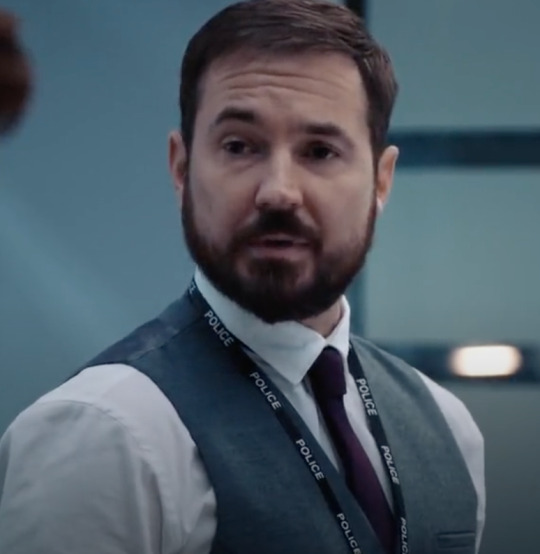
We see this in the next scene where Steve, in his grey suit with a white shirt and red tie, is directly paralleling his former partner’s wardrobe. Kate visits AC-12, and it's been revealed that she has permission to carry a concealed firearm because of the threat Ryan Pilkington poses. Now, call me crazy, but I believe we’re meant to understand he’s a threat to her at least in part because of her relationship to Jo, but I’m uncertain. When Ted asks for an update, Kate notes that Jo has become "cold and distant" toward her, and the team reveals Jo has been put under surveillance, which Kate isn't happy about. It's then revealed that Jo is related to Tommy Hunter (from series 1 and 2) through incest, which is of course horrifying, though we don’t know the full story of it quite yet.
Back at her apartment, Jo checks the laptop to find out the OCG won't let her go because of AC-12's continued investigation, which she promises to take care of. She’s surrounded by her blue flat, in her navy and orange outfit, her actions and heart still at conflict with one another. She’s distraught, and stuck.
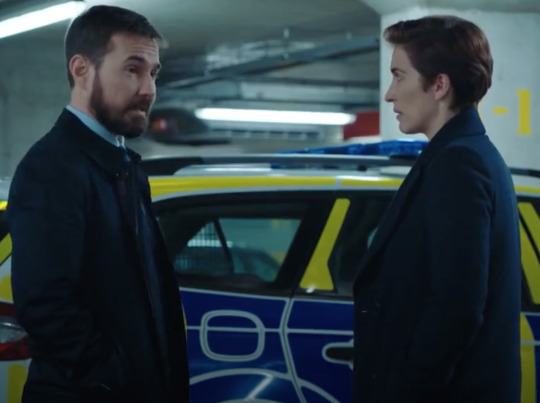
Later, Kate and Steve meet in an underground car park in their matching navy coats. Steve shares that Lakewell gave him information off the record, which is that Gail Vella had been looking into the death of Lawrence Christopher at the time of her death. He also tells Kate about his discovery that Hastings gave Steph Corbett the missing $50k of supposed bribe money (from series 5). The former partners match here because they are coming closer to being full partners again, working in tandem and trusting one another with information. They have been at odds this series, particularly when it comes to Jo, but they have remained on the same page in their disappointment in the gaffer and belief in finding justice for Gail Vella.
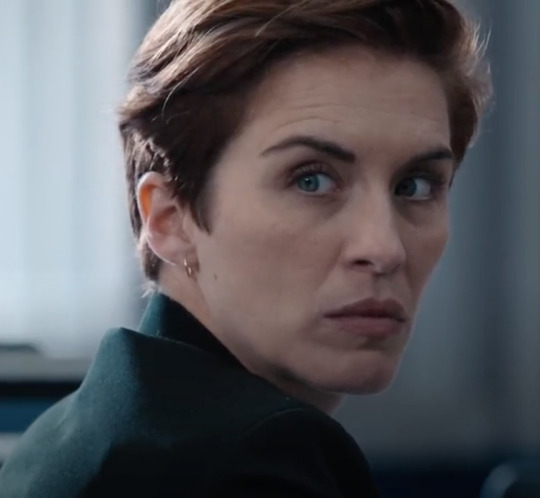
Back at MIT, Kate is looking into the industrial parks that may hold an OCG workshop. As she researches, she repeatedly looks over at Jo in her office and seems to have an idea. She then steps out of the office and calls Steve, though we don’t see the details of their conversation. Kate returns to the office and goes into Jo's office, telling her that they may have found the OCG workshop. She asks to brief the team immediately to avoid leaks, which Jo allows while glancing out at the bullpen. We can see once Kate leaves that she was looking at Ryan, who is watching her closely.
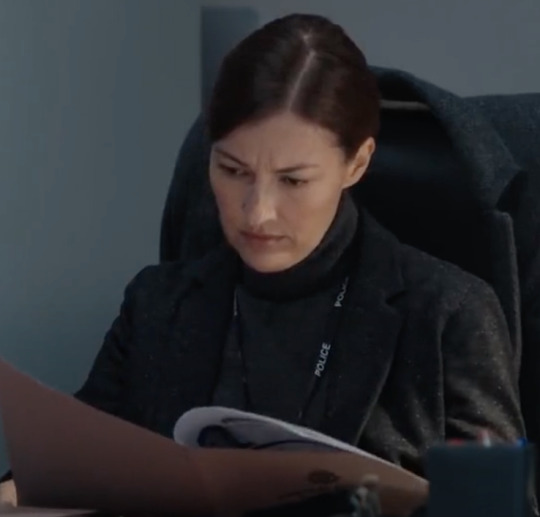
We don't know it yet, but Kate has found a way to test Jo’s loyalty and her belief that Jo isn’t bent. She tells the team about 1 location, makes them hand up their phones (which pisses them all off), and Jo makes them all stay within the MIT offices just as Ryan is about to step out. As the briefing ends, Kate goes to Jo’s office once more and demands to speak with her, despite Jo’s rude and annoyed response.
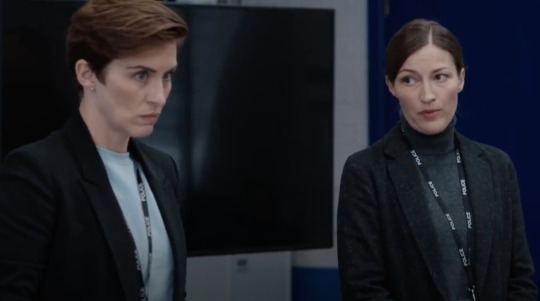
It’s later revealed that Kate then tells Jo there are 3 total locations to be looked at, but they’re starting with just one. Meanwhile, AC-12 surveillance teams are stationed at all three locations to see if people are tipped off and by who.
In these scenes, Kate is wearing a navy suit with a light blue shirt buttoned to the top, while Jo is wearing a grey suit with a grey turtleneck. For both women, the high necklines that fully encircle their throats indicates their discomfort and their desire to have a wall up for their own protection. We see Kate in all blue as she’s on a crusade to prove the truth - Jo isn’t bent, and this will reveal who is (as she suspects Ryan). Jo, meanwhile, is uncertain, and her monochrome grey outfit reflects that. Normally, this is the type of thing she would be expected to tip off to the OCG (as she did with Carl Banks), but Kate has cleverly made it so she can’t. She’s trying to push Kate away, but Kate keeps pushing herself right back in. She’s meant to be wary of Ryan, but she stopped him from an opportunity to send out a warning - and that’s before she knew there were three potential locations. All Jo knows is that she wants out from this lie and constant threat she’s lived under. She’s in all grey, not true blue but certainly not a warm tone, because she hasn’t decided what her next step is yet. Temporarily neutral.
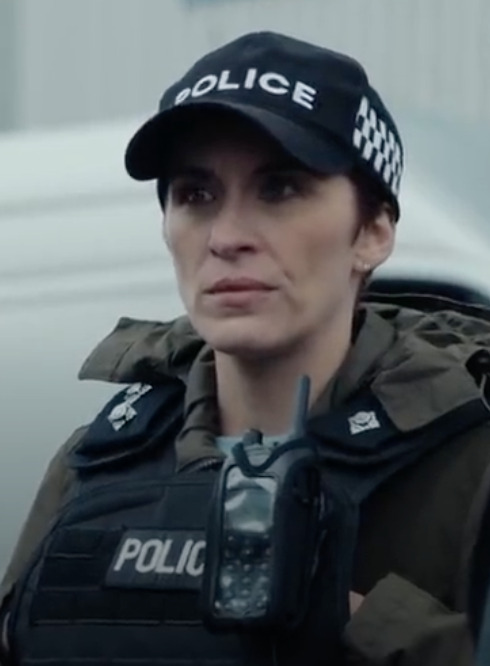
The initial raid is not a success, so Jo informs the team that they'll move on to the other locations instead, revealing that she and Kate did not give them all of the information. Lomax is pissed off, and directs that anger at Kate. From his perspective, the boss just told them she doesn’t trust him or the team and treated them all like a potential rat, and he chalks that up to the former AC-12 officer’s involvement. In an interesting parallel, Jo and Kate are wearing the same outfits under their body armor that we saw them in during the raid in the first episode - Jo in her black jacket and Kate in her green jacket.
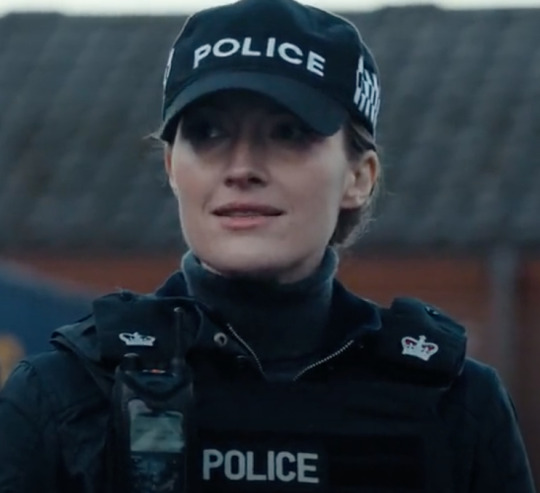
During this raid, Ryan snuck out to call in the danger to the OCG from a burner phone, an act which was recorded by Chloe “the only real detective” Bishop. Steve, at the real OCG workshop, rushes in with his team which results in the deaths of two suspects. Jo and the MIT team arrive on the scene not long after, and Jo and Steve come to disagreement over jurisdiction, and she ultimately forces him to stand down using her rank (which we’ll see her flex once more later in the episode). I have to say, I have loved watching Jo and Steve come to blows in this series in part because Jo is so much better at it than he is. Steve truly has been Jo’s foil, contradicting her at every point. We see this even in their clothes in this scene. While Jo is wearing a grey turtleneck (typically in the AC-12 color palette), it is hidden under her black jacket, and Steve is wearing a blue shirt under his body armor. On the visual face, they appear to be working at opposite ends to one another, and in this moment they are.
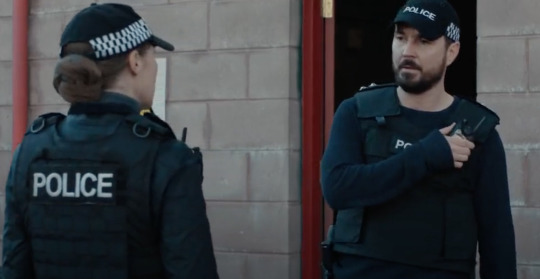
Back at AC-12, Kate debriefs the team on what happened and let's them in on the honey trap* (*not really) Kate set for Jo, which she didn't fall for (but Pilkington did). The team is taken aback, and Hastings points out how risky a move that was. "As far as I'm concerned, that's proof she's not bent," Kate replies, stubborn to the end. Steve has a different interpretation - Jo assigned herself to the raid on the location with the workshop, and took control of the crime scene from him. "That doesn't fit with what I've witnessed firsthand. I needed to know one way or another." Kate will not back down from her staunch belief that Jo is not bent, an unfortunate foreshadow to Jo’s eventual betrayal. Hastings sides with Steve, but Kate clearly still disagrees. However, Steve does believe Ryan should be removed from MIT, even as Hastings wants to keep him there. This raises their suspicions because Kate had originally talked the gaffer out of bringing Ryan in, but the reality of the matter is that Ted feels he’s on a ticking clock with his forced retirement, and wants to handle this fourth man situation before he goes.
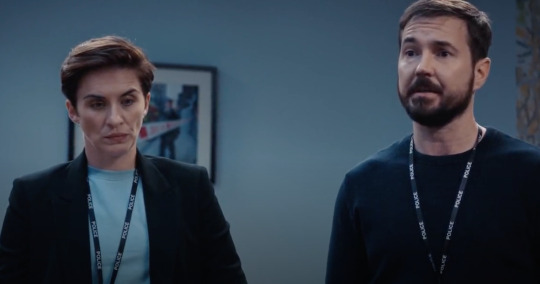
Kate and Steve are again in coordinated outfits here, dressed head to toe in blue. We’ve seen this before, the former partners in clothes that parallel one another while seemingly at odds. Sadly, this is because they’re again both right about Jo. She is using her position (and even Kate’s trust) to manipulate the investigation, but that manipulation stems from fear for her own safety as she herself is being manipulated and doesn’t want to do what she’s done. She’s like a cat stuck in a box - bent and not bent.
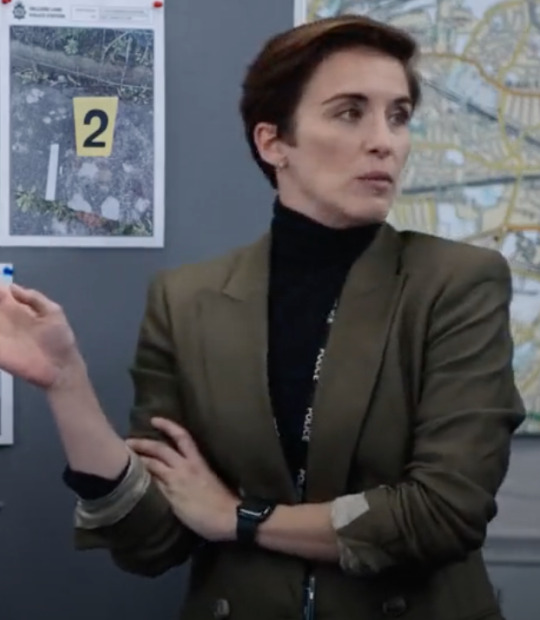
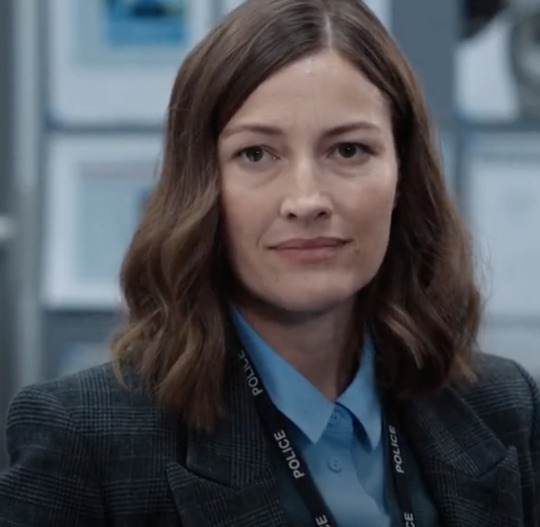
On the Hill, Kate gives the team the low down on the OCG warehouse and their next steps. Jo congratulates the team and tells them to get to work collecting forensic evidence while Pilkington sends laser eyes her way. This time it’s Kate wearing a turtleneck, this one in black under an olive suit jacket, while Jo wears a grey suit with a grey-green sweater and a blue shirt buttoned all the way to the top. Again, the high necks of these outfits demonstrate the discomfort and reservedness both women are feeling, but we also see a subtle connection with the green tints of their clothes. As usual, green represents the pull between two different compelling interests. For Kate, the pull between Jo and AC-12, for Jo the pull between Kate and the OCG.
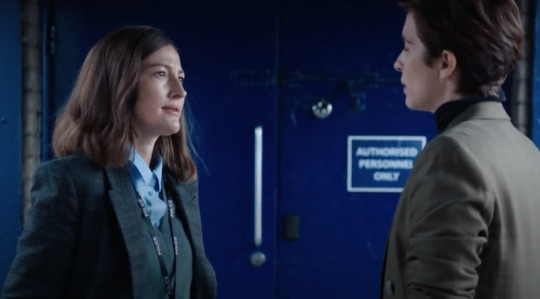
Wearing these same outfits, Jo catches up with Kate outside of Hillside, where she confronts her about AC-12's knowledge of the raids. Kate tells her she tipped them off because they're making a lawful inquiry. "Look, I'm telling you the truth Jo, because I trust you with it." Jo takes advantage of Kate sharing the information with AC-12 and tells Kate to put in a transfer request, saying, "I wouldn't want to harm your career, Kate. It's best if you request a transfer." Kate is taken aback and asks "You've been distant with me for days. Is this personal?" Jo denies this, pulling rank the same way she did with Steve, "I'm your senior officer, I should be distant." Kate seems confused and concerned with her response of "But I thought we were friends. What's happening here?" And here we see Jo’s fear crack through her irritation, just for a moment, when she says, "So you can tell AC-12?" As much as Jo is pushing Kate away in order to get her out of the picture, she also has a real fear that Kate continuing to share information with Steve will get Jo killed. She’s playing up Kate’s betrayal to explain her anger, but she’s also hurt and she wants her to know that. Jo trusts Kate, even if she doesn’t trust her enough to tell her the truth on her own. Up until this point, Kate has worked with her and told her about AC-12’s work, even helping her get a leg up on Steve. Now Kate’s helping AC-12 get a leg up on her.
But Kate is nothing if not determined. "No, I wouldn't tell them personal stuff." Kate refuses to take the transfer, and Jo leaves in frustration and anxiety, leaving Kate confused yet again.
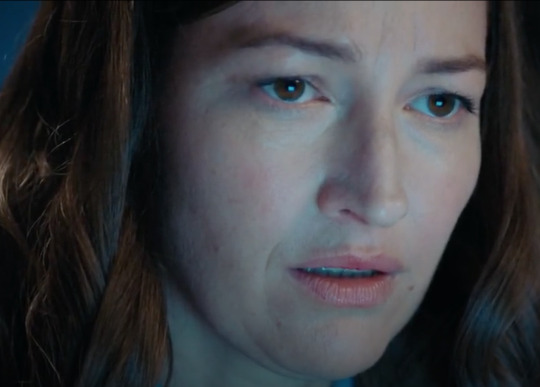
Back at Jo's flat, she's on the OCG laptop again. She tells the user she can handle AC-12, but they claim she can't because of Fleming. Jo tries to ask for more time to sort it, but time's up. "Get rid of her." Get rid of Kate, the last person Jo trusts, the one who just broke her trust.
And here is Jo’s betrayal. "As long as it's my last job." She looks devastated after she sends it, and she is. What she’s about to do is unforgivable. But scared and vulnerable people often do unforgivable things to save themselves. Jo just wants to be free, and she’s willing to pay a price for freedom.
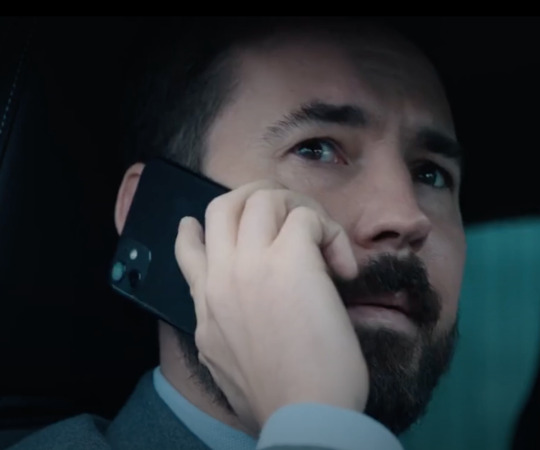
Steve, in his iconic grey suit and navy tie, goes to visit Ian Banks in prison and learns that Ted is the one that disclosed John Corbett's identity that later got him killed. He later calls Kate to tell her the news. Matching Steve, Kate is in a navy shirt, but is wearing a black suit, only the second time we’ve seen her in this suit. The first was in episode 2, when she gave Jo the information about AC-12 and they later had dinner together.
Kate heads back into Hillside after her conversation with Steve and runs into Jo in the hallway, who asks to meet with her outside of work to discuss their 'personal issues'. Jo specifically looks at officers further down the hall to confirm they're leaving before speaking to Kate. She also lowers her voice at her own mention of personal issues, adding an extra layer of privacy to an already empty hall.
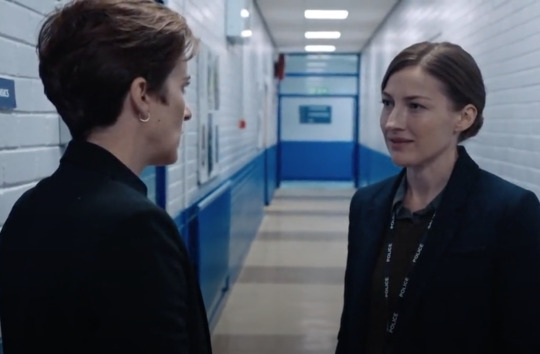
Checking to make sure there alone is something that Jo and Kate have done frequently throughout this series. In the handhold scene, they break apart when officers step into the hall. They mention how it’s easier to talk outside of work during both of their dinner scenes. When Kate tells Jo about Ryan’s spying, she dismisses Chris first, and later in that conversation when Jo puts her hand on Kate’s arm, they pull apart when they hear officers approaching.
Kate is surprised at Jo’s sudden change in behaviour from the past few days, but she agrees to meet with Jo after work. As Jo walks away, Kate clearly knows that something is up with her, but seems willing to find out what it is when they speak.
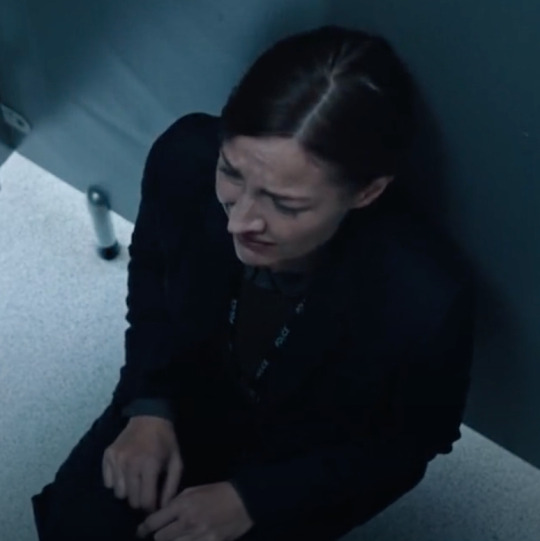
What Kate is sadly unaware of is that Jo walks away to lock herself in the bathroom and have a breakdown, distraught at the machination she has set in motion against Kate. Her hand shakes as she locks the stall, she falls to the ground, she looks around desperately for salvation. Jo’s mask, one that she maintains so strictly, falls for just a moment (not dissimilar to her breakdown in her car after framing Farida). Thirty seconds in a toilet stall to breakdown, to think about the consequences of her actions, about what she’s done to Kate. But she takes a few deep breaths, wipes away her tears, and we watch as her mask slips back into place.
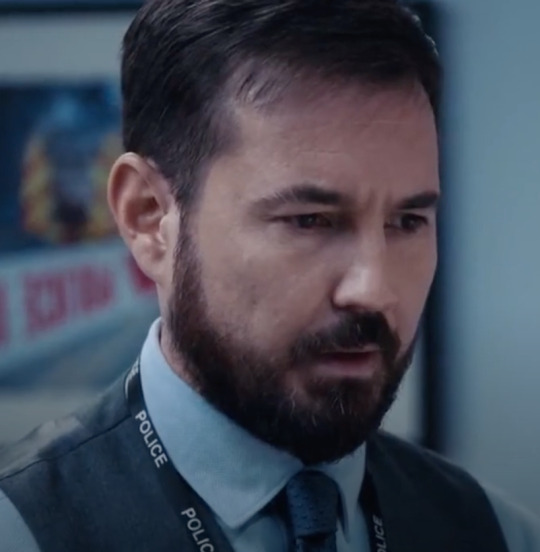
Back at AC-12, Chloe “my back is worse than Steve’s from carrying this investigation” Bishop has uncovered more about the racist gang that attacked Lawrence Christopher, including the investigators, Buckells and the current Chief Constable. This was the story Gail Vella was looking into when she was murdered, and appears to be the reason for her death. Steve is wearing the same grey suit and navy tie as when he spoke with Kate, and while he’s grateful for Chloe for digging everything up, he’s also concerned that the young Black woman had to learn so many details about the lynching of a young Black man. [Note: to be incredibly clear, the death of Lawrence Christopher as described by the script was a lynching, and the narrative did not do enough to reckon with that fact for anything more than relevance to the global racial justice uprisings reborn in late May of 2020. More than willing to discuss this further if anyone cares for my thoughts.] As they discuss the case, Patty Carmichael walks in with gusto (and damn if that voice isn't an incredible acting choice). She’s taking over AC-12, and she’s cancelling the surveillance on Jo and Ryan.
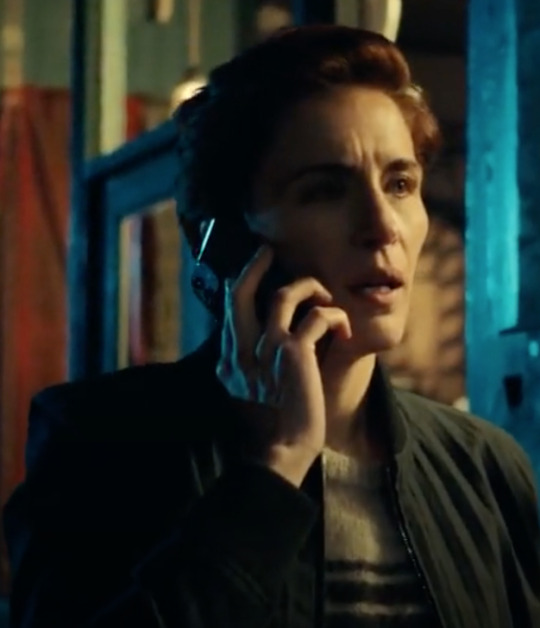
That night, Kate arrives at Frederico's to meet Jo, who calls her the moment she’s locked her car to ask to meet somewhere less public, for claims of privacy. Kate is immediately on alert, especially after her attempts to convince Jo to stick with the original plan. But after a small plea from Jo, she acquiesces, but not without caution. Kate immediately knows something is off - this is not how Jo interacts with her. Little do we know, Pilkington is skulking in Jo's backseat, coaching her actions.
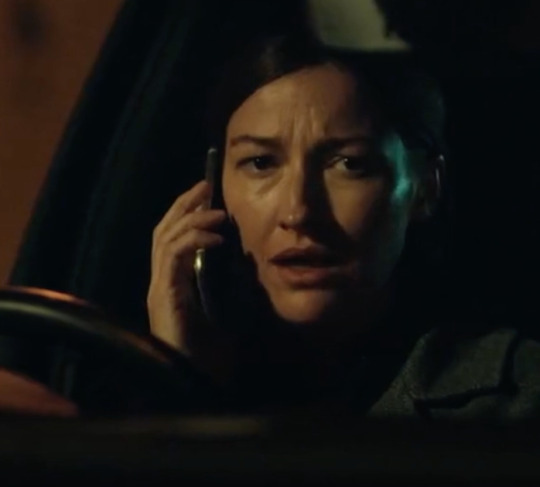
As an aside, this is also the only time we see them meeting out of work while they're both wearing casual clothes, not just the clothes they wore to the office.
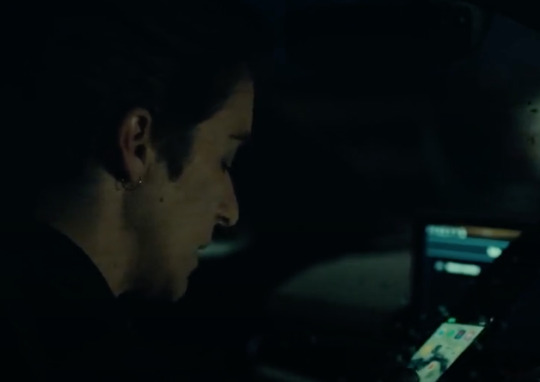
Kate drives to the lorry park and calls Steve, because she's both an idiot and a genius. He’s wearing the same suit as before, grey with a navy tie. She learns that surveillance was pulled on Jo and Ryan, and explains Jo's odd behaviour, forwarding him the address. Unfortunately, their conversation is cut short by Carmichael, which immediately sets Kate on high alert and she ends the call. Just as Kate is about to leave, Jo pulls into the lot, and the tension escalates.

Steve receives the address and immediately informs Hastings and Chloe, ordering the team to get a unit ready. The team starts to rush out and Carmichael asks for calm, which Ted isn't gonna do when one of his people is in danger. AC-12 isn’t about to let Kate down.
At the lorry park, a distraught Jo gets out of her car and approaches Kate’s car. Kate tries to convince Jo to go somewhere else, but all Jo can say is that she's sorry. Kate is confused, but that goes away pretty quickly once an armed bent bastard steps out of Jo's car. He gloats to Kate, saying "Jo wanted to give you a way out. Should've put in for that transfer." Kate tries to convince Ryan to put the gun down, that the authorities will find him, but it doesn't work. Which is when Kate makes a gamble - she tells Ryan about the surveillance on him and Jo. Ryan tries to blame Jo for their situation, but she acts none the wiser (even though Kate told her about Ryan’s surveillance in the previous episode).
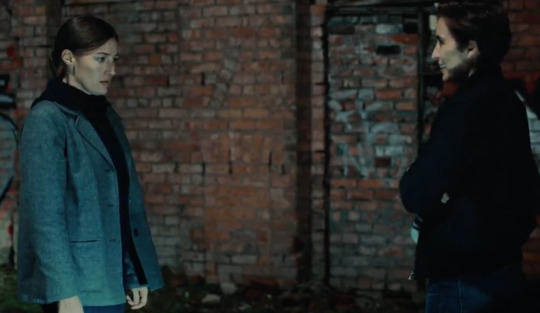
"Why would she come here otherwise?"
Sure, Jo is playing down her relationship with Kate for Ryan’s sake, but it isn’t quite that simple. Jo doesn't want to believe Kate had any faith in her. She wants to believe she was pretending, because she has no faith in herself. Her reaction does provide enough of a distraction for Kate to be able to pull her own weapon, and the most tense standoff ever begins...
One of the most key color choices of any outfits so far on the show are the clothes Jo and Kate wear to the lorry park where Jo sets up Kate to be killed by Ryan. Jo is wearing her grey coat, a blue sweatshirt, and a red top. Kate is wearing a blue coat, and a blue striped sweater with a band of red in the middle. These two outfits are ultimately the thesis statement between these two women. Jo is wearing red as her last layer, the one closest to her, but is surrounded by cool tones through her sweatshirt and coat. Meanwhile, Kate’s sweater has a stripes of red and orange surrounded by shades of blue.
But it doesn’t matter that Kate is being visually connected to Jo, because Jo is about to be responsible for her death via Ryan ‘the bent bastard’ Pilkington.
EPISODE 6
Nevermind though, no death for our beloved Kate!
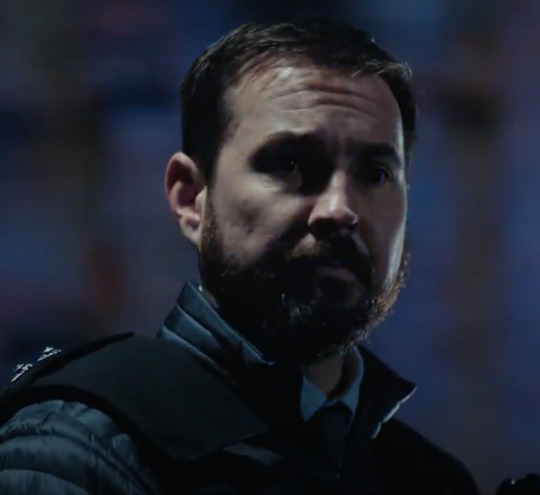
Now, I’m going to take the next parts of the episode slightly out of order in order to tackle Kate and Jo together before their ultimate confrontation with Steve and AC-12. First, a run down of the AC-12 crew: Hastings is in full uniform, which represents his ultimate faith in the system, despite the bad actors and groups that try to destroy it. Carmichael is wearing a grey coat, aligning her with anti-corruption, but it’s piped along the edges with red, which shows how she’s opposed to AC-12 (though not necessarily corrupt). Steve is in his classic blue on blue on blue under his body armor, which shows his dedication to justice and also his faith in Kate. Carmichael confronts him directly about Kate’s whereabouts, which he fastidiously denies having any knowledge of, but unfortunately Hastings is forced to admit that Kate was permitted to carry a concealed firearm for safety. Steve doesn’t trust Carmichael, and this is shown back at the office when he tracks what Patty C is up to, mobilizing Hastings when she’s on the move.

At first glance, Kate and Jo’s red and blue outfits read as a visual metaphor for AC-12 closing in on their location, but I posit that these outfits are also indicative of Kate's belief in Jo, despite her anger that Jo has just set up her death. It’s clear at this point that their simple flirty banter from the beginning of the season has evolved into a deeper connection, which is part of what makes Jo’s betrayal so painful - Kate has been on her side the whole time. Jo just didn’t know it. [note: wrote this before the finale so guess who has egg on her face now…]
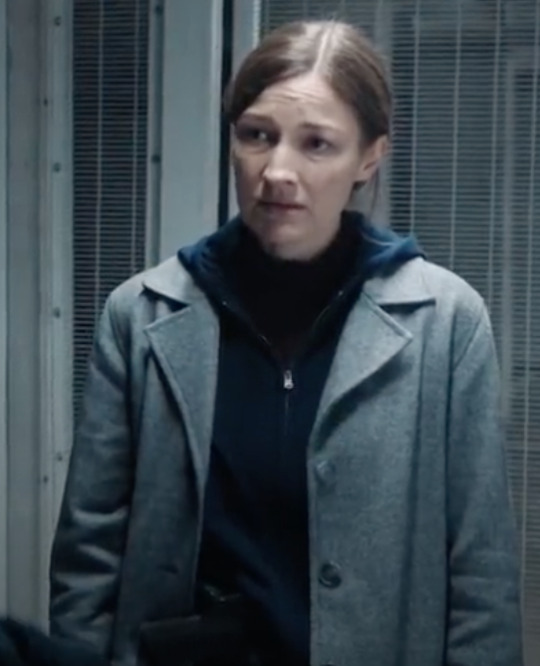
After a time jump (of nearly two hours, based on someone else’s analysis of time stamps and radio calls), Kate and Jo arrive at Steve's apartment. Jo asks if Steve can be trusted, and Kate leaves no doubt. Jo also asks why the surveillance got pulled, and Kate informs her about the chief and Carmichael. Jo denies having any part of it, but Kate isn't sure if she can believe her given the whole, you know, attempted murder thing. In a desperate bid to prove her loyalty to Kate, Jo asks for her gun, intentionally putting her prints on the murder weapon. Again, their coordinating outfits are the outward manifestation of their connection. Kate, while still angry, seems to accept what Jo is offering to her, but is clearly trying to maintain distance in the moment.
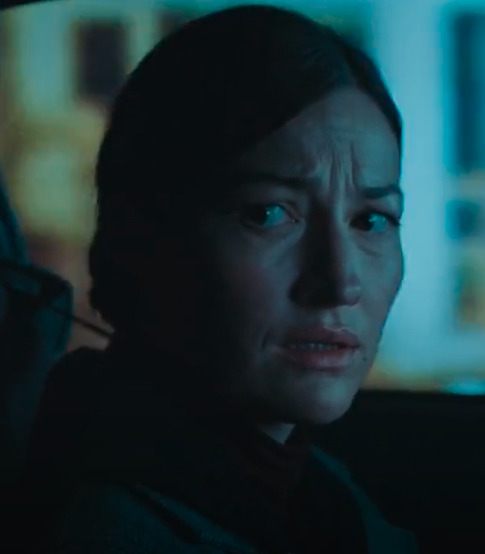
Jo then tries to see if things between them were real, but Kate refuses to entertain the conversation. What Jo is completely unaware of at this point is the lengths to which Kate has gone to prove that Jo isn't bent, up to and including risking a crucial raid on the OCG workshop. To Kate, it's a question that doesn't need to be asked, [the egg on my face remains] but Kate is also in disbelief that Jo would question her feelings when she's the one who was nearly killed by Jo. It’s an inappropriate time to have this discussion, and Kate lets that be known. They find Steve's personal car, a slate grey Mazda because this show is nothing if not subtle with its vehicular choices - even their personal vehicles tie in to their allegiance with AC-12’s mission.
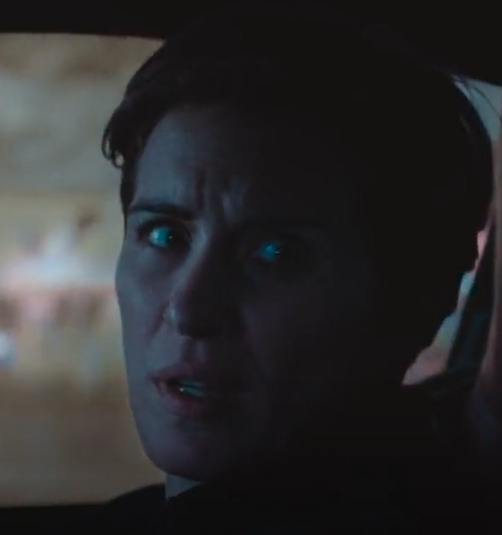
Driving in Steve's car, Jo asks again if Kate was pretending with Jo, and Kate diverts the conversation away from herself. Was Jo lying to her when she hired Kate because she was ex-anti-corruption? No, she was hoping Kate, with her anti-corruption background, would stop her. Would save her, really. They discuss Jo's ongoing work for the OCG, and Jo's fear that she'll be killed if she turns, just like Tommy. She insists that she's not bent and Kate implores her to prove it.
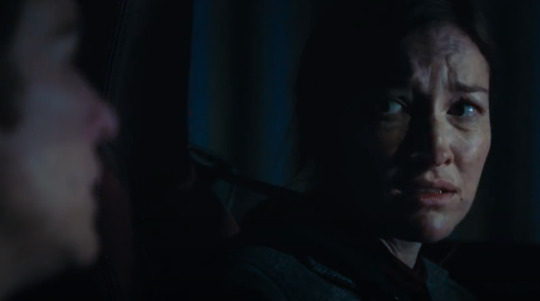
Kate is pissed [for the non-Americans, she’s very angry, not drunk…] in this scene, as she should be. She believed in Jo, she still believes in Jo, but she betrayed her in a major way. And now, when Kate is sticking her neck out for Jo again, she's still too scared to reveal what she knows. Jo does reveal that Tommy was her uncle, and that her father was a bent cop, which of course doesn’t align with what Kate knows. At Kate's further insistence, Jo directs them toward Gail Vella's house, and finally to the old print shop the OCG had used in the past that is across from Terry Boyle’s flat.
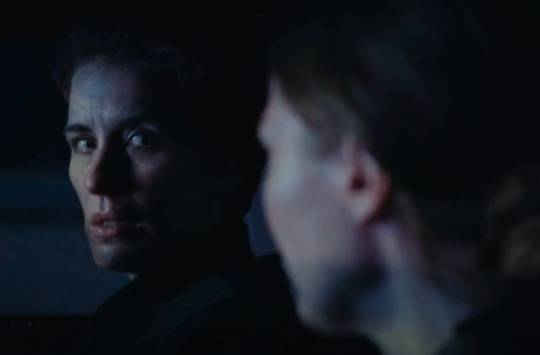
Kate and Jo arrive at the print shop, and Jo is finally about to reveal the truth to Kate. This act, coupled with putting her prints on the gun, earns Jo back a little bit of the trust she lost, and this is shown when the two women share the same shot. Most of the scenes between Jo and Kate have been over the shoulder shots where one woman is the primary focus, and this scene pivots to end with both of them together as the focus. This change happens in time with Kate dropping some of her much-deserved hostility toward the other woman.
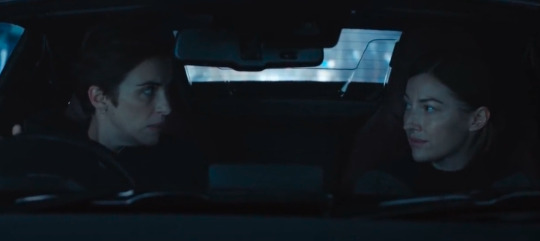
But before they can step out of the car, flashing lights and sirens appear behind them - they've been found. The fact that they've been tracked shocks Kate, but she spends no time dwelling as she throws the car into drive and speeds away. AC-12 AFOs have set up an intercept point, which Kate ignores in a truly badass handbrake turn, no matter if it makes any sense that they could have possibly known the route Kate would take in order to set up a kind of road block.
Handbrake turn or no, the Mazda has been intercepted and Kate and Jo are stuck. Kate is still confused that they've been found, but Jo knows the jig is up and tells Kate she's going to say she forced her to drive. It isn't until Jo tells her they have no other choice that Kate gets out of the car. Once out, Jo puts her hands up, but Kate refuses. Just then, AC-12 arrives with Carmichael, and Kate is in shock. "Jesus Christ, Steve's in on it" - cut to Jo's panicked face. This is the man Kate said they could trust, and now he's after them too.
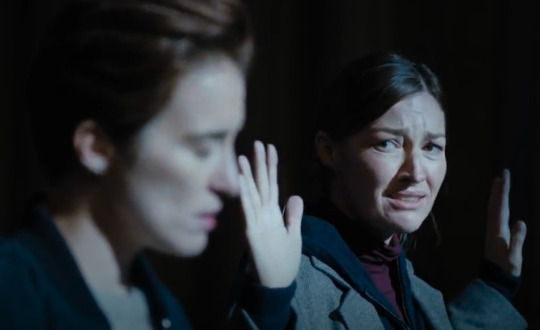
What follows is a very tense standoff between the two fleeing detectives and AC-12. Jo surrenders, but Kate refuses. First Carmichael tries, then Hastings (at which point Kate tells Jo she learned some shady stuff about him), and then finally Steve walks up to them. Jo begs Kate to surrender repeatedly, but the DI believes she’s onto her second major betrayal of the night and she isn’t willing to give in that easily. She thought she could trust Jo, and she nearly killed her, and to her mind she trusted Steve and he turned her over to Carmichael.
Kate is prepared to tear him a new asshole, but he swears up and down that he has no idea how they got tracked, he wouldn't do that to her. Once he promises to get the two women into safety, Kate surrenders. As he walks them in, Kate shared Ryan's confession of murder and Jo's clue about the print shop. To the end, Kate believes in justice and will pursue it.
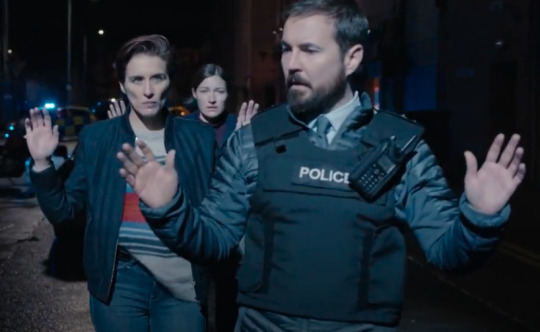
We then see a disillusioned Kate in her all grey Fruit of the Loom being walked into her jail cell. She sits down on the plastic mattress, looking at a total loss.
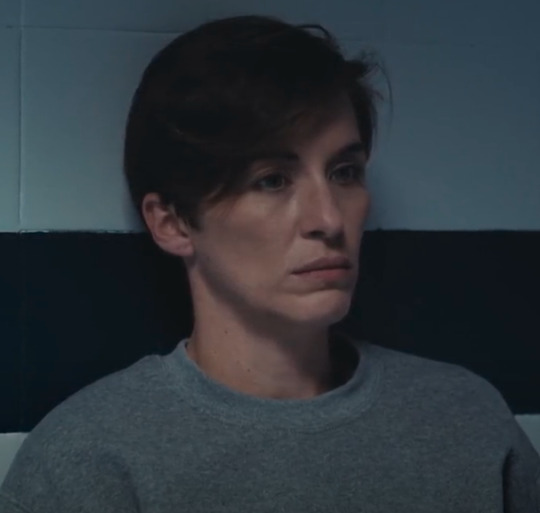
Later that night, Steve and Hastings are discussing the events of the previous few hours. Steve is in a grey suit with a blue shirt and tie, same as he had been wearing during the chase. The gaffer questions why Steve didn't tell him about Kate, and Steve claims it was to prevent putting him in a difficult position with Patty C, who walks in with the same question. Apparently, the former partners have keys to each other's houses and vehicles, in case of emergency. Carmichael taking Steve's phone would've read to Kate as an emergency. Steve refuses to back down, and she appears to drop it for the moment.

Now, onto Jo’s interrogation. A lot happens in this thirty minute scene, but to boil down to the important points: Jo is wearing her best Fruit of the Loom, stripping her of her identity and any affiliations she has. The lighting in this scene is cold and sterile, completely cool in tone. Steve sits with Carmichael and Hastings on the other side of the table, dressed in a navy suit, white shirt, and red tie.
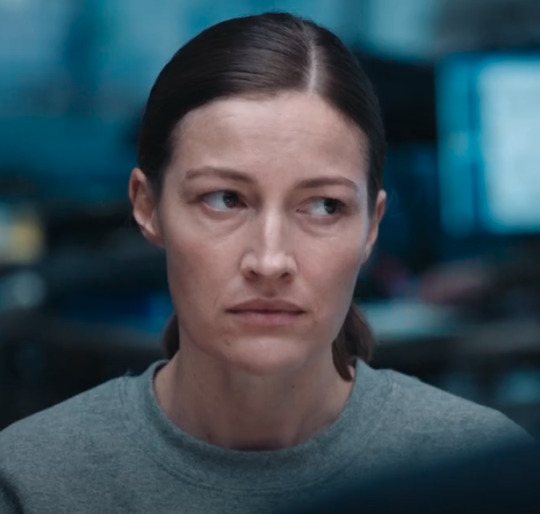
Something very important to note in this scene is Jo’s reliance on Steve. He speaks with her gently, acknowledges her pain, and encourages her to be truthful even when it is clearly very difficult. She takes Kate’s trust in him at face value and decides to trust him too. His outfit actually reflects this truth. He’s wearing the same red and blue that Kate and Jo wore while they were on the run - blue surrounds the red. As much as Jo is trusting Steve here because of Kate, Steve is being kind to Jo here for the same reason. His partner and friend does the right thing nearly always - if she was willing to go to these lengths to defend Jo, he owes it to her to learn the truth. Nothing exemplifies this more than when the conversation turns to Pilkington’s death.
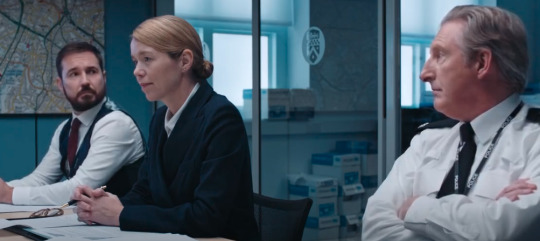
Jo refuses to answer at first and actually waits for AC-12 to show its hand first. She notices that Steve hesitates when Carmichael instructs him to talk about the evidence regarding Kate's gun, and she realizes this is her in, this is how she can prove herself to Kate once and for all. It's only after this that she claims to have shot Pilkington and completely shifts the blame from Kate to herself. This catches both Steve and Hastings up, and they react in obvious shock, which changes how Hastings treats her through the rest of the interview and cements Steve’s belief in Kate’s trust. Afterwards, she looks to Steve, who nods. He understands what she just did for Kate, and Jo is relieved to see his comprehension. The questioning continues, and Jo only admits to what she can take direct responsibility for, but nothing that involves the larger network.
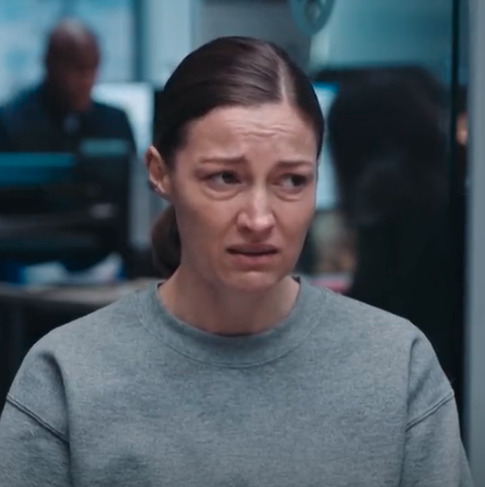
Once Carmichael and Hastings leave, she quickly turns to Steve and says a desperate "I'm so sorry." Sorry for hiding evidence in Operation Lighthouse. Sorry for framing Farida. Sorry for what she’s done to Kate.
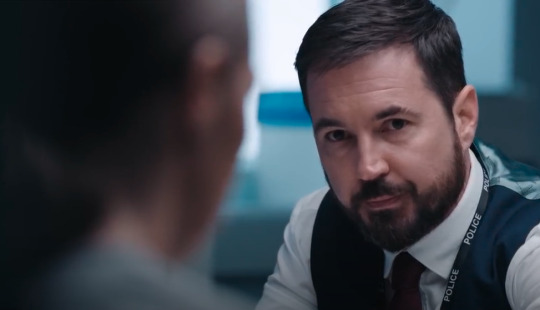
And Steve, gentle when he can be, gives her a kind "Yeah, me too," in reply. I’m sorry you were groomed into the OCG. I’m sorry you were scared for your life. I’m sorry you hurt Kate, too.
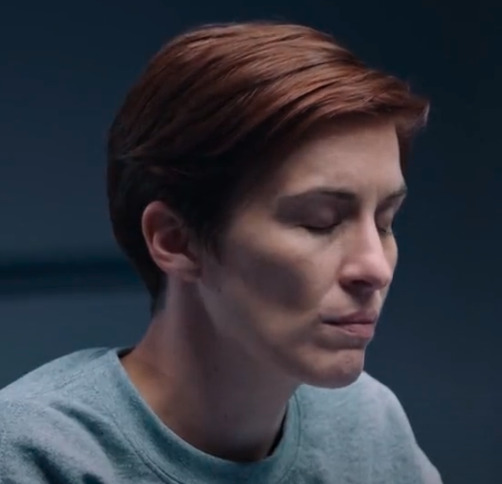
Patty C goes to talk to Kate, and lets her know she won't be charged for Ryan's murder - Jo will be. Kate has a look of relief on her face as she processes the information. But Patty C notes Jo isn't firearms trained, and Kate is. She's telling Kate she knows what really happened, and she's letting it slide. This time. Kate is well aware that Carmichael isn’t stupid - she knows Jo was lying and is only letting Kate get away with it because it better serves her interests. Kate is free, and she sighs with relief and the knowledge of what Jo did.
Steve, still in the same outfit from the interview, and Kate, in a navy pea coat and yellow sweater, meet in an underground car park. once she's been released. A quick note on Kate’s coat: I’d love to say there’s a deeper meaning for the shift in her coat, but I genuinely think it’s just because filming was originally in the spring, then was moved to the fall and continued until November, so it was simply colder. The cut and color of the coat are generally the same, despite the style changing.
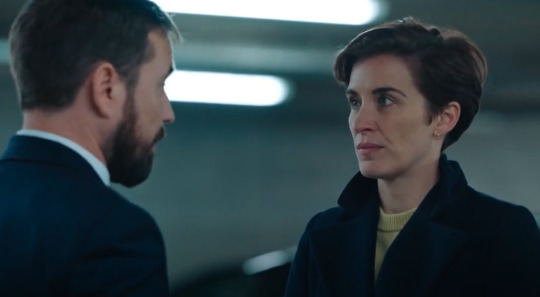
Steve offers to lend an ear about the shooting, and then Kate asks about Jo's interview. Steve tells her they didn't get enough information out of her, and Kate tells him that Jo told her that her dad was an officer. "She's scared, Steve. After what happened to Tommy, Dot, Lakewell, nevermind John Corbett". Kate’s anger seems to have dissipated at least a little at this point, because here she is, defending Jo by explaining why she wasn’t forthcoming with a lot of information. This is most obvious through her yellow sweater - still affiliated with Jo, even through everything else. Steve lets her know that Jo is in a secure cell with extra monitoring, which seems to appease her. Kate then informs him she's been made SIO at MIT, and will guarantee cooperation with AC-12. Lomax calls Kate, and the two partners are back working together.
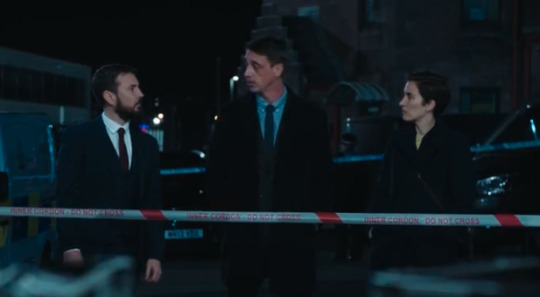
Kate and Steve meet Lomax at the OCG workshop, where he goes over the forensic findings so far as MIT’s resident plot reciter. Kate tells him they need to look further, and orders him to dig up the floor, ruining the poor man’s plans for the evening.
Chloe calls Steve with an update on Thurwell. Then we get a weird scene of darkvision Spanish police apprehending Thurwell. Truly hate it. He's dead. It's a deadend. Clever writing, Jed.
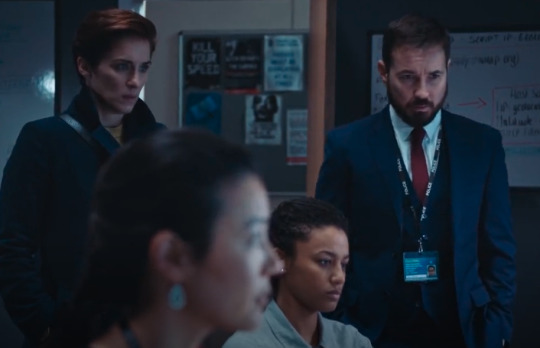
The episode ends with Jo in her navy blue jumper being put into her cell at Brentiss. Tweedle Dum and Tweedle Dee, Lindsay Denton’s besties, walk up threateningly before Jo is led into her cell and the door is shut. I do love the shot here of Jo through the door, caught in a small tight space that’s almost closing in on her.
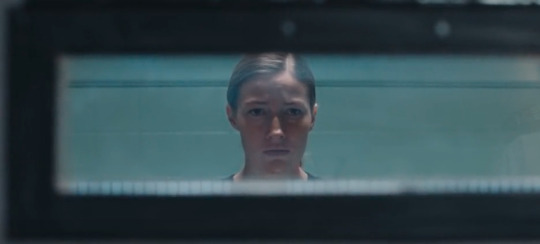
EPISODE 7
Before I fully jump into Episode 7, please be aware that I am doing a textual analysis. I’m not going to go into the fourth man reveal and its logic or even greater meaning (particularly because I’m looking at this show from a different political context as an American), and I’m not going to speculate on things not seen, at least in this analysis, because the focus is on wardrobe. You can trust I have many thoughts, particularly around race and the writing around female characters, some of which I’ve included but most of which I did not. It took me 9 full days to write everything for this one episode, and was shockingly exhausting. Forgive me if it doesn’t live up to my other ramblings.
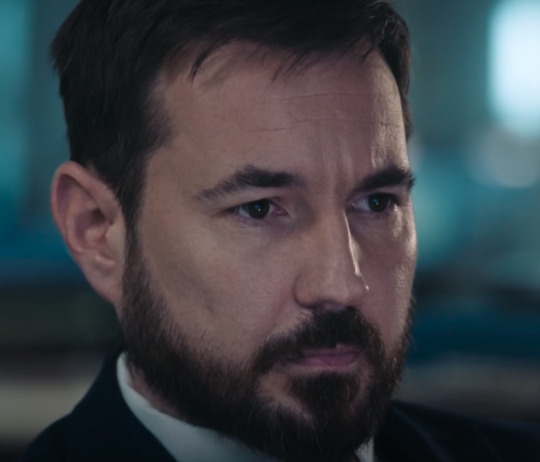
We’ll jump right into things. I'm gay but Steve looks so good here in his AC-12 uniform. Anyways, Steve is watching Hastings' old interview with Carmichael about Ian Banks. His concern about Hastings is clear. He’s in pursuit of justice, even if justice puts him up against the gaffer.
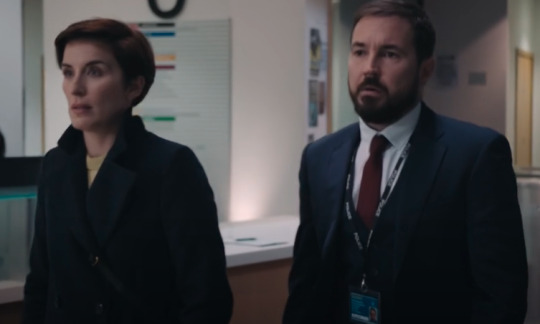
Later, Steve and Kate discuss the gaffer and his suspicious behaviour, and he informs her that Ted is slated for retirement. Steve wants to let it go, but Kate refuses. She asks if Steph Corbett knows anything more, and suggests she may be blackmailing Hastings, but Steve is dismissive of it. This causes Kate to raise an eyebrow - oh god Steve's done it again. Steve pleads "It's not like that, mate, it's different," and Kate has never looked more disbelieving and annoyed. She responds, "She's a person of interest,” and their conversation is cut short when Chris calls Kate with an update. Steve is still in his navy suit, and Kate in her yellow sweater. The lack of coordination in these clothes show Kate isn’t quite on the same page as Steve yet, but they’re getting there.
Lomax tells them there was a case found in the floor of the workshop, much like the one holding Gail Vella's computers at the abandoned print shop that Jo led them to. No comment on the OCG’s evidence techniques.
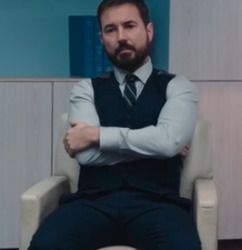
Steve, who kept skipping his occupational health warnings, is in therapy. I didn't cover the OH stuff throughout this analysis since it didn't relate to Jo, but this manages to tie in later so here it is now. It ends in him agreeing to temporarily give up his firearms license. I'm not going to discuss the rest of the meeting, given that Steve seemed to kick his pill addiction and reliance on alcohol and pain relievers to deal with his back pretty damn quickly and it's a storyline of entirely no relevance except as something Ted holds over Steve in a moment of manipulation later. Steve also admits this to Hastings before Occupational Health can tell him. This entire storyline is frustrating. Moving on!
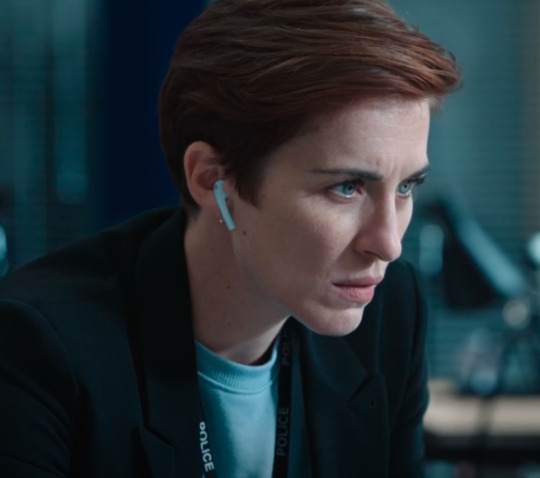
Kate is watching Jo's AC-12 interview at her desk on the Hill, specifically rewinding to parts concerning who Jo believed her father was. She pauses it on a frame of Jo’s face, the terror clear. Kate is dressed in a black suit and a light blue shirt, back on the side of AC-12 and in pursuit of justice, not only with regard to the OCG, but for Gail Vella and Jo.
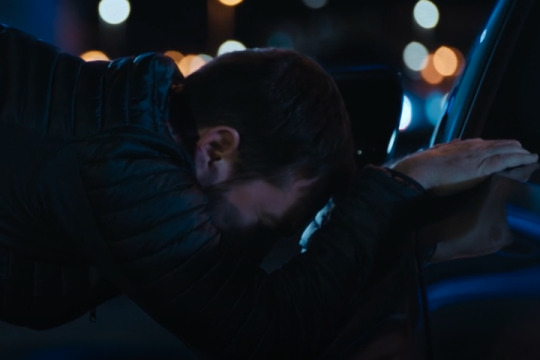
Steph calls Steve again, and he ignores it, because he's being a bit of a dick. Then he steps out of his car and has a back spasm. This only comes up so Kate can ask about it later and show that Steve, wearing a blue jacket, listened to what she said about getting close to a person of interest. Would truly love to know why Steve parks by an underpass by a river for this scene, but needs must, I guess.
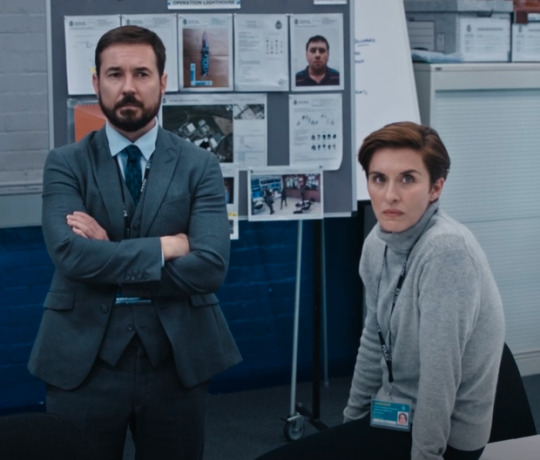
Back at Hillside, another Lomax briefing! Because Chris, Chloe, and sometimes Kate are truly the only people who do any detecting in the entire series!!! Anyways, Chris tells Steve and Kate about the contents of the box under the floor of the workshop. Conveniently, it held four murder weapons (can Jed Mercurio spell deus ex machina?) and neatly tied a bow on Corbett, Bindra, and Vella's deaths, and in a nice series 1 throwback, Jackie Laverty's murder! Kate is wearing a grey turtleneck which coordinates beautifully with Steve’s grey suit, blue tie, and blue shirt. This shows that they’re back on the same page and on the same team, despite their ups and downs this series.
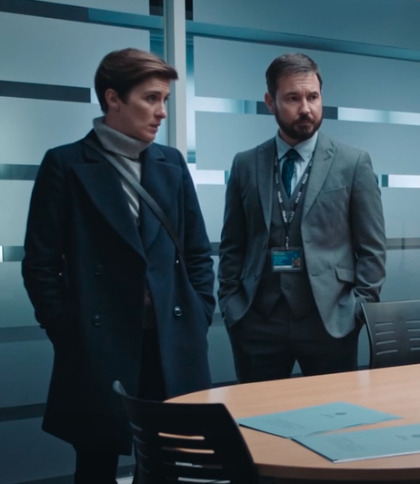
Kate and Steve return to AC-12, where Kate in her new navy pea coat shares that the proceedings against Terry Boyle will be stopped. Except, to my knowledge, Jo already handled that...? They literally made a point of it in her interview. Anyway, Chloe, like Chris, did all the detective work and tells them that the IP of the OCG laptop is in the UK, not Spain as previously believed. Amanda from forensics, the only other person who does any real work, interrupts with a message that shows Jo is about to be targeted. Definitely is spelled wrong. I give up. They feel the need to spell out what JD and BP mean, but spend 3 episodes never explaining what a CHIS is. Sure. Chloe is tasked with finding the fourth man via spelling.
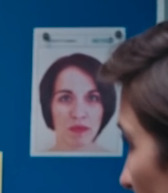
Also I'm truly not being funny by why is Kate on the investigation board in AC-12. Like. What. Was she a suspect? She’s not with the other victims!
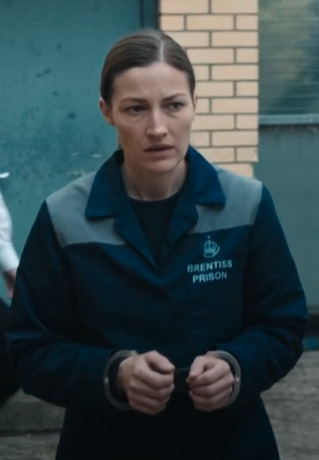
A very forlorn Jo in her blue Brentiss jumpsuit is sitting in her prison cell before being collected for transport to Hillside. Jo is very aware that something must be wrong because she’s a damn fine detective. She's mad suspicious as they head out to the van, and lo and behold, Tweedle Dee and Tweedle Dum are on the transport team.
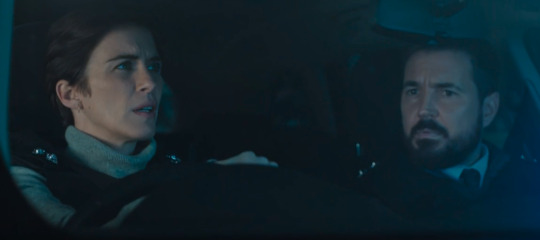
En route to Brentiss, they learn that Lomax and Kate's signatures were forged on the production order for Jo. Meanwhile, Jo is too smart for her own good, and questions the guard during the transport about the requesting officer. Tweedle Dee plays dumb.
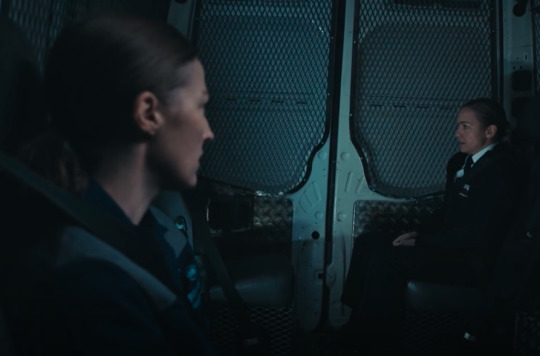
And then… nothing happens. They intercepted the van in advance, removed Jo, and planted Steve and Kate on the van. Because Steve is such a great choice what with his being an UNARMED OFFICER AT THE TIME. They arrest everyone. Steve ends up with a gun. Ok.
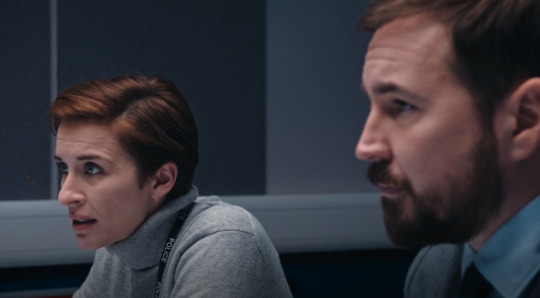
In an interrogation room, Kate and Steve explain what happened to Jo. Hastings looks on. Kate tells Jo she can apply to witness protection, and that all of her notes will show that she was under coercion from others, giving her a shot at the life she never had, but only if she reveals who the top man is, aka her father. Jo begins to cry, and Steve reminds her those OCG men were sent to kill her - this man doesn't care for her. Jo begins to tell them that she had no reason to believe Tommy was lying to her, all while speaking only to Kate. Steve encourages her further, telling her she's not bent. Kate asks her one last time for the name, and we see Jo resolve to say something before the scene cuts. Heaven forbid we show something happening instead of faking built suspense.
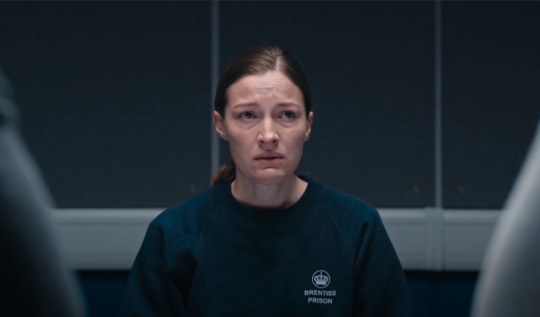
Now, I need to pause here for a small moment of rage. Kate should have been the one who got the call back line by telling Jo she's not bent. Not for any romantic reason, but because their little run from the police stunt was done at least in part under the auspices that Jo could prove to Kate that she wasn't bent. In fact, Kate pleads with Jo to do so. It's just frustrating, and gives Steve an emotional beat he hasn't truly earned with Jo, or at least hasn’t earned as much as Kate.
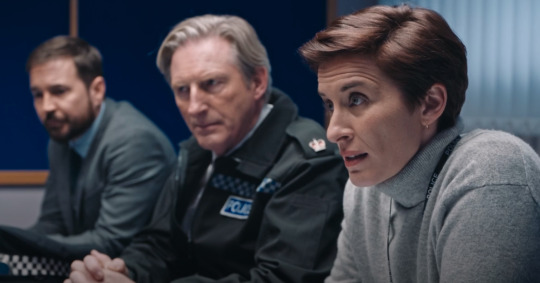
And Jo gives them a name! They search a prison cell, and find nothing. It's really built up to seem like it's Fairbank, who is revealed to be a confused old dude. Why Jo thought she was communicating with him this entire time is simply never addressed. Whatever. They ask about the murders and cover ups, and he offers nothing. Kate asks about Jo, and after some more pushing, Fairbank implicitly agrees that he and Tommy Hunter convinced Jo he was her father. Hastings is pissed, but Chloe calls to save the day (again).
Chloe "I should be Chief Constable" Bishop brings the team up to speed on the text search for incorrect spellings of the word definitely. Which they've apparently managed to do in a matter of hours, even on handwritten reports from 17 years prior! Because Jed has definitely never needed to do a text analysis by hand before. They then proceed to NEVER NAME THE SUSPECT. FOR 1 MINUTE AND 10 SECONDS.

Oh but don't worry, because this is the perfect opportunity for our realigned partners to confront Hastings about the bribe money and his conversations with Ian Banks. Can't reveal who the fourth man is when the head of the investigation is also a bent cop, silly audience. And it's revealed that Ted leaked Corbett as a UCO because of Corbett's role in the attack on Hastings' wife. But it's okay because he's sorry about it!
To be hella clear: Hastings, an anti-corruption officer who prides himself on following the letter of the law, took actions he knew would result in the death of John Corbett and Kate later forgives him for it. Jo was under threat of death from the OCG and tried to get rid of Kate via transfer and then led her to an empty lorry park to be killed while she thought Ryan was under surveillance that could likely intervene, and we in no way see Kate react to that experience in this episode. Cool!
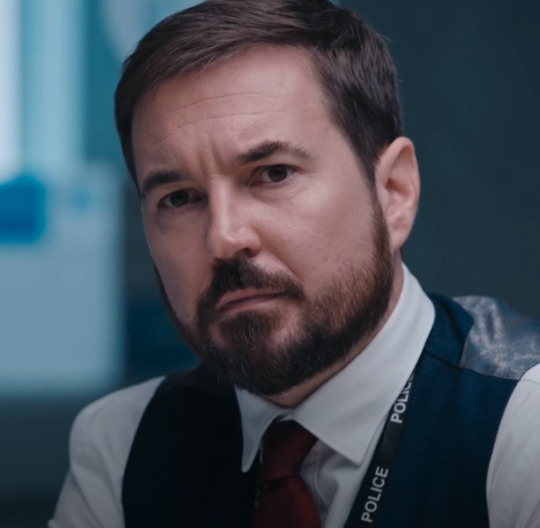
Finally, we get the interview with the fourth man, which is revealed 8 minutes and 32 seconds after the characters themselves learn the information. For some reason unknown to God or man, Kate is there despite not being involved in Buckells' case since she works for MIT, not AC-12. Frankly, not gonna delve into it. Kate is wearing a sweater we've yet to see her in, a blue crew neck that is frankly more feminine than anything we've seen this series so far, and moreso matches what she's worn in previous series. It’s unsettling. Steve is in his classic AC-12 uniform.
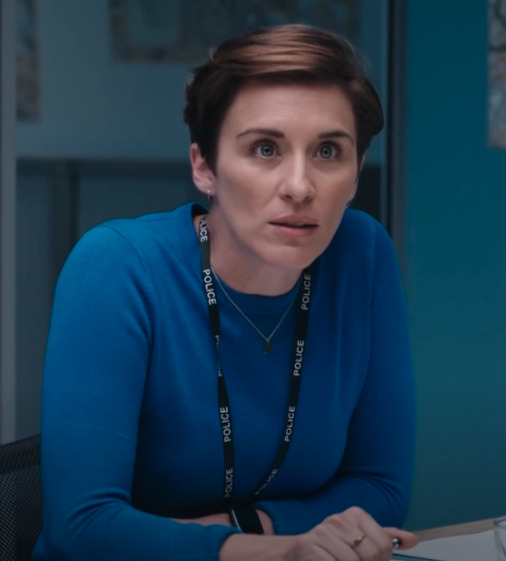
Just a quick q for the kids at home - if Buckells only ever communicated with people via a secure browser on burner devices, how in the hell did he get a laptop in prison? Also, why did he not break himself out of prison by having someone else plant evidence of some kind, especially since he supposedly had a lot to blackmail Jo with?
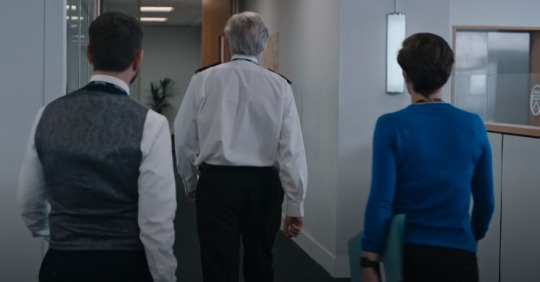
At what I can only assume is their local, Steve and Kate congratulate themselves on doing nothing beyond sit in interview rooms to catch Buckells. Kate might go back to AC-12 - even though she left because of the gaffer's actions which turned out to be WAY WORSE THAN SHE PREVIOUSLY BELIEVED? Sure, Jed. They have a chat about what's been happening with Steve and his painkiller addiction. Kate implies he should drive up to Liverpool to see Steph, which he doesn't think is a good idea. But don't worry, they've got each other, mate. Platonic soulmates forever (no romantic underscoring in this analysis).
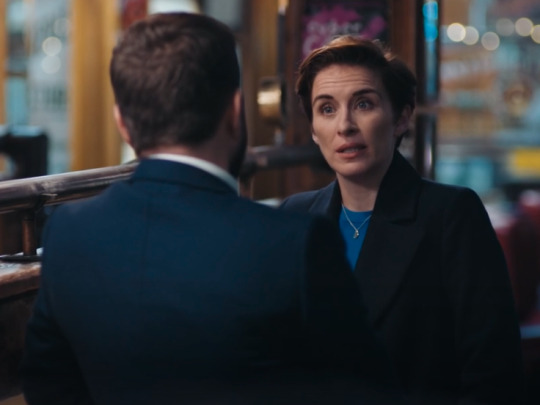
And then, with no previous discussion in the script or even telegraphing by the camera, Kate is in therapy. Which is great, because she truly needs it, girl has been through a lot. She mentions her ex, and Josh who is apparently her reason for living but she's texted about him once and mentioned him offhand to Jo to tell her he'd be with her ex, and then her great friend and partner, Steve (which is true, but the romantic framing is gross and out of character).
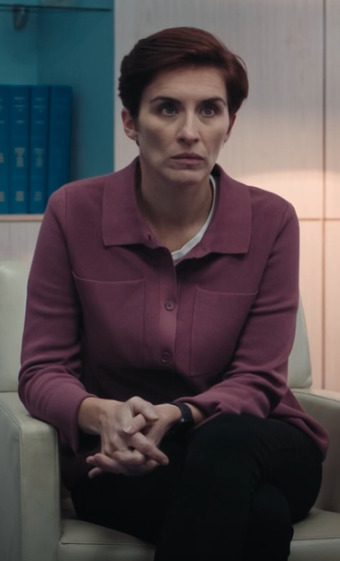
Not being funny, Kate is wearing a truly horrendous mauve top here, over a white shirt. We've never seen her in a color like this, it doesn't fit in with the rest of the color palette in her wardrobe, up to and including all of the orange and brown she wore at MIT. It's honestly frumpy, and in no way aligns with the characterization shown to us through her wardrobe in the rest of the series. The last time we do see her in an outfit like that is during the interview with Jo. Jo left and took Kate's excellent sense of style with her.

Kate and Steve meet with Patty to discuss Darren Hunter's involvement in the murder of Lawrence Christopher, and discuss how there's more corrupt officers to be uncovered. Patty C isn't gonna do anything about that tho. Hastings strolls up to chat with Patty C, and we learn that Buckells will get immunity. The trio are about to leave when Ted storms back into her office to confess to his actions leading to John Corbett's death. He gets one more speech about carrying the fire and bad apples in policing before they all leave.
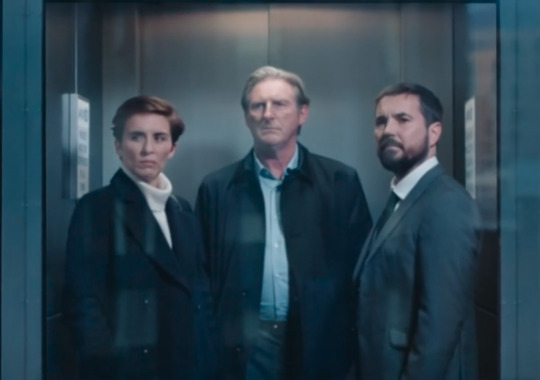
For the final outfits we may ever see them in, Hastings is wearing a blue shirt, Steve is wearing a grey suit, white shirt, and green tie, and Kate is in a white turtleneck with a navy pea coat. Again, this turtleneck is more effeminate than anything we’ve seen her in this series. Hell, even Patty C is wearing blue to show she’s aligned with anti-corruption and just kind of a bitch, not actually corrupt.
Finally, to the blessed epilogue. Shoutout to Terry and Farida for getting some closure to the bullshit they’ve been through.
Jo steps out of her little stone cottage in the country, dressed in a casual sweater of grey and blue, breathing in the fall air deeply. Her layers of clothing are gone, her hair is down and soft. Her Icelandic sweater shows that she’s finally free to honor her heart, and no longer feels trapped by her family and who she thought they were.

And then, a dog trots out after her, and we see Jo bend down to hug the retriever and kiss its head. This is the most free affection we have ever seen Jo give. A set of legs appear in the doorway behind her, and a redheaded woman steps out of the cottage to meet Jo and the dog. Jo smiles at her, oh so freely after the tension she carried for 21 years, and they clasp hands, walking down the country road away from their home. Because Jo is free, and she can freely love and live without fear in her new life.

Now, from a purely logistical standpoint, very little affection between anyone could be shown from episodes 3-7 because of COVID filming protocols (which seem to be far more strict on physical distancing than American and Canadian productions). The production team actually did a brilliant job using forced perspective and interesting over the shoulders to make people seem like they were closer together than they were. From a film nerd perspective though, they broke the 180 rule so frequently that I nearly lost my mind (glass boxes are great but they ignore all rules of perspective).
All that aside, the logistics of filming in COVID mean that moments where we do see physical distancing broken are all the more important. Kelly filmed this scene with an actress who she has not been working with for months, because it is so, so important to see Jo come out of the other side of her tragic life intact. It also matters that her partner is wearing a warm hat and has red hair (intentional casting or otherwise) and that their home has a red door, because it shows that those warm tones represent something different for Jo now. They don’t represent fear and betrayal and being trapped - now they represent home.
Additionally, there are a lot of comparisons made between Jo, Dot, and Ryan. All three had been groomed by Tommy Hunter since childhood to work for the OCG, all three were put into the Central Police to act as inside men, and all three committed terrible acts in their own interest. But there are differences here. Ryan was a little shit as a kid and he clearly had a terrible home life - his mom was the worst. He gravitated to an authority figure who offered him something different and who gave him power. He is a victim of circumstance - but he also found power and enjoyment in his terrible actions. He gloated about Maneet Bindra and John Corbett’s deaths, and he enjoyed wielding power over Jo when he was threatening her.
Dot is the blend between Ryan and Jo - he too was groomed by Tommy to enter this world of crime, and did many awful things without regret, including killing people who threatened to expose his identity as the Caddy. It’s not until his friendship, and burgeoning relationship, that his behavior changes. He almost gets away from the Central Police, despite Kate hopping on a lorry for a free ride to track him down, but when faced with the reality that this would mean Kate’s death, he sacrifices himself and gives her a final clue to dismantle the OCG within the police.
Jo, from what we’re shown, felt regret after everything she did, and the show made it a point to demonstrate Jo as a victim of her family and genuine fear for her life if she didn’t continue following the actions of the OCG. We never saw Ryan or Dot with a gun to their head or with a dozen locks on their door. We never saw them break down in bathroom stalls, or even framing people and discrediting them instead of killing them. And it’s ultimately her relationship with Kate that changes things for her - she tries to use Kate at first to get caught, and when they get close she tries to push Kate away in order to protect her, right until she thinks she has no other choice but to let Ryan kill her.
It’s interesting that all three characters meet their end with Kate (and a damn shame the show never chose to address that fully). She quite literally kills Ryan, has a standoff with Dot that ends with him sacrificing himself for her and giving a dying declaration, and goes on the run with Jo to give her time to prove she isn’t bent and who plants evidence against herself to protect Kate. Later, it’s Kate who convinces Jo to give up everything she knows about the OCG and the man who claimed to be her father, and Kate who offers immunity and witness protection. Finally, in their last scene together, Kate manages to save one of the people corrupted under the thumb of the OCG. She completes a task she first set out for in series 1, the first time she interviewed Ryan and tried to get him to realize there’s a better life out there for him.
Kate does what Jo was hoping she would: she saves her, and gives her the life she never thought she could have.
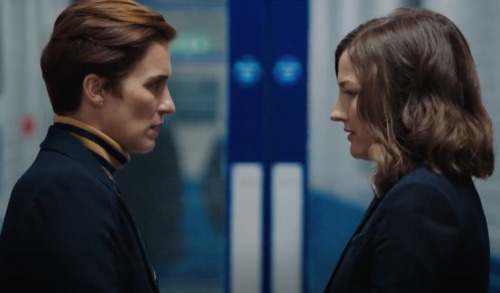
I wish I could end this with a perfect bow that ties the wardrobe threads of this series together, but frankly I can’t. On a macro level, cool tones remains the symbol of anti-corruption and the pursuit of truth and justice, and warm tones represent any force opposing those ideals. On a micro level, Steve’s clothing choices and what they represent remain consistent throughout the series, as do Jo’s. However, the character that ties Steve and Jo together, the person who believed in the truth of Jo despite what face value was saying, that person’s wardrobe gets thrown to hell in the final episode. Kate’s colors remain cool, and it’s understandable that the warm tones that represented her connection to Jo disappear as Jo turns on the OCG, but the actual physical clothing is completely different from what she’s been wearing before and doesn’t fit her characterization.
I think it’s crucial to note that her femininity is only played up when she’s back on a team with men, where her earlier androgynous dress became suddenly unacceptable. It’s a damn shame, because the emotional payoff for Kate’s growth outside of AC-12 could’ve been really spectacular, and she was stymied in the end in favor of her male colleagues.
#line of duty#kate fleming#jo davidson#steve arnott#flemson#kate x jo#lod spoilers#line of duty spoilers#It took me a long time to finish this because I struggled with the absolute 180 degree turn the show took tonally in the final episode#It honestly threw off quite a few of my conclusions#and I had to rethink the analysis#but thank you to everyone who stuck with me#enjoy!
41 notes
·
View notes
Text
Themes in C2, and why Lucien makes for a perfect BBEG.
So, now that we’re coming up on the end of the campaign, I wanted to just talk about some of the themes of campaign 2. The three major themes that I found through out C2 are a group of broken people coming together to fight the whims of fate and becoming a found family, abuse, specifically from family, and fighting back against a corrupt authority. It’s not well written at all, but I’ve been wanting to talk about this stuff for awhile now. Under a read more, ‘cause this is long.
The first point I won’t talk about too much, as it’s literally one of the themes of almost any narrative focused ttrpg game. I will say that while the found family aspect of C2 was handled better than C1, as a result the world of Wildemount doesn’t feel as fleshed out. The MN are a naturally untrusting, and morally ambiguous group and as such, they never really set up roots anywhere. The closest we got was either Nicodranas or the Xorhaus, and those are more places to rest rather than an actual home. This also lead to them having significantly less connections than VM, with their only major allies being Yussa, Pumat, and Essek. They kind of have the respect of the Bright Queen, but that never really went anywhere. Having said all of that, one of the biggest strengths of C2 is that everybody had a well defined and established relationship with one another. Not to take potshots at C1, but some character relations were almost entirely ignored, outside of one quick dialogue between one another.
As far as abuse was concerned, almost every single member of the Nein was abused, with Molly and Cad being the exceptions that prove the rule. I don’t have to talk about Beau or Caleb, as their abuse and trauma was spelled out pretty easily. Yasha’s entire clan ruined her life because she loved the wrong person and forced her to Obann. Veth’s village seemed to see her, and treat her, as an outsider because she liked “weird” things, which lead her to doubting her own abilities and possibly being a root to her alcholism. Fjord had Sabian, the orphanage, and to an extent Vandren. Vandren’s abuse was more of showing toxic leadership to Fjord, which Fjord attempted to copy, up until he realized how shit it was and turned into the leader we saw in those last couple of episodes. And as much as we understand and can empathize with Marion, locking up a child and isolating her from people that weren’t either employees or clients inside of a house, regardless of how gilded it may be, is a horrible thing to do.
I don’t think any of the Nein particularly care for authority, and most are 100% down to topple corrupt regimes if they fuck with them. I remember at least Beau and Jester had specific instructions from the Cobalt Soul and Arty respectively to punish those that used their power for wrong. But even outside of that, Caleb wants to burn the assembly down so it can be remade to be better, Fjord seems to believe in interpersonal hierarchies/chains of command but has no trust in government institutions as shown by his mistrust of the BQ, and complete lack of want to get involved with Dwendalian politics unless they fucked with the Nein first.
As far as Lucien being the BBEG is concerned, I think he represents every one of the themes in a relatively unique way. Of course, they initially found out about him because they wanted to help out Molly, and that’s been one of the main ways they’ve been dealing with his bullshit, both narratively and from the boss fight. It’s also worth noting that he saw the Tomb Takers more as pawns and tools, rather than companions, which spits right in the face of how the Nein treat each other. Lucien’s monologue before he blew up the Somnovem is one of the things that really got me thinking about most of the Nein having abusive parental figures. He mentions wanting to be a parent to the hive-mind, and that just really resonated with me as a horribly shitty thing to do. He also attempts to gaslights the MN, and always pushes the responsibility of his shitty actions against them onto the Nein. The authoritative bit goes with his abusive nature, he’s a narcissist and wants everything else to share in his beliefs and ideals, and will force that on them via Cognoza if they refuse him.
All of this is so completely the opposite of how the Nein operate, that I can’t see anyone else working as a final boss other than the risen form of their old friend, who is pushing for things none of them would want, in a way none of them agree with.
Thanks for listening to me ramble if you got this far.
16 notes
·
View notes
Note
GIRL GGFJFJVGDJD OK UMMM let me see... what do you like about levihan? or do you have any unpopular opinions? or headcanons!
oh boi i hope i won’t rant too much, i don’t want this answer to be a thousand miles long i don’t want to seem boring-
OKAY let’s start
What i like about levihan: i have to start with a lil background a say that levihan is my longest ship i’ve ever had, it’s the only one who survived time and the only ship i have never stopped shipping/lost interest into, which is kinda rare for me since i switch interests a lot and go through hyper-fixations, so i tend to lose interest quickly in something once i’ve found something else to pay attention to
this, however has never happened with levihan: started shipping them when i was 12, still trash 7 years later skdjdjfjf i didnt start shipping them for special reasons tho, at the time aot was my first ever still on air anime and i was completel new to the community, plus i didnt really speak english well and the first episodes i watched confused me A LOT. However, amidst all that confusion and trying to remember names and plot points, episode 9 came, i got introduced to this character who apparently is named levi, the first information the scene gives the watcher is “this guy is a grump” based on his reaction to the crowd, the second information the scene gives to the watcher is “this person next to him, despite him being a grump, isn’t afraid to tease the shit out of him and we still don’t even know their name” which i found ??? Cool??? I immediately paid attention to this lil dynamic, then the next scene was the hairgrab scene and,,,,,, yeah my 12 year old braincells went into overdrive and i was completely sold
i just needed them to interact once and BOOM
but OBJECTIVELY i still find extremely telling, years later, how these were the first informations of these characters. In a narrative, character’s introduction is absolutely crucial to the story, you can understand millions of things just by the way a character is presented and says their first lines and honestly choosing to introduce levi and hanji together was imho very, very telling of what role they’d play in the story/what role they play in each other’s lives.
isn’t it strange that the very first infirmation we get of these two is that the grumpy one is okay with this person teasing him? that means there’s gotta be a level of familiarity among them, right? and the hairgrab? requested by isayama himself? in the official book of season one it also says that the scene was added to “show their relationship”??? i mean 2+2 is 4 where i’m from 👁👄👁✨
so yeah my dumb 12 year old brain had FORESIGHT apparently-
as i picked up the manga and read through the uprising (and got older and my english got better) i noticed more and more things about them and i just really freaking fell in love with their relationship okay it wasn’t “oh cool grumpy and sunshine who teases him”, more like “holy fuck grumpy has a sad backstory, seems unapproachable but is the kindest person ever, just wants to be a hero and save everyone, has the most tender heart, sunshine is a multi dimensional character who has fears and doubts and they work so well together despite being polar opposites but at the same time their oppositeness results in somehow them being completely in sync with each other and almost thinking with the same brain as if they were one person split in half”.
since they’re grown adults and they’re so close, their relationship has something that i always seek and almost never find in other ships, which is emotional maturity. You never see them purposely tearing each other down just to hurt the other, they work out their problems and C O M M U N I C A T E ✨ they don’t act childishly around each other, they tease and bicker but it’s completely different than full blown arguments where both parts disrespect the other just to prove their point. They are willing to listen to what the other has to say and their judgment is precious and welcomed, since the basis of their relationship is complete trust. levi is rough with words, but he means something else entirely despite what he conveys, as seen during the aftermath of eren’s first hardening experiments, and hanji totally understands what he wants to say, which is why they never reprimand him or take offense to what he says.
what i’m trying to say, i believe in a way that nothing is half-assed about how they were written in the story as a pair, despite how i disagree with certain narrative choices *ahem*; as much as i would have wanted them to have more screentime and more interactions, i believe it wouldn’t have been “in character”, lemme explain because i realize it sounds weird and my wording probably doesn’t help: their relationship is subtle and as such it should remain subtle and in the subtext, simply because it is none of our business as readers. Show, not tell, but show in a way that it is evident only if you pay attention. levi is blunt when he speaks, but at the same time his words have another meaning than what he conveys and his actions are subtle.
isn’t it obvious with how often it was remarked that the only person who is able to understand levi completely is hanji? and this is where chapter 132 comes into play with this amazing analysis post that i’m sure we all read a thousand times and screamed over it
all this “ambiguity”, all this subtlety, all this subtext, all this wordplay, words that have more than one meaning, i believe are all indicators of one thing: us readers are not able to understand comple what levi wants to say and his words result ambiguous to us and not 100% clear, simply because the readers are not hanji. but fortunately, i believe that hanji understood that levi too wants to “stay in the forest”. this is not the reaction of someone who is confused by a sentence, this is the face of someone who finally had a realization:

what kind of realization? it’s not up to us to know (tho we know *wink wink*), because we’re not hanji and we can’t understand what levi says.
plus, 心臓を捧げよ, “dedicate your heart”, can hold a million different meanings. 心臓 is heart, を is a particle that denotes the object, 捧げよ is the verb “to offer, dedicate, devote, sacrifice”, there are no adjectives that indicate possession as you can see; levi using his own left (not right) fist and placing it on hanji’s chest instead of just taking hanji’s hand and placing it on their chest is ambiguous too. i interpet it in different ways but the conclusion is one, and i can’t honestly see it in any other way. one of the interpretations i like the most is that levi is implying that they both share the same heart, which is why he used his own left hand, meaning that both of them are dedicating their hearts in that moment to humanity, because they are actively choosing to put their desires aside to live a peaceful life away from everything (as jean too has wished in chapter 127, as hanji has expressed in 126 but in 127 too and jean seems taken aback by their confession) since they’re soldiers and duty comes first.
so yeah if i have to choose something i love the most about levihan, it’s gotta be the subtlety and the ambiguity that at the end of the day, is absolutely not ambiguous at all. everything is expressed for a reason, if an author actively chooses ambiguity, in this specific case of a relationship, he intends the result not to be ambiguous. it sounds like a brain fart but i blame it on my inability to articulate my thoughts well, i hope what i want to say can be understood 😭 and in a way, this can be considered as an unpopular opinion i think?
meaning that i get that commonly someone might want an explicit declaration that leaves no room to doubt and I honestly wish for it too, but I don’t think it would be in character, and the ambiguity (if we can call it that, i’m calling it that just to avoid backlash and controversy jshfsjdjmd) in this case speaks enough volumes to me considering both of the characters we’re dealing with, the story as a whole, the interactions with other characters.
ALSO going back to their bond, i want to copypaste something i posted on twitter regarding chapter 126 and the blush: it doesn't make sense, character-wise, for Hanji to feel in any way embarassed around Levi. They have no filters whatsoever around each other. They are close, closer than anyone in the series, the author hasn't shown any embarassment between them. Back in Uprising, when Hanji was hesitant and wanted out, Levi was the one who encouraged them. So, this thing has in a way already happened, since back then they admitted to wanting to abandon responsibilities to Levi's face and didn't blush. So, in 126's context, it doesn't really make sense for Hanji to blush "only because they were embarassed at being caught wanting to run away". It happened once already and there was no blush. So yeah, the blush means something else. And that something else is definitely much, much, MUCH deeper than "embarassment". 🙌
since smartpass stories can absolutely be taken as part of the canon universe as they’re supervised and approved by isayama and published with the manga, i am adding the rain story as further proof of what kind of relationship they have. also levi being a 30 year old tsundere is adorable but movING ON
SO YEAH MY FINAL TWO CENTS ARE : i love everything about levihan and there isn’t a single thing i would change, because wanting aot to be a huge slice of life of them doing the most random things just to watch them interact doesnt count sjdjfjdjdjfjsmdm, my unpopular opinion is that i find the subtlety and the ambiguity KEY to doing justice to what they have because it’s none of us readers’ business because only they are able to understand each other and i fucking LOVE that, my headcanon is that they totally kissed once during the timeskip, maybe on the first anniversary of the battle of shiganshina, i see them not being able to sleep alone and finding comfort in each other and in a moment of weakness and vulnerability they kiss, but pretend it never happened because things are messy and they can’t afford to get involved because again, duty first, but the YEARNING™️ and the PINING™️ only intensifies after that, but they manage not to make things awkward and they are close as ever.
my GOD i rewrote the odyssey, sorry 😭
40 notes
·
View notes
Note
Top 10 Danganronpa characters
Normally my motto is “No Heroes, Only Villains.” In general I tend to dislike main characters because a lot of authors take short cuts to have the main character feel important, and end up bending the story around them. Whereas while villains are darker characters overall, because the narrative always frames their actions as bad they are usually far more complex characters with deeper, darker, struggles driving them udnerneath the surface.
The one exception to my rule is Uchikoshi’s Zero Escape series, and Kodaka’s Dangan Ronpa series where I usually end up stanning the protagonist. Due to the fact that the objective of Dangan Ronpa is to inflict as much despair on the protagonist as possible, I can kind of see why this series is the one exception to my rule.
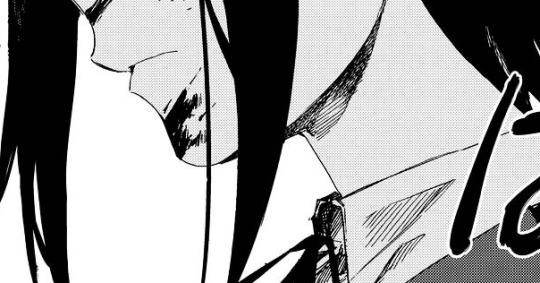
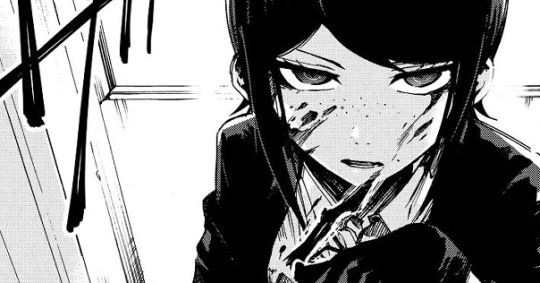
1. Mukuro Ikusaba - “I’m so sorry, Junko. I never really understood what despair was. But it’s going to be all right now. I finally understand. So… I’ll make sure I make you happy, Junko. I’ll make sure I fill you with despair. I’ll save Makoto… I’ll make sure the others don’t die. I’ll let them escape from this place…”
Most of the entries on this list are going to be characters I think have a solid narrative in their game/source material, rather than just picking characters I like. For example I like Tanaka, Mikan, a lot of the characters that fill up the killing game cast are faves however I want to judge them for their arc as a whole. Ikusaba Mukuro is my one exception because she is my absolute favorite character in Dangan Ronpa and she’s one of the most wasted narrative potentials. This likely comes as a result of Dangan Ronpa the original being the worst written game of the three, which lets a lot of its characters including Mukuro go to waste.
Mukuro is a child soldier who’s been trained her entire life. She’s also a victim of sibling abuse, from her only genuine family and the one who loves her. What complicates this is Mukuro is also a bad person, she’s a terrorist who works for despair not because she believes it, but instead to make her sister happy. Mukuro’s lived her entire life to make her sister happy, and her sister loves nothing more than misery despair. You can see where the conflict arises.
Narita’s rendition of Mukuro makes her one of the best characters in Dangan Ronpa. She’s a heartless murderer, but that’s because she has no one in her life except Junko. Of course life is worthless to her she’s never even been shown how to live. When Mukuro is introduced to ideas like love, she’s actually terrified. She’s so scared of other people she considers just talking to people to be worse than taking a shotgun blast to the face. Mukuro’s just so bad at being herself it’s easier to be the doll that Junko plays with. Which is why her turning from despair to hope because of the connections she made with Class 78, and Makoto still believing in her even after she chose to betray them and start the killing game is one of the coolest narrative ideas in Dangan Ronpa. Too bad it only happens in a Ryoga Narita short story.

2. Matsuda Yauske - “Who are you going to report me to? The National Japanese Ugly People Association? That kind of organization would be guilty of discrimination just by existing.”
Matsuda is also a character that could have had greater importance to the series as a whole, but I do think Dangan Ronpa Zero enough to tell his story. Matsuda is an almost perfect protagonist of a tragedy, his heroic qualities are what drag him underneath the surface of the water and cause him to drown. He’s just a kid who wants to protect his childhood friend no matter what the cost. After losing his mother, he made a promise that the two of them were going to spend the rest of their lives taking care of each other and Matsuda does his best to fulfill his end of that promise.
Oh, also that childhood friend is a terrorist trying to destroy the school he is currently attending, and also killing several innocent people and forcing him to hide the bodies. Matsuda is deep down a very good person, but he hides it under his apathetic attitude and his harsh tongue. It shows that good people are perfectly capable of doing bad things. Matsuda knows exactly how wrong his actions are, but he takes them anyway out of desperation. We see him agonize over what he has to do, and then never forgive himself when he does. The rapid deterioration of his mental state because he a doctor, is hurting people, and even hurting the one he loves by protecting her is so compelling. Junko’s claws are already dug so deep into his skin, but he doesn’t want to escape because even with her arms wrapped around her neck at least Junko is still holding onto him.
Matsuda’s a character whose both selfless to an unhealthy extent, and also self-motivated. Junko points this out (helpfully) and his complexity comes from the fact he’s not either or, but both at once. Yes, he’s trying to fix what happened to his mother by fixing Junko’s brain. Yes, he wants to protect Junko because that gives him a place to belong. However, at the same time he is doing all of this because he does genuinely love Junko, and that’s his despair. You can tell despite Ryoko being a Junko who does not care about despair, who is happy go lucky and completely dependant on him like he wants, she chafes him. He can’t stand Ryoko deep down, because he knows Ryoko is not Junko. Matsuda defines him entirely by his use to others and he fell in love with the girl who only knows how to use and manipulate others. It’s a match made in hell.
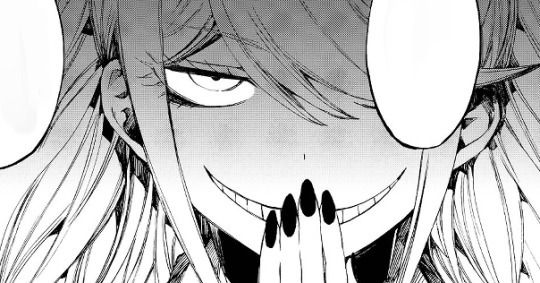
3. Enoshima Junko - Hope is harmony. A just heart, moving toward the light. That is all. Despair is hope’s polar opposite. It is messy and confusing.
The most hardworking character in any story is the villain. Junko defines Danganronpa, Junko practically is Dangan Ronpa. That being said while her appearances in the main games are fun to read, she really shines as a fave of mine in Dangan Ronpa Zero. This is the few times we get a peek at what’s going on inside of Junko’s head instead of having to view from what she decides to show us on the outside.
Junko’s so fascinating because she’s just too smart for the world around her. Her brain’s not broken, it works a little bit too well. She sees no point in making relationships because everybody around her acts so predictably they might as well be playing roles on a stage. Everyone is reading off of a script without even knowing it.
You get the sense that Junko this amazingly talented girl, idolized, worshipped, loved by all, always in the center of the spotlight, just wants any life that’s not hers. Despite having been handed everything she can’t enjoy a single part of life. She has a very “I’m taking my ball and going home attitude” towards hope, if Junko can’t see the appeal of hope, if she can’t enjoy her school life then no one should be able to.
There’s something viscerally pleasing to read in her desire to break the world around her. If everybody is reading from a script then burn the script. If everyone fits too easily into a box then she should destroy all the boxes. Junko herself is more of a personified Jungian Shadow, meant to drudge up the worst parts of society from the bottom of the ocean and make it float and burn on the surface of the water like long buried oil. However, I also find her character to be unique and compelling, not because she’s a psychopath but rather because she isn’t. Junko is capable of loving people, but she’s so bored that you’re guranteed to be worse off if she likes you, because you’re going to be disected while still alive just to prove you’re a living person and not a doll.

4. Saihara Shuichi - “The only time I can use my detective talent is after someone dies… A detective…can’t save anyone. I’m only useful after it’s already too late.”
Welcome to the I-Like-Dangan-Ronpa protagonists list. Shuichi is my favorite protagonist for a main sereis game, because he’s really the only one who has a strong arc through all six chapters. Makoto is the original danganronpa protagonist, but he’s much more interesting when he’s deconstructed by the other characters around him.
Shuichi’s so interesting as a protagonist because he doesn’t always keep on hoping. In fact he gets scared, he runs away, he lies in his bed for days doing absolutely nothing. Shuichi is just as sensitive of a boy as Makoto is, but that emotinoal sensitivity is a flaw because it makes him fragile. Makoto would never give into despair, but Shuichi does which makes him all the more strong for pulling out of it.
He’s timid, easily gets pushed around by others, what makes Shuichi so appealing is because he’s a terrible main character. The game even highlights this in the protaognist swap, Kaede was too strong, and Shuichi too weak to be a lead. There’s even hatemail in the game that’s like Shuichi sucks bring Kaede back and it’s hilarious. He has none of the strength of normal main characters. In fact he’s a walking bundle of nerves and weaknesses. Despite being a detective he’s not even as great as investigating as Kirigiri, and definitely not as cool. Yet, Shuichi struggles so much for every single step in the way. Most of the Dangan Ronpa games end with We’ll keep on hoping, which is a fine message but also pretty generic. DRV3 has the strongest themes of the series and it ends with Shuichi saying I don’t give a damn about hope, I’m going back to my real life. Which is all the stronger because you find out that Shuichi isn’t special, nor was he even that great of a person, he’s just kind of an creepy anti-social kid that sucked. His improvement feels so great because we’ve seen him accept that past self, but at the same time leave it behind.
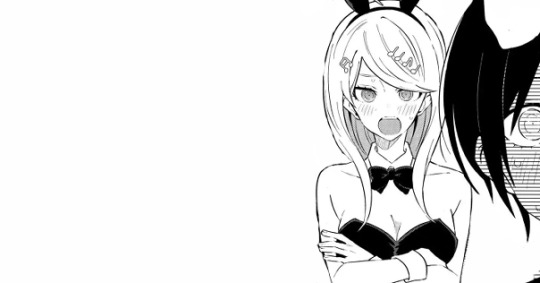
5. Akamatsu Kaede “..And that's why we need to expose the mastermind and end this dumb killing game! So we can smile with everyone else!”
Kaede is also another comnentary on Makoto, but instead of passive she’s active. I’ve always called her an aggressive optimist. Makoto will just be very tolerant of other people, be patient with them, listen to them, whereas Kaede wants to be friends and she will beat your tragic backstory out of you if she needs to.
This is once again a case of a great Dangan Ronpa character going to waste, but the protagonist switch gave us Shuichi so while I’m disappointed I can still live with the choice. What I love about Kaede and Shuichi as dual protagonists is how well they compliment one another. Kaede is friendly and social but she’s not necessarily nice or empathic. Shuichi is nice and empathic, but he’s anti-social and too timid to go out and make friends. I like deconstructions of empathy because Shuichi is kind of too empathic, he’s always so concerned with how others feel he lets his own heart get trampled over. Kaede’s the exact opposite, she’ll trample over other people trying to make them happy because she’s just too headstrong.
She’s a version of Makoto where her relentless optimism, her ability to make friends, both of these things are flaws because Kaede doesn’t really understand other people’s struggles the same way Shuichi does. Which is why both of them shine the best when they’re together because as a duo they really don’t get along that much underneath the surface. Kaede is all about trusting everyone, but in the end she takes everything into her own hands. Shuichi acts like he wants everyone to rely on him but at the same time his self esteem is so low that he wants someone else to come and take the responsibility away from him. Which is why their relationship which seems to be perfectly complementary on the surface falls apart. Another thing I love about the two of them is most of the Dangan Ronpa guy/girl investigation duos are basically the girl just giving hints and being perfectly helpful to the guy the entire time, whereas Shuichi and Kaede both lie to each other while pretending they’re each other’s most trusted person.
It’s a really great arc even if I wish Kaede had lived to see the consequences of the two of them falling apart and failing to trust each other rather than dying.
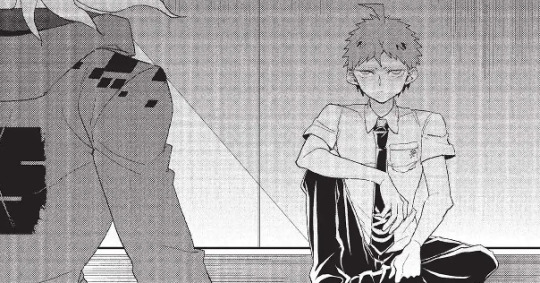
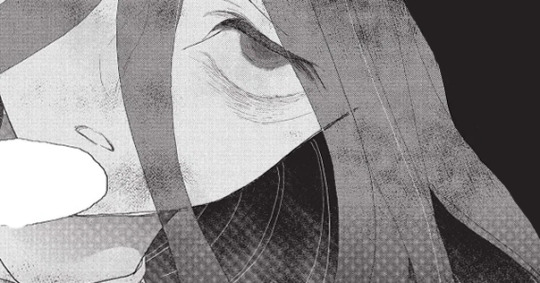
6. Hinata Hajime / Izuru Kamukura “I’m not interested.”
Hinata Hajime is a boring rehash of Naegi Makoto whose only major difference is being slightly more anxious for the first five chapters, and then he becomes one of the most amazing characters in Dangan Ronpa. If you reread SDR2 knowing the Izuru Twist, Hinata’s character becomes a lot more distinct.
The best way I’ve ever heard Hinata described is “Like Makoto, but not genuine about it.” Makoto is just a friendly guy who really likes everyone and really wants to help everyone, he’s kind of simple. Whereas, Hinata wants to be that person really desperately but he can’t. Because Hinata wants to be important. When he helps someone he wants to be relied on. When he makes a friend, he wants them to be an important friend. He wants to be selfless, but he can’t stop thinking about himself for one minute because he’s an anxious mess.
DR3 is bad, but one of the few things it got right was Reserve Course Hinata’s genuine attitude. He seems angry and confrontational, but that’s only because he hates the idea of other people looking down on him. He’s always worried about what other people think of him, so being so confrontational helps him be avoidant. Nobody looks too close if he pretends to have a strong personality.
Hinata is just someone so intensely disatisfied with himself he decided to get a surgery to take his brain out of his head and let him become someone else. Except Hinata can’t escape himself because Koameda is walking around as a walking callout post for him. This is what you look like. This is how you act. This is what you became in your desperation to become special, Komaeda just doesn’t hide it.

7. Fukawa Toko “My theory is that happy people can only write happy, shallow novels.“
Everybody told me to wait until UDG before I judged anything about Toko, but she was one of the few Non-Junko characters that I loved from the first game. What I like about Toko is how ugly, and miserable she is at all times. Toko’s like so unlikable that people generally get along with her split-personality better than her, because even though Jack is a serial killer she’s less difficult to deal with.
Toko’s actually pretty low empathy. She doesn’t feel that much guilt over Jack being a serial killer. She doesn’t see herself in people suffering in front of her, even when they’re literal children who turned to murder because their parents were abusing them so badly she’s like nope, nope, nothing to see here. However that’s the appeal, Toko’s literally had the empathy beaten out of her. The reason she doesn’t feel those things is because she can’t.
Toko’s so obviously broken, she’s a bundle of inferiority complexes and trauma just trying desperately to hide herself together. She’s an obvious victim of bullying, and yet she’ll bully people the second they get close to her. She’s not soft, or nice at all, and will say things to hurt you. Toko responds to ugliness with ugliness. She responds to hatred with hatred. She’s cinderella but she wasn’t able to remain kind when her wicked stepmothers abused her, os she became a serial killer instead. There’s something so raw about a girl cut apart with scissors desperately trying to piece herself back together.

8. Shingetsu Nagisa "D-Don't be stupid! That's not true! I'll be a kid until I die! I would rather die right now than become an adult! Don't you believe me?"
I love all the kids from Ultra Despair girls, but once again Nagisa is my favorite because he has the most developed arc out of all of them. Nagisa is continually acting burdened by everyone around him. He’s always way in over his head, up to his neck in blood and has no idea what to do. He’s also the only one who seems to be consciously aware that they’re doing something bad and trying to justify it to himself.
Nagisa is always overburdening himself, but much like Matsuda he does this because it’s the only way he knows how to function. If he wasn’t useful to everyone around him he would be thrown out. Nagisa continually pushes himself into unhealthier and unhealthier situations.
And the best part about his arc is we get to see him crumble. He has this narrative where everyone always has expectations for him, and being told that nobody expects anything from him is his breaking point. He’s begging people to use him. He descends into a screaming fit and you realize this is a kid who has been used his entire life and thinks being loved is having someone who needs you.
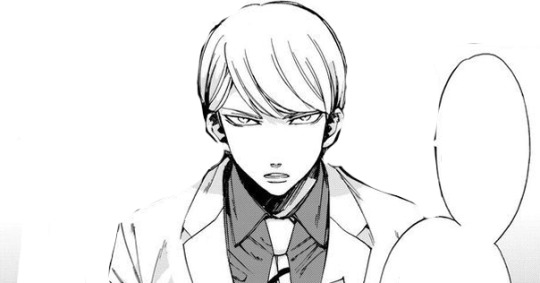
9. “I am not like you. I believe in power. No matter how many I make into victims, even if it means my death, I shall destroy despair. That is my resolve!”
It’s hard to describe why I like Munakata. His confrontation with Makoto is one of my favorite scenes in the series, but out of context Dangan Ronpa dialogue always sounds so ridiculous. Munakata, no we need to kill the concept of despair, we need to kill everyone whose ever even felt sadness. If you disregard how the hope vs despair conflict kind of got ridiculous in DR3, there’s a lot of interesting parts about Munakata’s character.
He’s like a version of Makoto’s character who grew up into someone really unpleasant. He’s trying so hard to be the symbol of hope that Makoto just kind of is on accident. He’s one of the few characters who is a strict idealist that I like, because it shows how much Munakata cares about ideas over justice or hope over people to the point where he ends up being the reason that the people he loved dies.
I like Munakata because he’s a bad person even though he’s fighting for objectively good reasons. He’s such a strict utilitarian he always uses people and has to be in control. He’s terrible to his own close friends. You get the sense that he never really knew either of them. That’s why it’s fun to see him destroy everything with his own hands, and realize after the fact that even when he was nothing left to fight for he has to keep going. Kodaka originally said he was going to die, but he realized making him live at the end with no reason to live was the better option and I agree it was the best possible conclusion to his character.
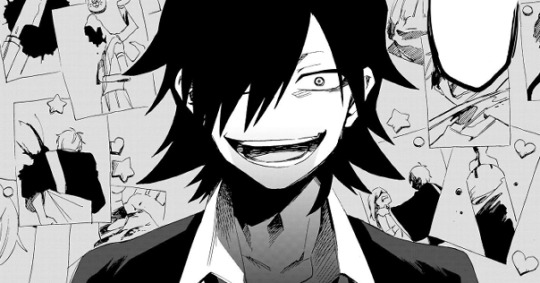
10. “Because you know I...things like murder, these kinds of abnormal crimes, from the bottom of my heart... LOVE THEM MORE THAN ANYTHING.”
Takumi is a big weirdo and I love him. He’s a unique vigilante killer who kills other serial killers not because of any sense of justice, but rather because he thinks they’re all way too lame and he wants to find a really cool killer that lives up to his standards. Takumi is all about the spectacle of killing.
His brain is so weird that to him the feeling of watching his classmates cut apart with a knife is similiar to the feeling of falling in love. He’s a copycat killer but only because the killers he meet are so incompetent and unmotivated that he has to show them how to do it better.
You get the sense that some part of Takumi is dead inside, because when he’s not killing people he’s lounging around acting like a NEET. He likes murder because the knowledge that death is so close is the only thing that makes him truly feel alive and life worth living to him. Ironically, he’s searching for a way to live in his grim fascination with death. There’s just so many tropes turned on their head and inverted for Takumi to the point where black becomes white and white becomes black that it makes his whole story so fun.
#kaibutsushidousha#spooky speaks#mukuro ikusaba#matsuda yasuke#junko enoshima#shuichi saihara#kaede akamatsu#hinata hajime#fukawa toko#nagisa shingetsu#munakata kyosuke#takumi hijirihara
107 notes
·
View notes
Text
Why Brandon Sanderson Is an Amazing Writer (and Why You Should Read His Novels)
Last week I was recommending some novels to @bosstoaster and was really struggling to not fan squeal all over the place about just how incredible Sanderson’s novels are. Usually, when this happens, I try to pick 1-2 things I like about his writing to talk about, so I don’t talk a person’s ear off...but that usually means so much gets left out.
But I’ve been thinking about it since, so you know what? I can do whatever I want on my blog. So here’s my full, unadulterated breakdown of all the things that are so damned incredible (and consistent) about Brandon Sanderson’s novels (as well as his writing methodology).
Does contain minor spoilers, but not for anything huge, and I tried to keep even the minor spoilers vague.
PLOT
Incredible world-building—that isn’t generic medieval fantasy-land
I love fantasy as much as the next person, and I enjoy most generic medieval fantasy stories if the plot or characters are great. But Sanderson’s always exploring different kinds of worlds, and entering them is always engaging. Magical cowboy western? A world continually buffeted by enormous hurricanes on a regular basis, so everything evolved to survive them, including the flora and fauna? A world where ash constantly falls? A world that is literally the embodiment of thought and concept? There’s always something exciting to discover.
Incredible magic systems
Like the generic medieval fantasy world-building, I’m used to the D&D style magic systems with energies and fireballs. Sanderson doesn’t touch these kinds of magic systems, though, and I’m continually stunned at just how creative the ones he does use are. Ingest metal, and use it to activate a latent power of yours? Bonding with the literal living embodiment of a concept in order to gain abilities? Re-writing the history of an item so it believes it can be different, and it changes? Using color as payment for a system based entirely around souls and soul coding? The list is long and always entertaining. He’s even written a whole article about how to design magic systems, which is also worth a read.
Really good at the ‘good’ kind of plot twists that leave you genuinely satisfied
I know we’ve all been frustrated by the recent trend that media seems to have these days: viewers or readers guess the direction the plot is heading in, and creators, in a panic, throw in a completely unrelated plot twist (changing the whodunnit, killing off a character, adding a resolution that makes no sense). Those suck. Let’s be real.
Sanderson does the opposite. He leaves the clues in his stories—they’re always there, and you can figure it out with the context clues, if you’re clever. If you’re not, he’s real good at throwing in twists that are hinted at, but still feel incredibly impactful and really satisfying. The end of The Emperor’s Soul still gives me chills, and I still love the twists regarding the big bads in Mistborn and The Stormlight Archive.
Also? He genuinely will catch you by surprise, sometimes. I consider myself to be a pretty experienced reader, and a decent writer. I can usually tell where plots are going for most stories. That’s satisfying, of course. But Sanderson has a way of still managing to sucker-punch me with a plot twist or reveal that feels shocking in a good way. I don’t see a lot of these coming, but the result isn’t disappointment, it’s a “holy crap—wow, how cool!” followed by an intense desire to reread half the story to pick out the clues that were sitting in front of me the whole time, now that I know what they’re actually for.
Really interesting meta-level stories
Depending on how invested you want to get, there’s a meta-level of interconnected story with the Cosmere. All of Sanderson’s stories are enjoyable on their own, and you’re never required to go deeper. But if you want to, you can, and suddenly there’s a whole second layer of information and characters in the background that you never really noticed, because most of his stories are actually connected to each other too. You don’t have to know who Hoid is or how he contributes to each separate story, you don’t have to be able to find the crossover characters that have literally crossed over from other books, and you don’t have to understand the whole Shards angle, and you can still enjoy all those books on an individual basis. But when you do know how to spot them in the narratives, it’s really fun, and you feel like you’re in on a great secret.
CHARACTER
Only male author I’ve ever read that actually writes GOOD female characters
Brandon Sanderson seems to have hit on the not-so-secret secret that most male authors—who dominate the fantasy genre—haven’t seemed to figure out yet: women are people too.
Consequently, Sanderson writes incredible varieties of female characters, each with their own personalities and quirks, who don’t necessarily fall into the “damsel in distress” or “masculine-coded action lady” stereotypes. See the politically savvy Sarene, the scholarly Shallan, the clever and artistic Shai, rebellious and somewhat childish Siri, the formal and analytical Steris. (These are literally just the ladies with names that start with S).
But it gets better. Because even with action-hero ladies, they still have characterizations outside of ‘being a lady that beats people up like a man and strives to be as unlady-like as possible to prove she can beat people up like a man.’ Vin might be an action heroine, but she’s also a young woman who’s learning how to have a family, who’s scared of opening up to people, and who’s insecure about her place in the world. Marasi wants to be part of law enforcement, but admits to another character that she also likes the make-up and dresses and looking pretty—and she hates that people expect her to be a masculine action-lady that wears pants and starts fights, because she feels like she won’t even be seen in her field if she doesn’t, and like she has to represent all women.
But I think the biggest example of this comes from his short story Shadows for Silence in the Forests of Hell, which (despite its edge-tastic title), is about a mother trying to protect her daughter. Sanderson wrote it as a part of the anthology Dangerous Women, and in his post-script on the story in Arcanum Unbounded, he writes:
“I thought for a long time about the nature of an anthology called Dangerous Women. I worried that the stories submitted to it might fall into the trope of making women dangerous all in the same way....I didn’t want to write just another cliched story about a femme fatale, or a woman soldier who was basically a man with breasts.
What other ways could someone be dangerous? I knew early on that I wanted my protagonist to be a middle-aged mother.”
In short, Sanderson actually understands how women work and writes actual, believable, likable female characters, who are just people and not sexual objects or prizes for men to receive at the end of the novel. It’s something we need, and it’s refreshing to see.
But on that note—he’s not afraid to let his male characters be softer either
In the same way that most female characters in fantasy are forced to be masculine-like action ladies, most male characters are also forced into the same role. There’s this misunderstanding that male characters have to all be sword-swinging barbarians who can’t have emotions.
Sanderson punts this misunderstanding out the window and will have none of it.
There are so many good male characters in this series too that don’t immediately make you want to cringe. Look at Elend, who’s an intellectual doing his best but genuinely screws up a lot, and is all but useless for the first half of the series as a combatant. Look at Wayne, and his heartbreaking moment at the end of Bands of Mourning, who grieves for a person who’d been family to him and isn’t afraid to show how much he cares. Look at Adolin, who seems like the quintessential sword-swinging action-oriented jock, but then completely subverts all expectations by patiently and carefully helping characters with mental illnesses deal with them on their bad days, and being unhesitatingly supportive of his autistic brother. Look at Gaotona, who spends the whole book trying to educate someone on how they’re wrong—only to learn from them instead, and realize he was wrong, and to admit to it.
Men have their soft moments, written by a male author who’s not afraid to put those moments into his works. And that’s really good, too.
In general, just really good characterization
Sanderson’s characters feel like people. They have oddball quirks, realistic-sounding conversations, and occasionally do things that make no sense. Just like friends, family, coworkers, etc that you and I all no doubt know. Hammond’s philosophical rambling (and Breeze’s frustrated bickering over it), Lift making it her life goal to steal dinners, Wayne’s justification for his kleptomania since he ‘trades’ items instead, David’s weird speech patterns and idioms—these characters are just fun to read, and have extra layers that just make them feel more real.
His books have a strong non-romantic relationship focus
Media in general is inundated with romantic and sexual relationships, and doubly so for fantasy novels—especially when fantasy novels often have a ‘prize’ romance at the end of the epic journey. Save the girl, get the girl. It can be frustrating, especially for people who aren’t interested in romance as a genre (there is a reason a lot of us are reading fantasy novels, and not romance ones).
Sanderson loves focusing on all kinds of relationships though, not just romantic ones. Found family, real family, strong platonic friendships, mentorships, interesting rivals, bonds out of duty—they’re all in here, and Sanderson’s not shy about making it clear. Look at Kelsier openly telling Vin he wishes he and his wife had a daughter like her and admitting he sees her as one, or the way the rest of the team turns her into their little sister that they all teach and protect. Look at Wax taking in Wayne, a scared kid who’d gotten in over his head and didn’t know what to do. Look at Kaladin looking at an entire band of slaves and going, ‘yeah, you’re all mine now and I protect you all,’ and how he forms a whole family out of Bridge Four that ultimately turns around and takes care of him, too (and of course, a lot of Kaladin’s story is driven by his own relationship with his actual family, specifically his younger brother). Look at Shallan doing all that she does at the start of the series to protect her brothers. Look at Prof struggling so hard to protect his little band of Reckoners even as he struggles to protect them from himself. Look at Shai and Gaotona, how they’re set up as prisoner and jailer, and yet they grow to ultimately respect each other.
I could go on and on, but the point is, these non-romantic relationships are everywhere, and they are considered to be just as important as—and sometimes more important than—romantic relationships.
But on the flip-side, his romantic relationships are very well handled
Anyone who knows me knows I’m not a big fan of romance or shipping. It generally doesn’t hold my interest. In most books, I skim or skip the romance parts, because I’m just not invested in those relationships. They feel flimsy.
I don’t do that with Sanderson’s works. They’re the only books I’ve ever read where I genuinely feel invested in the characters’ romantic relationships.
Because here’s the thing: all of these characters that are romantically involved, are also good friends, and that’s the basis of their entire relationship to begin with. And that means these relationships are accessible to everyone, regardless of romantic inclinations or interests.
Adolin and Shallan just joking around and bantering, with him teaching her how to use swords, with her rattling off witty repartee to defend him in verbal spars? When they just genuinely enjoy each others’ company, without having to constantly make out or have sex to indicate why they like being around each other? That’s genuinely fun. It’s some lovely character interaction. Maybe I don’t “get” the parts where they want to do more romantically inclined things, but I can enjoy that they legitimately enjoy being around each other, that they’re good friends as well as romantic partners, and that they trust each other. And that means I can still be engaged in their relationship instead of yawning and skipping ahead a few pages.
Which brings me to:
He also takes common romantic tropes...and throws them in the garbage bin
Sanderson has other ways of handling romantic relationships that I (as a person who doesn’t like romance) finds so impressive it deserves its own section. Because he takes common romantic tropes, and subverts them, and makes the characters all the more healthy for it.
On at least two occasions (in Stormlight Archive, and in the sequel Mistborn series), Sanderson has set up a classic love triangle...and then immediately broken it. In one novel, one of the male love interests graciously offers to back out if it will mean the female love interest is happy, because he really just wants her to be happy even if that means he’s not around, and she chooses him anyway...whereupon he makes it clear he’ll definitely help her with her mental health and he wants to be supportive of her. Holy shit, what a wild notion, an actual supportive character in a love triangle. In the second series, the love triangle gets set up, but ultimately broken when the man ultimately chooses the arranged marriage over the ‘true love’ angle, and then realizes he actually, legitimately enjoys the company of the lady in the arranged marriage, and the ‘true love’ love interest realizes that actually, that would have been a terrible idea and she wants to pursue her career. Again, a refreshing and ultimately all-around healthy take for all the characters on something that normally has some nasty fallout.
In Mistborn, my first introduction to one of Sanderson’s series, I remember being genuinely floored and in awe of Elend’s and Vin’s relationship...because Vin is still really nervous about opening up to people and not comfortable with intimacy, and Elend is completely okay with that. He takes it slow with her, lets her set the pace, and doesn’t force her to do anything before she’s ready. Vin is most comfortable just being around/near him without doing anything inherently romantic, just being in his presence, and he is completely cool with that. And that’s such a healthy thing to see in a romantic story, because it’s really important for readers to see that yes, it’s totally OK to not rush into things, and yes, it’s totally OK for people to take it slower or easier for an uneasy partner.
I could go on and on, but basically, romantic relationships in Sanderson’s novels are also engaging because a lot of the time? They’re healthy, and friendly, and toss most dramatic romantic subplots out on their ass.
While on that note?
He doesn’t do sex scenes
This one might be a loss for some, but it’s a win for me. Depending on how I feel on a given day, I’m either ‘irritated by’ to ‘really uncomfortable by’ sex scenes in novels...and unfortunately they’re prevalent, especially in fantasy novels. I usually end up uncomfortably flipping through these pages, trying to figure out where the scene ends so I can get back to the actual story.
I honestly can’t think of a sex scene in any of his novels though. In fantasy, it’s stunningly refreshing, and I feel super safe and comfortable reading his novels because I don’t have to worry about uncomfortable surprises. Plus, circling back to the above points, it’s kind of nice to see characters having established relationships without it having to be solely reliant on them having a good or bad sex life.
Has LGBT+ relationships
Yup, they’re there, and edge past ‘strongly implied’ to ‘blatantly stated’ in some cases too. Offhand, I can think of a pair of men in the Stormlight Archive who are noted to be in a relationship with each other, and a lesbian gunsmith in the second Mistborn series.
What I find important is not just the inclusion of these blatant relationships, but also how it’s treated as completely normal and not taboo in the context of these worlds, too. Non-straight relationships aren’t treated like a scourge or a difficulty these characters have to deal with; it’s just normal in these realities.
Additionally, what I really like about them is the way other characters will get called out about it if they do cross a line (usually accidentally). In the above cases, Kaladin makes an ignorant off-hand remark about his gay Bridge Four soldier and is immediately called out about it by the rest of the Bridge Four gang, whereupon he realizes he’d crossed a line and apologizes right away. In the Mistborn series, Wayne repeatedly makes passes at lesbian gunsmith Ranette, who spurns his advances. But when he realizes she’s actually into girls, he backs off and respects that, rather than insisting on her dating him. These are some nice little lessons on how straight people actually should react regarding their non-straight friends and family, and normalizes non-straight people existing in society.
Sanderson has also been openly responsive to and cool about people interpreting his characters in non-straight relationships or reading “implied” relationships/romantic subtext, even if he hadn’t originally intended to put them there. Offhand, I can think of one situation where a reader told him he probably didn’t realize “just how bi” he’d written Shallan in regards to her interactions with Jasnah, to which Sanderson’s response was basically, “Well that wasn’t on purpose, but alright, cool, cool.”
Also very good about inclusivity for mental illnesses and disabilities
While we’re on the topic of inclusivity, let’s talk mental illnesses and disabilities as well, because Sanderson is great about including these too. In Stormlight Archive alone, we have:
Renarin, who in addition to having some physically disabilities (specifically, seizures and being physically weak), is confirmed by Word of God to be on the autistic spectrum. And he’s treated with respect and support by his family members and friends. His father shows up to meetings or events he wants to go to, just so he can feel comfortable going to them to show interest in things men typically aren’t supposed to. His brother protects him fiercely in combat but also does his best to give him space to grow, and understands that his brother is incredibly intelligent but sometimes just needs a little time to organize his thoughts or figure out how to communicate. Kaladin understands his physical disabilities immediately and is able to give advice on how to deal with them. The entirety of Bridge Four adopts him as another brother. Jasnah finds another way. I could go on, but basically, Renarin is great
Kaladin has clinical depression, and possibly some form of PTSD, even if they don’t have the technical words for this in-universe. He really struggles with this a lot in the series. Despite that, other characters look out for him a lot, and this creates some genuinely tender moments.
Shallan rapidly developing some identity disorders. Actually breaks down and admits this to another character. The other character is fiercely supportive of her despite that and doesn’t give up on her so easily
Lopen doesn’t have an arm, but despite being physically disabled, Kaladin still immediately values him and he finds a place on the team. He’s also just...legitimately chill about being an amputee, makes missing arm jokes all the time, and doesn’t seem terribly bothered by it. I believe Sanderson even stated that there’s no real tragic story behind the missing arm...it’s just Lopen. That’s it.
Teft struggles with substance abuse and insecurity, but the entirety of Bridge Four is super supportive in helping him break it
There’s a character who ends up paralyzed from the waist down over the course of the series. She thinks she’s done for and her life is over, but her mentor keeps encouraging her to try things anyway.
Honestly, this series is enormous—there’s probably a ton more I’m not even remembering off-hand.
All of this is usually handled pretty tactfully and often brings in some really heartwarming character interactions when characters struggle with issues and other characters help them overcome them. Do you like hurt/comfort and whump in fanfiction? Sanderson does this in actual fiction. It’s great.
WRITING METHODOLOGY
He actually takes the time to write good stories
Sometimes a long-awaited book in a series coughDeathlyHallowscough comes out and you just know it was rushed. You can see it in the way the plot threads are resolved, in the way some threads are just never resolved and end up hanging there open-ended, in the way the epilogues are short and empty.
Sanderson doesn’t do this. He’s pretty transparent about it on his Twitter, where he’ll post updates on his writing progress percentages. Sometimes he apologizes for a delay on a book, because he wants to make sure it’s done right or he works out a plot point just so, or he needs to go back and re-read some old material to make sure there’s no hanging plot points.
This is good. This is great. This means he genuinely cares about his work, and he wants to produce good content. I will happily wait an extra couple months if it means the book that’s going to sit on my shelf for years to come has a satisfactory start, middle and end.
He’s always ready to give advice to up-and-coming writers, and he’s great about fandoms
Sanderson has a whole segment on his blog devoted to answering questions about writing. He also has a whole series of lectures available for free online. I’ve even heard him in podcasts and blogs in other things. He’s not shy about giving advice and encouraging up and coming writers, and he’s always so encouraging about it too. He’s also totally cool with fanfiction, unlike some big name authors out there who get very elitist about fandoms and the comparative “worthlessness” of fanfiction.
Some of his novels are available for free, right now, on his website
A bunch of his novels and novellas are available totally for free on his website, which means additional accessibility for people who don’t have the cash for books, ebooks, or audio books, and don’t have time to get to a library.
Many of them are also available as audiobooks, which means you can probably snag them through your local library’s audio book checkout system as well.
In conclusion
Brandon Sanderson rocks, his stories rock, and everyone who likes fantasy should really give them a shot, for all of the above reasons.
#Brandon Sanderson#honestly this writer's work is what I aspire to one day achieve#and I will unapologetically spend two hours writing up this hugeass post about all the good points of his works#because they are so good#give them a shot guys for real
168 notes
·
View notes
Text
It’s the end of Aro Week and I decided to throw caution to the wind and talk about something that can potentially be a polarizing topic. I’m putting it on read-more not only because of length but also because in 2020 this blog turns 10 years of age and I’ve learned to leave a window open for retreat when it comes to Opinions, so I don’t know how long I’ll dare to have this up.
This is going to be about the aroace experience, fandom, ships, representation, fanservice, amatonormativity, allosexual normativity and transformative fanwork.
So, basically, a minefield, so tread with care.
Since the dawn of fandom time, there has been an aspect of it that is known (nowadays) as transformative. There are studies, dissertations and essays about this, and most if not all agree on the fact that the portion of fandom that is transformative tends to belong to the less represented portion of it in the media they consume.
It’s mostly people whose identities are rarely represented those who tend to transform, making a space in their favorite pieces of media for themselves and others. That has, in tow, created a scene in which authors and content creators are born within fandom and get exposed to these types of content and reproduce them as well.
The cornerstone of transformative fandom, to the point of being one of the main organizational elements in fandom-driven platforms, are ships. And when someone mentions the word “ship”, it most often comes with the added non-said descriptive of “romantic” and “sexual” attached to it.
Now, like I said, a lot of those who are involved in transformative fandom tend to go for less represented types of identities, and heteronormativity tends to be questioned often. Sometimes, it is legitimately for representation purposes, sometimes it’s for objectifying reasons.
On the other hand, in the media-creating sphere, there is a thing known as “baiting”. This word is used when pieces of media hint towards non het relationships that end up not coming to fruition.
This issue has reached paragons of shamelessness with creators using fandom for their own purposes, like making a series win an award, getting renewed or gathering numbers in cons, to then turn against the same portion of fandom by banning transformative fandom from cons, meet and greets and having actors and crew members publicly shame fanfiction or fanart. It became serious shit.
This, in tow, brought another problem. Baiting (and what used to be considered “queer-coding”) started becoming an immediate red flag for people, a warning to whether getting engaged or not with a piece of media.
In the mostly legitimate pitchfork and torches march against baiting, canonically aroace characters were caught in the fire, and queerplatonic relationships suffered the price of not fitting in the amatonormative and allosexual normative space fandom created.
It’s a standard for fandom that one of the most necessary reasons for transformative work, for fanfiction mostly, is to make characters confess the love they never did confess on screen/page and, most often than not, fuck each other senseless as a sort of “necessary guarantee of their bond”. Consummation, if you will.
Statistically speaking, explicit fics tend to be much more popular than non explicit ones and romantic relationships are what move the main search engines of fanfic platforms.
Headcanon-wise, anyone can do what they want. If a character is interpreted one way or another, that’s not for anyone to police.
With aroace characters, though, it’s a bit tricky, because it’s incredibly rare the amount of times a character is explicitly in the spectrum, and any evidence you can gather, which isn’t outright hearing it, is a lack of something.
A lack that fandom interprets in another way.
You can have a character be sexually attracted and romantically attracted to another and have that be enough for an audience to understand their orientation, to an extent, but an aroace character seems to have to explicitly state it because the lack of romance or sex in their narratives will be interpreted by fandom as “incomplete”.
It’s more frequent for fandom to interpret a character who is not in a romantic or sexual relationship as “lacking” it and “fix” it in fic than for it to be headcanoned as aroace.
An adjacent issue happens with this and the old notion of “queer-coding”. Audiences tend to sometimes interpret that lack as the incapacity for a media creator to explicitly state that the character is homosexual.
The unintended consequence of years of coding, baiting and censorship of non het relationships in media was the invisibilization of relationships canonically in the aroace spectrum.
For example, the first reaction to Elsa from Frozen not having a romantic relationship in the movie was that she was an amatonormative and allosexual lesbian rather than somewhere in the aroace spectrum. Not that there aren’t a myriad of overlaying possibilities between the two things, but you get my point.
The lacking, the incompleteness that fandom most often sees in characters is filled in, most often than not, with gay romantic and sexual relationships, as a result of the years of queer-coding in media. You know, the good ol’ “if she doesn’t have a boyfriend, she must be a lesbian” stance. Fandom is, sometimes, like a family dinner with a 60+ year old uncle.
This is a problem because it creates, within fandom, instances of tug of war between two under-represented factions who both deserve the due representation and which sometimes, very often, overlay in the same people, who fall in both spectrums. It creates arguments and fights for one or other character between the two, as if they were mutually exclusive at all times.
I recently came across different levels of discourse and comments on two pieces of media for this reason, in two different sides.
One concerned Mackenzi Lee’s A Lady’s Guide To Petticoats & Piracy, in which the lead is aroace and there is a girl who is romantically attracted to her and there is a hint of a potential qp relationship. After reading it I found in some review spaces opinions that considered the author hadn’t “gone all the way” with it, as if it was “cop out” for a potential lesbian romance, taking into account that the first volume of the series was centered on an mlm relationship, which gave people certain expectations.
The opposite happened in the webcomic Go Get A Roomie, in which a female lead character who seemed to be aroace for years ended up in a romantic and sexual relationship with the protagonist and there isn’t so far much of a descriptive of where her identity lied to begin with, but with some meaningful conversations that seemed to imply the spectrum after having suffered trauma. And this can be perceived as a sort of “deception” and to the problematic notion of aroace-ness as a “treatable phase”.
Both stories are valid. Both roads towards self-discovery are valid. There isn’t an immediate denial of the spectrum for one or other possibility and both narratives are experiences that happen to people, even maybe the same people at different times in their lives.
But the two happen to include female relationships and boy are those underrepresented. Like I said, it isn’t that both things can’t overlay in a myriad of places, Lillian could be a demisexual demiromantic, for all I know, Sim could be homoromantic and asexual, we don’t know the specifics.
It’s likely and valid to have a gut reaction when you think you’re being represented and then you’re not entirely. And that’s understandable. But it’s a pity that we have tugs of war for scraps of representation.
So, on the one hand, with headcanons, we tend to get fandom fights, most often than not between underrepresented identities, because we’re fighting for the little there is, when in reality we should be uplifting each other...but anyway, moving on.
That’s all in the realm of interpretation, up until the moment the author makes the characters explicitly make choices and take action. That’s someone having a headcanon because of things the piece of media was doing and then having it proven right or wrong, or never having it proved at all.
The other thing, where it gets nasty, is when fandom “fixes” canonically aroace characters. This is also incredibly frequent, most often than not with mlm ships, or what fandom considers mlm ships.
One of the nastiest last year was the Good Omens debacle.
Neil stated that Aziraphale and Crowley weren’t “homosexual men” because they weren’t “men” and they weren’t sexual beings (the whole “making an effort” thing that explicit fic writers like to latch onto). Neil also said they love each other, however that wants to be interpreted, opening it up enough for it to be platonic or romantic or anything you want.
Fic writers have written more GO fics in the last year than ever probably, because of the show, and they’ve experimented with a lot of places of the spectrum. I’m not here to judge anyone because a GO fic was my favorite ace explicit fic I’ve read, so interpretations can be fascinating, I’m all here for them.
The problem arose when people (mostly cis het women) on social media (mostly twitter) started calling Neil a homophobe for not making them pretty much fuck on screen or explicitly state that they were fucking offscreen in canon.
That’s where we need to draw a line and reevaluate our life choices.
I can’t count the amount of posts, tweets and reactions I saw rejecting the possibility of Aziraphale and Crowley not being a) cis men and b) allosexual. The two things created a gutted reaction, to the point that you have to consider the nature and intended result of those comments and, in that case, who’s being an intolerant asshole.
There was a point in time in which fake woke rep discourse became the excuse for people to demand fanservice from creators, especially in the cis het women + mlm media overlay, and this is a problem. We need to separate the discourses, we need to figure out why we’re here and what we’re demanding.
Another similar example I saw recently, yet less overwhelming, was with Banana Fish and the queerplatonic relationship between Ash and Eiji in canon.
I came into BF later than most, but when I read the epilogue manga I found one of the earliest descriptions of a qp relationship I’ve seen, and there were a lot of interesting comments made by the author and other people interviewing her about why sex was never a part of their dynamic and how the bond they had was more of soulmates than romantic lovers and why it was meaningful all the same.
Still, even if the author doesn’t, Banana Fish is considered among the key “BL” animated series of the last few years, alongside stuff like Doukyuusei, Yuri On Ice, Given, etc. And fandom likes to “fix” that “lack of” situation often, apparently.
This case isn’t as feral as GO but it is, however, deceptive. Coming into BF I never would have guessed their relationship was to be qp because fandom let me believe it wasn’t.
And, in this case, the author explicitly stated that this was her intention, this was the story she wanted to tell, it wasn’t her adjusting to censorship or having to code her characters, it was, at heart, what we now can consider a qp relationship.
And, in all of these cases, in which there are aroace characters or relationships involved, or at least somewhere in the aro spectrum or the ace spectrum or both, there’s one main issue behind it: the lack of belief that relationships that aren’t romantic and sexual can be crucial.
That they can be storytelling worthy.
In media-creating and in fanwork-creating, it seems to be the norm to have an endgame romance, or at least for romance to be a key part of your content. It’s the expected box to tick for a fulfilling story, it seems, and the lack of it is the “problem” fandom likes to “fix” the most.
This is also mirrored in the platforms we use. There is a lack of possibility to tag qp relationships as something separated in ao3: the / is for romantic/sexual relationships and the & is for all-encompassing platonic relationships (described by the guidelines as family, teammates, friends, etc.). In order to write a qp relationship you have to tag it & as per guidelines but you have to add another descriptor because you’re not writing family or teammates, and in the case of fandom-polarizing ships, it can be a problem.
And all of this influences us as creators, to the point that it’s easier to write something we’ve never experienced, like romantic attraction, than it is to write without it, because we’ve heard the romantic stories all the time, we’ve grown up reading them, and we’ve learned that no kudos will come to your fic if you don’t have them in there, because it’s that / what’s gonna move the search engines towards your stuff.
Maybe, hopefully, with time and more media around us, we’ll learn different ways of exploring transformative fanwork. Maybe while knowing ourselves and others, we’ll start believing that a lack of romantic relationships doesn’t necessarily mean someone was “too much of a coward to not make these two explicitly x or y”.
Maybe we’ll learn to coexist because, after all, some of these things coexist within our own spectrums sometimes, and it’d be nice to see the capacity for us to not fight for the scraps of rep that media throws at us but be able to understand each other and ourselves enough to create the media that we need.
#long post when expanded#Opinions#aro awareness week#i'm not gonna tag the examples I'm already risking to much by mentioning them in the post#i don't know how long this will be up tbqh
22 notes
·
View notes
Text
Download pinoy Movies & Tv To Watch Offline
Download Movies & Tv To Watch Offline
It’s nice to see a romance featuring OFWs that doesn’t sensationalize the challenges of working life and strikes a meaningful, empowering tone. Helmed by prominent director Cathy Garcia-Molina, this romance topped 2019’s Philippine box workplace and gained great important acclaim. This is the plot ofJohn Denver Trending—a hidden Pinoy indie film gem from 2019. In an age when cyberbulling and social media-driven disinformation are hot matters, this film helps viewers understand that online speech has real-world penalties, while not feeling overly preachy. Our third finest Pinoy film of 2019 is a authorized procedural drama—Verdict.Verdict follows the case of Joy, a Filipino housewife who stabs her abusive husband Dante in self defense.
Download pinoy Movies & Tv To Watch Offline
Furthermore,Cleaners‘ visuals seem like highlighted black-and-white photocopies—evoking the appearance of Filipino high school reading supplies. Director Glenn Barit bodily printed out the frames he shot, manually highlighted them, after which scanned the highlighted printouts to craft the final movie.
It’s a sprinkle of coming-of-age mixed with a dash of magical realism. With wonderful manufacturing high quality, Alone/Togetheroffers a practical and heartfelt take a look at balancing romance towards particular person dreams.
The highest grossing films within the Philippines have a tendency to change every year, but what would not change is the fact that they're normally the same bubblegum-sort, feel-good flicks that is good for the second, but doesn't really age nicely. There are the Vice Ganda comedies, the John Lloyd Cruz romps, the Vic Sotto fantasies. Currently, the highest grossing film is the freshly released Hello, Love, Goodbye, starring Kathryn Bernardo and Alden Richards, clocking in at virtually 900 million pesos. While it still falls principally under the standard tacky drama, it's become a well-reviewed movie that is deep, non-formulaic, and relevant.
Download pinoy Movies & Tv To Watch Offline
Shake, Rattle, and Roll movies if you need your horror film repair whereas staying at house. This one comes courtesy of Regal Entertainment for releasing a few of its basic SRR films in mild of the quarantine. K’na The Dreamweaver who centers on K’na , a princess of the T’boli tribe in South Cotabato.
The drama Caregiver stars Sharon Cuneta, John Estrada, and Rica Peralejo and takes place in the United Kingdom. The story follows English instructor Sarah Gonzales who is working abroad as a caregiver to make money to help her husband support their household again residence in the Philippines. The movie tells the empowering story of Filipino OFWs via Sarah’s journey to self discovery.
Set in Negros, Oro, Plata, Matatraces how the struggle affected the lives of two aristocratic households. Its imagery and dramamakeit a case research in nice Filipino films. In sum, the On The Job director asks the movie-going public to have faith in Filipino movies. Bernardo and Richards prepared intensely for their roles; Bernardo spent time away from the other cast members to construct a way of isolation. What results is a sensible and empathetic efficiency that avoids the hole sugariness of other Filipino romances.
No extra ticketing or scheduling problems; they’re finally obtainable with just a faucet. The movie was filmed in simply three weeks, and stars a lot-liked Filipino actress Nora Aunor, in what many pundits price as the best performance of her profession.
The movie walks the line between documentary and drama, strolling us by way of Joy’s seek for justice in opposition to Dante. The movie contains an anthology of 5 different tales that includes designated classroom cleaners in a Tuguegarao highschool. Each of the tales touches upon the theme of “cleanliness”—whether why not look here or not bodily, moral, or otherwise. A cast of first-time actors brings the five tales to life, and offers them an authentic, pure feel. Those who went to highschool in the Philippines could find moments of tender nostalgia in Cleaners‘ narratives.
Affluent Julie Monserrat falls in love with student-slash-combo participant (that's much like at present's DJ) Dido, and their forbidden romance rocks the entire town. Already a traditional, thisMike de Leon opus has been described by many as one of the best Filipino films of all time. Starring Mark Gil in his most iconic function as Sid Lucero, it explores the fraternity culture during the last phases of martial legislation in the Philippines.
Vic Silayan plays a terrifying patriarch with a stranglehold over his family, together with his newly married and hapless daughter (Charo Santos-Concio). Diaz-Abaya was one of many strongest feminine voices in Philippine cinema, and on this period drama she lambasted the commodification of girls as strongly as she ever had. A son returns to his hometown along with his new bride in tow, solely to have her be the item of his father’s lust as a result of her resemblance to his deceased spouse. Swirling with themes of oppressive patriarchy and Oedipal complexes, shot through with startling violence, Karnal is as close to noir as Philippine films can get.

Download pinoy Movies & Tv To Watch Offline
, de Leon was making cinemagoers swoon with this mild coming-of-age love story between an aimless student/aspiring songwriter and the attractive woman whose marriage in the end proves to be a heartbreaking wakeup name to their dream of being together. I keep in mind being pissed off as a result of I was too younger to catch this true-crime thriller when it first got here out at the 7th Metro Manila Film Festival. Based on the Nick Joaquin article “The House on Zapote Street”, Kisapmata proved too darkish for audiences’ tastes for the time, however its standing as a harrowing exploration of the shadowy corners of the Filipino psyche stays unparalleled to this present day.
She aptly and intensely portrays Tin’s vulnerability in a way that doesn’t feel overly sentimental. As the second-highest grossing movie of 2019 within the Philippines,Alone/Together reaped nice financial rewards for telling its story properly. Adapted from the hit Korean movie agree with of the same name,Miracle In Cell No. 7won the love of critics and audiences with its heartwarming father-daughter story. Building upon the Korean unique,Miracle In Cell No. 7 tells the story of a mentally disabled man named Lito who’s wrongly jailed.
It is properly-acted and is likely one of the finest-crafted films within the decade. It indulges followers to revel within the state of kilig by seeing their favourite celebrities do a dance of will-they-or-won’t-they despite the fact that everyone knows the ending.
Dukot is a dramatic action crime film set within the Philippines starring Enrique Gil, Christopher De Leon, and Shaina Magdayao. The film tells the story of a center-class government official whose estranged son gets kidnapped. When the abductors demand a high sum for ransom, he should come up with the money before it’s too late. The dramatic comedy Four Sisters and a Wedding stars Brenna Garcia, Bea Alonzo, and Bea Basa and is ready in Manila, Philippines. The film recounts the story of a Filipino family consisting of four sisters and a brother.
After failing her structure board exams, Mara meets Gali , a deaf signal language instructor. The two develop an unlikely connection as they find consolation in every others’ imperfections. Made by millennial-focused Black Sheep Productions,Alone/Together follows a normal romance storyline but executes it well. The film stars real-life couple Liza Soberano and Enrique Gil as the leads—a girl named Christine “Tin” Lazaro and a boy named Rafael “Raf” Toledo, respectively. Tin research artwork, and Raf studies Biology en path to changing into a physician.
Set in a crowded and underfunded government hospital, the movie finds humanity within the dankest corners and the harshest of conditions. What might have been just another love story set in an unique land is reworked by Jason Paul Laxamana into an affecting portrait of escape, with the potential for romance between a beleaguered film star and a troubled expatriate. Lav Diaz and Brillante Mendoza are as active as ever, supported not by an area constituency however by the demand of foreigners for his or her distinctive views. There are additionally many other filmmakers who are producing films on their very own, risking fortunes and careers to not create content for media companies however movies to be screened in a movie show.
John Denver Trending has glorious cinematography and nicely-developed characters (John Denver’s mom is an particularly interesting figure). This makes its on-line witch hunt story feel all the extra resonant, and illuminates the raw horrors of internet-pushed mobs. Director Arden Rod Condez retains the narrative tightly centered, and never lets it descend into the same irrationality that a few of its characters embody. Impressively, this extremely relevant film is Condez’s directorial debut.
Download pinoy Movies & Tv To Watch Offline
A caregiver named Jaica is employed by Vivian, a successful businesswoman who recently found she was unwell. Little does Vivian know, Jaica performs a considerably larger function in her life— one which reconnects her to her distant son. At that time, Siguion-Reyna, son of movie legend Armida Siguion Reyna, was known special info for breaking barriers. One of his earlier films, additionally that includes Roces, wasLigaya ang Itawag Mo sa Akin, which illustrated rape. It was initially given an X rating and was only aired to the general public after quite a few concessions that resulted in scenes on the slicing ground.
When Lito’s fellow inmates notice he’s an harmless man, they assist smuggle in his young daughter Yesha so the two can proceed bonding. Starring Kapamilya actress Kathryn Bernardo and Kapuso star Alden Richards, Hello, Love, Goodbye is the best-grossing Filipino film of all time.
youtube
This intensive, months-lengthy course of results in a movie that literally looks like nothing else that Pinoy cinema has to offer. Ulan could be about love, nevertheless it’s not your average Filipino romance. The film stars Nadine Lustre as a author named Maya, who’s struggling to find romance and happiness. As Maya journeys via life,Ulan weaves fantastical tales from her creativeness and childhood as a reflection of her psyche. We see her speaking withtikbalangsin one second, and typhoons in one other.
If you’re trying to celebrate the occasion within the consolation of your personal house, you might be interested in doing so by catching up on must-see titles Philippine cinema has to supply — or, when you’ve already seen them before, watching them unfold all over again. Initially hard to find , these motion pictures have been made accessible to extra audiences thanks to different streaming platforms.
Most of the Philippines' critically acclaimed films are gritty and heavy, but this Maryo de los Reyes basic sticks to the reality of highschool, which is light, relatable, and fun. There are many extra intricacies between and after these occasions, and you may need to essentially watch Karnal to understand why it's such a fantastic Filipino movie. The combination of a powerhouse forged and formidable director Peque Gallaga led to this beautiful Filipino traditional.
The movie tells the story of mysterious happenings in a remote village which end in Ferdinand E. Marcos implementing Proclamation No. 1081, which locations all the Philippines under Martial Law. The movie delves into the difficulties of the village folks as they cope with this new proclamation. The drama Himala takes place in a poor Filipino village and stars Nora Aunor, Veronica Palileo, and Spanky Manikan.
When the brother, the youngest of the siblings, declares that he plans to get married, the sisters devise a plan to speak him out of it, revealing the deep-seated animosity they've for each other. The romantic drama The Hows of Us stars Kathryn Bernardo, Daniel Padilla, and Darren Espanto.
Any benefit thisAlvin Yapan filmevaporated when word got out that a canine was killed throughout production. Based on the true story of the "Gata Four Massacre" in Caramoan, Camarines Sur, it received a number of accolades and obtained positive critiques. The dog killing, nonetheless, resulted in Senate hearings and closed-door meetings. The scene was eventually edited out, but its impact has one way or the other lasted. Have you ever come across a movie so controversial, so bold that the President needed to step in to ban it from public viewing?
Download pinoy Movies & Tv To Watch Offline

Anyone who didn’t will nonetheless benefit from the 5 stories’ easy however meaningful takes on adolescence. Another more distinctive Filipino love story that came out in 2019 wasIsa Pa with Feelings .
It seems to be the case for lots of the nation's most groundbreaking movies. Mang Kepweng was a popular comic strip by Al Magat a couple of humorous village albularyo. The character was dropped at life by comedy legend Chiquito and it spawned a number of installments, with Mang Kepweng and Son being the fourth film within the sequence. Dindo Fernando, Vilma Santos, and Hilda Koronel play a person, his wife, and his lover on this Danny Zialcita film about the intricacies of marriage and adultery. The in style Filipino movie won six prizes on the 31st Filipino Academy of Movie Arts and Sciences Awards , including Vilma Santos' third Best Actress win.
It’s a type of films where the protagonist has to make a tough alternative – on this movie, K’na has to make a sacrifice between her village clans and real love. all not on Netflix – can now be accessed freed from cost, due to the kind hearts of our filmmakers. We’ve listed 10 of these local films – from blockbuster hits to horror movies – under. It’s a black comedy by the use of city fairy tales and magical realism. It has impeccable use of cinematic language — from scoring, to cinematography, to editing.
It reached P880 million box office mark after a month of hitting the cinemas. The movie is not a typical “LizQuen” love story that showcases the Philippine Art and nostalgic 90’s vibes. It depicts the story of a pair who faced many challenges from their school romance to turning into actual adults entering the real world. 2019 has been a great yr for Philippine cinema as it supplied numerous motion pictures that entertained a lot of Filipinos throughout the globe. You can watch more award-successful Netflix Originals, documentaries, motion pictures and TV reveals by choosing a plan that’s best for you.
The film tells the story of the romance between the young couple, Primo and George, who dream of building a life collectively and are already devising their future. However, their plans are put to the take a look at when they're confronted with obstacles that put their relationship in danger. Set in the Philippines in 1972, the drama From What is Before stars Perry Dizon, Roeder, and Hazel Orencio.
The movie tells the story of Elsa, a Filipina villager who claims she has been visited by the Virgin Mary. The go to changed her life as she now appears to have particular healing powers. Her newfound talent begins to trigger hysteria in her small village.
Download pinoy Movies & Tv To Watch Offline
This Jose Javier Reyes movie is known for being known as "a properly-made gentle porn movie" by none aside from then President Gloria Macapagal Arroyo. Live Show, which was originally named Toro, depicted the lives of poor individuals who had to resort to performing lewd acts on stage to outlive. It is among the few extensive-launch movies that featured full-frontal nudity. After pressure from the Catholic Church, the President herself had to suspend it from airing on theaters. Though initially banned by the MTRCB, it was allowed to re-air after the title, which meant pay-per-view sex, was changed.
The film tells the story of Basha and Popoy, a young couple deeply in love who spend all of their time together. But when clashing ambitions and tensions come into play and the couple splits up, they're both feeling devastated and heartbroken. Strangely sufficient, pandemic motion pictures have turn into extra in demand because the coronavirus outbreak. If you have received the guts to sit by way of movies that observe the results of a virus, check out our suggestions. A record of greatest Filipino motion pictures would be incomplete with no Dolphy starrer.
It indulges the equipment behind the love team to flex its muscular tissues, creatively and financially, proving the online value of the pair by putting out an enormous-display romance that’s so rigorously calculated to a fault . And lastly, it indulges the actors to show their benefit as reliable actors, with tacked in confrontation scenes and weepy dialogues that profess the true nature of formulaic love. The marriage is a attainable gateway to a greater life however Teria’s leaving, the way in which the movie is a one-take shot of her going across the island earlier than reaching the pier, more so embodies the ills and the heartaches that kind the core of the Filipino diaspora. Are the “mainstream” and “indie” labels even applicable nowadays, when budgets and industry don’t considerably differ?
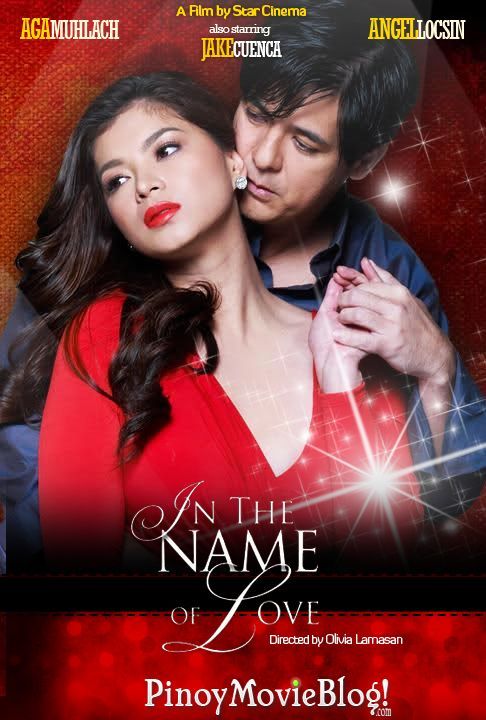
If it’s a matter of sensibility, how can we distinguish when “impartial” filmmakers are directing studio-backed motion pictures, whereas established actors and filmmakers from the big networks are also increasingly going “indie”? And let’s not even delve into the query of whether or not it’s primarily based on notions of quality.
Produced by then-married couple Nora Aunor and Christopher de Leon, the World War II-set drama follows Rosario , a woman deserted by her lover when he joins the Resistance, solely to then fall in love with a Japanese soldier . But Hello, Love, Goodbye is the mother of all migrant dramas—and never why not pinoy movies just because it's officially the best grossing Filipino film of all time. The dramatic motion crime movie Metro Manila, set in Manila, Philippines stars Jake Macapagal, John Arcilla, and Althea Vega.
The story revolves round beautician Coring as he takes in Nonoy , who is the son of his crush. With Lino Brocka behind the digital camera, Ang Tatay Kong Nanaydelves into the themes of homosexuality and single parenting through a comedic lens. This Filipino film is a traditional rich-woman-poor-boy romance delivered to life by actors Vilma Santos and Bembol Roco and director Celso Ad Castillo.
Download pinoy Movies & Tv To Watch Offline

The movie follows the story of Oscar Ramirez and his household who flee a lifetime of poverty in a small village in northern Philippines to the bustling heart of Manila. The quick paced lifestyle and hardened locals quickly overwhelm the household, and Oscar should do what he needs to to survive in the massive metropolis. The romantic drama One More Chancestars John Lloyd Cruz, Bea Alonzo, and Derek Ramsay.
3 notes
·
View notes
Text
The Assistant: (Appendix 2): The Making of Maxine Valois
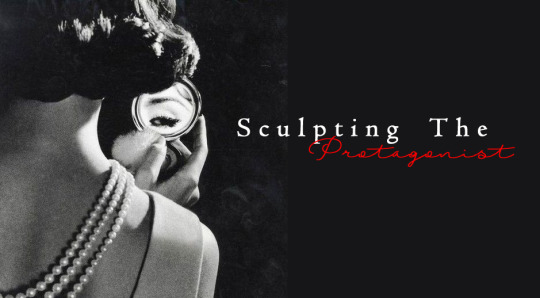
Like many fanfiction writers, I spend a lot of time thinking about forming different types of Original Character, and the drafts I have mentally done for Maxine was difficult each time. I have noticed from my habits that I spend a lot of time thinking about what the character looks like and not how the character feels. In terms of Maxine it was completely opposite--I had basic features in my mind, Long and black wavy hair arranged everyday in flapper-style chignon, silk clothes, tall and willowy, pale, sharp and symmetrical features, thin lips and black eyes.

“What’s in a name“? well, when it comes to my story or when I am writing--everything? I had spend a lot of time to name my OC. My first thoughts were really stupid, I went from 1920′s names to classic French names, but none matched her temper, thus I looked into some Latin names feeling that I should make her lineage a little more prominent. My choices were Claudia, Dido, Aurelia, however they sounded too serious; suddenly it clicked that Maxine sounds very regal and powerful, while ‘Max’ sounds very modern, tomboyish and playful which summer up her character in my mind. Coincidentally Letter M and N comes one after another.
Her surname is Valois, in French it means “from the valley”. The Valois name is historically relevant, and I characterise the family as the authoritarian oppression of society on women. Both the houses where Maxine was born and lived were former prisons. This signified that her entire life has been spent as a prisoner--something that clashed with the name ‘Maxine’: the greatest.
I had given her three names: Maxine, Adrienne and Odessa, each representing three aspects of her characters. “Maxine” means ‘greatest‘, ‘Adrienne’ is a French name meaning ‘dark‘ and ‘Odessa’ is just a female version of Odysseus. The Second Epilogue of The Assistant was the homage to her ‘Odessa’ name: Nostoi, on in Greek “homecoming“. When she was born, she was not welcome in her father’s home, neither in the three schools she studied: Durmstrang, Hogwarts and Mahoutokoro, nor in her Auror office as Theseus’ Vice Head, nor as Newt’s lover--a role she sought after so greatly. Her homecoming was possible by acknowledging her feelings for Theseus which she ran from which resulted her encounter with Newt.
The name “Adrienne” seems quite non-symbolic in my story, but this name was specially implemented by me with a very specific intention. ‘Adrienne’ is the French variation of the Greek name ‘Ariadne’. The most popular versions of Ariadne is ‘Ariana’ and ‘Adriana’ but I didn’t want that. The reason I selected one of Maxine’s middle name after Ariadne needs to be elaborated with the myth surrounding Ariadne. Ariadne was the daughter of Minos, the King of Crete, who helped King Theseus cross the Maze to kill the Minotaur. After the matter was over Theseus had a brief relationship with Ariadne. He abandoned her leaving her deeply heartbroken for the Amazon Queen Hippolyta.
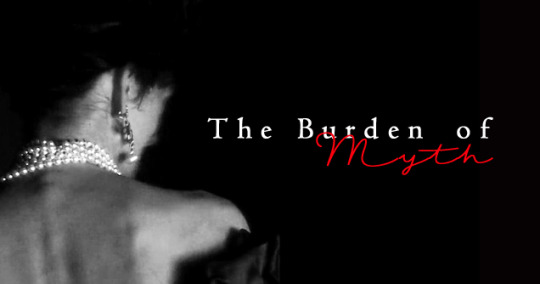
JK conspicuously sneaks Greek and Roman myths into HP stories. The dynamics of Leta, Newt and Theseus seemed very ‘mythlike’ to me.By remaining Virgins fro perpetuity, Amazons sacrifice their motherhood which was quite symbolic in Leta’s mistake that killed Corvus Lestrange. Leta could easily be the diminutive of ‘Hippolyta’ the Amazon Queen. Amazons are loyal to both Artemis and Ares, which can easily be compared with Leta’s earlier attachment to Newt, (One of Newt’s middle name is ‘Artemis’). Hippolyta’s status of getting married to Theseus is a transition from Virginity to the subjugated of a King, which can easily be seen in Leta X Newt and Leta X Theseus.
How does Maxine fall in the story? King Theseus abandoned Ariadne for Hippolyta, and Ariadne was loved by Dionysus, God of Wine and revels. Maxine, just after her full name was revealed, was already showed falling drunk on the floor. Her usual material ‘excesses’ is very Dionysian in nature. After their rift with Theseus, Maxine sought comfort in her usual ‘excesses’ because I had imagined that’s what an ‘abandoned’ Ariadne would do. I also often wondered what if King Theseus repented and Ariadne caused him pain just to get a revenge on him? The union symbolizes penance of Theseus for abandoning Ariadne.
It is not only for narrative sake, the ‘Ariadne’ name also describes Maxine’s nature. Ariadne is associated with threads and Mazes; Maxine is deliberately seen messing and tangling with the threads of relationships--profession, familial, sexual and romantic. Ariadne, with her thread left a trail throughout the maze which would later help King Theseus to get out of the maze. Maxine was proposed by Theseus right after Leta’s death. Maxine broke it off and Theseus followed her trail to her first in Newt’s apartment and second in Japan--wherever Newt and Maxine were--Theseus was always present--either physically or mentally. Her character is the most confusing array of emotional mazes. I would describe her character as ‘onion-like’: there is mask after mask: under the face of Audrey there was Maxine; under a face of employee was a crushing lover; under an envious woman was a desperate want of love... if all the masks are removed, there will be nothing left--she is essentially a hollowed out creature.

“Tricksters“ are abundant in literature and media. We have Loki, Joker etc. who are often identified with this type: physically not very strong but highly intelligent who challenges the norms of society just to prove that strength, beauty and authority isn’t everything. We don’t often associate women when it comes to this particular archetype and this made me think about it--women can be mischievous and equally chaotic when they want to so why not! In 1920′s when women can either be Flapper party girl or a modest matron, I chose Maxine as someone different. I imagine her to be capable of walking into a party into her lingerie just to irk the “uptight official people“. Her very introduction is the testimony of her Tricksterdom--she challenges and fools the authority (Theseus) in the support of the Alternative (Newt), she combines her intellectualism with her sexuality, a point which makes Theseus readily fluster around her: snatching his wand and suggesting that she had concealed it between her breasts is not only standard-defying but also an open declaration of feminine sexuality; furthermore she later threatens that she will have Theseus’ wand “for realment”-- it could indicate either “real wand“ (indicating Theseus’ manhood) or “wand“ ‘for real‘. This play of words is so ambiguous that it makes the hearer confused and unpredictable.
It has been indicated that Maxine’s upbringing was very strict where she was constantly reminded of her inferior status: her illegitimate birth. This made her dissociate with her family and compelled her to spend more and more time developing the ways to defy them. This not only brought signs of magic in early age, but made her the innovator that she was. I imagine that she would spend her days creating spells to trick people or to harm people but also to keep her busy in the head. Tricksters are often very imaginative as their character requires it. However in one manner Maxine defers from the Trickster type. Tricksters never change in their heart; they are constant reminder that Exceptions Exist. However a change in heart occurs when she sees her mother and father being killed in front of her, which made her realise that like dynastic curse she will end up finishing herself and Newt in the process. She surrenders and accepts her punishment, something a trickster will never do. At the end she finds the reasons to submit, something she defied doing for so long, but her triumph comes when she almost scares the wedding guests and the groom Theseus to death by answering to the wedding vows “or do I?”
When we are talking about how ‘trickster-ish’ Maxine is, her name “Odessa” is meant to be under scrutiny. Homer’s Odysseus is considered a Trickster hero, whose wickedness of fooling Polyphemus cost him twenty years of detention in the sea. Maxine’s wickedness had cost her too: expulsion from Durmstrang (for murders she committed under Anatole’s manipulations), transfer from Hogwarts to Mahoutokoro (before she finished her Seventh year; only after her detention in Mahoutokoro she gets the graduation from Hogwarts), persecutions at her job etc. More than her it had cost other people: it almost got Newt, Theseus and Tina killed, imprisoned and off their jobs, the Bulgarian secretary in the party was hurt by her and Charlemagne almost lost his job (and life) for her. Her actions patronised people like Anatole who kept feeding off Maxine’s weakness and assumed British Ministry office using her as a bait. However despite all the facts, she continued to use cunning, manipulation and a pretended innocent facade to get to “home”, like Homer’s Trickster hero Odysseus did.
#ranting about oc#my oc writing#maxine valois#newt x oc#theseus x oc#about my fantastic beasts fanfiction
5 notes
·
View notes
Text
Jon Snow’s journey through the Major Arcana
Since I wrote a previous analysis of Arya’s journey through the Major Arcana of the Marseilles Tarot, I decided to write one for Jon as well. A shout out to @ourmrsreynolds for helping me with her great insights on the interpretation of the cards and the character!
The Devil: I can already see your shocked faces through the screen. This card tends to bring with it a lot of misconceptions because of the idea that we have of the devil. This card represents the conflict between what we should do and what we want to do. It represents attachment, addictions, restrictions (self-imposed or not) and sexuality. On the other hand, it can also represent breaking free from these restrictions, breaking rules or indulging dark thoughts.
This is card is a perfect summary of Jon’s entire arc. Jon lives a divided life between what he wants to be and what people expect him to be. The bastard status brings with it a very negative expectation and prejudices about his character in society. People expect him to be deceitful, greedy, evil in some way, or - the worst thing for anyone raised by Ned Stark – dishonorable. Jon lives to prove all of these to be wrong and to frustrate others’ expectations on his character. “Let them say that Eddard Stark sired four sons”. This sentence represents the moral compass that guided Jon through all of his narrative.
Jon doesn’t allow himself to be ambitious, so it won’t be seen as a threat to his legitimate siblings. In order to craft a position for himself and at the same time annul the threat he represents to his sibling, Jon goes to the Night’s Watch. He gives up his name, his family, his ambitions in the political scenario and even sexuality in order to become what “he wants to be”; an honorable man like Ned Stark.
Is it really what Jon wants to be though? The answer is no. Jon has ambitions or had at some point in his life. He wanted Winterfell, even though he knew it would be passed to Robb one day. He wanted to take Ned’s place in the future and be the Lord of Winterfell, with a family of his own. This became explicit when Stannis offered him the title.
Jon holds to all these restrictions tightly until he is confronted with the fact that life can’t be live in black and white. At the first contact with the wildlings, Jon starts to question several of his values and he experiences a level of freedom he had never allowed himself to have. At some point, holding up to these old values no longer makes sense. Between what he wants to be and what people expect him to be is where Jon’s true self if. “He was who he was; Jon Snow, bastard and oathbreaker, motherless, friendless, and damned.”
The Hierophant or The High Priest: this card represents conformity, tradition, institutions and religious beliefs. It can also represent personal belief, freedom and breaking the status quo. The High Priest, unlike the High Priestess, has disciples around him. He is a man in a position of power and influence.
This card represents Jon in the Night’s Watch, both as a steward and as Lord Commander. Jon is a natural leader. People tend to follow him and his presence demands respect. As I said before, he also holds to a number of strict values and to some extent he likes structure and stability, here represented as the Night’s Watch as an institution.
Jon also has personal beliefs and they are not always aligned with those of the structure/institution he represents. He breaks free from several previous concepts and throws status quo through the window at the moment he decides to help the wildling, becoming a leading figure to both the NW and the free folk in some ways.
The Moon: intuition, creativity, imagination and the shadow-self. Just like Arya, the moon is often present in Jon’s narrative and it represents yet another aspect of Jon’s personality that is kept hidden. Jon is a warg and Ghost is somewhat an extension of Jon’s identity.
Temperance: where Arya is Justice, Jon is Temperance. This card represents balance, moderation, patience, and purpose. In the negative aspect, it represents imbalance, excess, realignment and self-healing.
As Lord Commander, Jon has a political role to perform and being political is precisely the effort of balance several conflicting interests both inside, and outside the Night’s Watch. Jon serves as a bridge between the institution he represents, the wildlings, Stannis and his actions have an impact on the whole North. At the moment Jon decides to march to Winterfell and fight Bolton, this balance is broken and chaos follows.
The Lovers: love, trust and unity in a relationship. This card has both romantic aspects and also a pragmatic ones. It represents love in an ideal concept, but it also represents a choice between two options that are mutually exclusive. In the negative aspect, this card represents the internal conflict that affects one’s relationships (in a broad aspect, not only romantic ones).
Just like Arya refuses to let go of Needle and her own identity; Jon breaks the one rule he should never break. He forsakes his vows of neutrality and the promise of letting go of all his former familial bonds in order to save a girl he believes to be Arya. He can’t be a member of the Night’s Watch and save her at the same time.
This card also represents his relationship with Arya. The mutual trust, loyalty, and unity in a relationship that is selfless. You can see it as a platonic, familial or even romantic sort of love, but there’s no way to deny the fact that Jon and Arya love each other deeply and are fiercely loyal to each other as well. To deny it is to ignore Jon’s entire arc and the fact that Arya is the main feminine reference that he has, and also the first experience he has with love coming from a woman/girl. Arya takes the place of the loving female figure that should have been occupied by a mother. Jon has no maternal love reference in Catelyn, at least not directed to him. He observed the difference in the treatment she gave to her sons and to himself. Although he has witnessed Cat being a good mother, we can’t say that he experienced it himself. This first reference to feminine love came from Arya, who seems to be Lyanna 2.0.
The Judgment: judgment, inner calling, absolution, rebirth. It can also represent the act of ignoring a call, self-doubt and inner critic. Every action must have a consequence. In some ways this card represents karma.
Every unpopular decision Jon made along his journey leads to the moment he is attacked by his black brothers. Jon’s death isn’t something that happened by accident. This result could be foreseen all along and at every step he gave in the opposite direction of the Night’s Watch’s rules were a step closer to his death. It’s interesting that this card also represents rebirth, isn’t it?
The Emperor: authority, establishment, structure, a father figure. In the negative aspect is the domination, excess of control, lack of flexibility and discipline.
The card in the first moment represents all the male figures that represented an example to be followed in Jon’s life. Ned, the Old Bear, Half-Hand, Benjen, and Mance are represented in this card. They are all parts of the man Jon wants to be and also everything he can’t be because Jon is his own person with all his virtues and flaws that are not the same as these men’s.
It’s also the father he never knew but is somehow dictating his future. Rhaegar was born to be a king but died before the right time. This legacy is passed to his son.
14 notes
·
View notes
Text
https://www.nbcnews.com/news/amp/ncna1047551?__twitter_impression=true
Donald Trump holds the most powerful office in the world and he's used its authorities in ways never contemplated by his predecessors. So why does he portray himself as a victim?
Trump's 2020 pitch: A powerless presidency
Analysis: The most powerful man in the world would like voters to know he is beset on all sides by sinister forces that deprive him of the authority he needs to deliver on his vision for America.
By Jonathan Allen | Published Sept. 3, 2019, 7:15 AM ET | NBC News | Posted September 3, 2019 5:41 PM ET |
WASHINGTON — The most powerful man in the world prefers to portray himself as a martyr.
President Donald Trump says he's been beset on all sides by sinister forces that are oppressing him and depriving him of the authority he needs to deliver on his vision for America.
Often, the villains in his narratives work for him.
First, it was the CIA and the FBI, then Democrats, members of his Cabinet and Robert Mueller. Lately, his enemies list includes his hand-picked Federal Reserve chairman, Jay Powell, and Fox News. The cable network "isn't working for us anymore," Trump declared in a tweet last week, a few days after calling Powell an "enemy" of the United States.
Trump's persecution complex is an essential part of his brand — one that resonates deeply with a political base that believes anti-Trump liberals run the federal government and the news media. But as he seeks re-election in 2020, Trump is banking heavily on his ability to blend it into a coherent narrative with a version of his presidency in which he's been a commanding force, steamrolling adversaries to get things done.
"This election is not merely a verdict on the amazing progress we've made," Trump said when he kicked off his re-election campaign in Orlando, Florida, in June. "It's a verdict on the un-American conduct of those who tried to undermine our great democracy, and undermine you."
When he's less scripted, Trump sometimes speaks or tweets in terms that are more personal, such as when he describes himself as the target of "presidential harassment."
These two halves of Trump — victim and conqueror — fit together snugly for his campaign.
"It definitely is something that he and the campaign talk about," said Tim Murtaugh, communications director for Trump's re-election campaign. "There is no question he can still run against Washington based on the outspoken and unprecedented obstruction he has faced. And despite all of this, he has still accomplished everything that he has on behalf of the country."
Trump's supporters have mirrored the messaging.
Conservative commentator Bill Mitchell, for example, has cast Silicon Valley and the Drudge Report as anti-Trump forces tilting the world unfairly against him in recent days while also praising those — implicitly Trump — who overcome such challenges.
"Big Tech doesn't even care any more. They are all in to steal this election from President Trump. The days of appearing fair are over. They are just daring Trump to stop them at this point," he wrote in a tweet just hours after posting, "Let's start here: Life ain't fair. Proceed as if you know it. Be a champion, not a victim. Victims see roadblocks, champions see opportunities. #Trump2020."
Democrats say Trump's case requires a cognitive dissonance that is too much to bear.
"Playing the victim card in politics is pretty tough when you're president of the United States," said Chris Kofinis, a Democratic strategist and message-testing expert who has worked on presidential campaigns. "You can’t have it both ways. You either have control over the destiny of the country or you don’t. I think it’s that simple."
The Washington Trump is running against, critics note, is filled with people he appointed to run agencies that are under his control. The Senate has been in Republican hands throughout his presidency. And the Supreme Court has a conservative majority featuring two justices he appointed.
To the extent he's been frustrated by what he calls "the swamp," it has arguably been as much a result of his inability to get people in his own administration and in his own party to go along with policies that sometimes cross the border of seriousness — like nuking hurricanes — as it has been from an opposition Democratic Party that has held very little formal power since he swept into office in January 2017.
While Trump surely has racked up significant policy and political victories — a major tax cut, two Supreme Court appointments and deregulation of an array of industries — his trade war with China has caused economic pain for producers and consumers in the U.S., he's demonstrated no progress in dealing with the regimes in North Korea and Iran despite his focus on those countries, and the massive influx of immigrants from Latin America on his watch has resulted in a humanitarian crisis.
Democrats say swing voters will see these outcomes as proof that he delivers more calamity than calm when he resorts to his own devices to make policy.
Both Trump's allies and Democrats agree that the sentiments of the relative handful of persuadable voters will be critical to determining his fate.
"They look at him as the architect of destruction and dysfunction, and they are going to be negative toward any leader, whether it's Trump or anyone else who makes excuses about their actions," Kofinis said.
But Michael Caputo, a Republican strategist and Trump ally who worked on the president's 2016 campaign, said that there is a clear "connective tissue" between the two elements of Trump's argument and that he needs those swing voters not only to regard him as effective but as embattled.
"You'd have to be dead or near dead not to understand that Donald Trump has been attacked at every turn of his presidency like no president in modern times," Caputo said. "Part of victory for Donald Trump will be convincing the middle that he hasn’t gotten fairly treated by Washington."
Democrats say that the premise of Trump being uniquely under siege — despite long investigations into his campaign's ties to Russia and possible obstruction of justice — is faulty.
"It’s an absurd argument," Joe Lockhart, who served as press secretary for President Bill Clinton, said in a direct message exchange. "Trump has had no congressional oversight for the majority of his term. His administration has repeatedly violated the law and had courts stop him. And let’s not forget Clinton had dozens of investigations and was impeached."
For now, Trump appears to be set on proving how much he can do with executive power, particularly on the immigration issue that was central to his first campaign.
In just the past week, he's vowed to finish building a border wall along the U.S.-Mexico border before next November's election — a project that required him to execute an end-run around Congress by diverting funds appropriated for military construction — shifted money from disaster aid to immigration control and rewritten the citizenship rules for the foreign-born children of American soldiers and diplomats serving abroad.
While Trump continues to target his own appointees and allies at times, his campaign tends to keep a sharper focus on Democrats — a more traditional path to keeping Republicans united.
Murtaugh, who declined to discuss any polling the campaign might have done on its messaging, said the opposition is casting about for a strategy to counter the president.
"First they had the Russia hoax, which fell apart. Then they moved on white supremacy, and now they have moved on to rooting on recession," he said. "Never before has the opposition party taken on rooting against American success because it would be good for them if America faltered."
None of the Democratic candidates for president have cheered on a recession. But, like Trump did in the past, some have warned that one may be on the way because of the policies of the incumbent president.
Karen Finney, a Democratic strategist who worked on Hillary Clinton's 2016 campaign, said Trump isn't likely to change the way he approaches describing his own shortcomings.
"For anything he hasn’t done, he always has a scapegoat," she said. "It’s someone else’s fault."
In implementing his agenda, Trump backers counter, that's because he has been fought, undermined and investigated at every turn.
"He’s not going to have a problem delivering the message of him being beset by the resistance to his base," Caputo said. "The question is going to be whether he can make the case to the middle."
#trumpism#president donald trump#donald trump jr#trump administration#against trump#ivanka trump#donald trump#trump crime family#trump crime syndicate#u.s. news#us politics#politics#republican politics#politics and government#political science
1 note
·
View note
Text
Kashmir
This piece will attempt to understand the implications of decisions taken by the Government of India in the context of democratic values. We will not attempt to answer any questions - we will only attempt to rationally examine the situation, to see whether the current ruling party has incentives to act reasonably and to do what is good for the citizens of this country.
The Story
On the morning of 5th August, Section 144 was imposed over Kashmir, barring the assembly of five or more people. This was followed by a communication blackout - mobile, internet as well as cable TV services were shut down in the valley.
Following this, the BJP-led Government of India revoked Article 35A and Article 370 of the Indian constitution, which defined India’s relationship with Kashmir, and introduced the bill for the Jammu and Kashmir Reorganisation Act, splitting the state into two separate union territories.
The Government
Any decision can be evaluated on the basis of two factors: the intention, and the impact. Moreover, the impact itself is not independent of the intention - it depends upon the policies created and their implementation, which in turn, are dependent upon the intentions behind a particular decision. Consequently, it becomes important to evaluate, what is the precise intention behind this decision?
Intentions are twofold: those that are clearly stated, and those that aren’t. The BJP clearly stated some: it justified its stance by claiming that Article 370 has been a hurdle to development in the region, that it has enabled corruption in the region and promoted terrorism. However, this is not the full story. In order to infer what has been left unsaid, it is important to understand the dynamics of the political parties that contest elections to form governments.
Ideally, in a democracy, the government has one objective: to promote general welfare. Even as they adopt different paths to attain this, the objective itself does not change. On the other hand, politics is different - it begins with the same objective - of making change and contributing to the society. However, in order to make any change, you need authority and power, which can only be gained by competing with the other political parties in the country. Competition is a double-edged sword - economics lends itself to political science here - more competition is better, because each party will have to prove itself to be better in order to win the elections. What this ignores is the irrationality of the voters - what is the criteria for a party to be ‘better’?
Under this, the public sentiment and opinion dominates. The mobilization of nationalist sentiment becomes a powerful political tool. It is the public sentiment that eventually determines the result of the elections and hence, determines the party which comes to power, more so than the policies or the values of a party.
For any political party to matter, to make a difference, it needs power. Everything else comes later. Consequently, the primary motive of any party on the political spectrum can be boiled down to this: to come into power and retain it. This is not to say that all politicians are simply power hungry, but to be conscious of the fact that power is the currency which governs this system. Without power, the policies and ideas remain just policies and ideas. With power, you can shape the future.
It is evident from the above that the government has a different objective than the political parties. While governments attempt to maximize welfare, political parties attempt to maximize political power, which does not necessarily lead to higher welfare. To stay in power, they must mobilize popular support - they are disincentivized from making decisions that would not be taken well by the public. They may opt to make a decision that is, ethically and logically, ‘bad’ for our society, only on the basis that the majority of the people would support it. This is only to demonstrate the fact that the political parties have more incentive to do that which is popular, as compared to that which is unpopular but possibly better.
This reveals the dual identity of the ruling party: firstly, that of the government, to promote the general welfare in the country, and secondly, that of a political party that is due for elections within the next 5 years. In a truly rational setting, these two goals could be achieved in harmony, so much so that the goal of promoting the welfare of the people would in itself lead to the achievement of mobilizing popular support. However, in the real world, the irrational world, there is another possibility - one where, by mobilizing popular support and invoking nationalist sentiments, the ruling party convinces the public that its actions are indeed for the welfare of the people. Note the difference carefully in the two cases: in a truly rational world, the starting point is welfare, the incentive is welfare and the popularity comes as a natural consequence of good governance. In the real world, a possibility is that the starting point is to ensure public support, the incentive is the power that comes with it, and the welfare of the people need not actually be a concern, so long as the people are convinced with the illusion that whatever the government is doing, it is in their best interests. In such a case, it is simply sufficient to convince the people that whatever is happening, it is for their own good - and here, there is incentive to distort information, to discourage dissent, to use ‘security purposes’ to silence, detain and arrest anybody who may as much as bring up the idea that the government may not have the best interests of the people at its heart - there is incentive to create a narrative that promotes the correctness of the government in absolutes, and that is where the death of democracy lies.
It’s important to understand what incentive means. Incentive is essentially motivation. When we say that somebody has incentive to do something, it means that they are motivated to do so, that it is in their self-interest to do so. Your acceptance or rejection of the above paragraph regarding the incentives of the government is simply based on your sentiments regarding the current ruling party - if you truly believe that the current government would do what is right for our country, even at the risk of losing popular approval, thereby losing the next elections, then you are likely to reject what is being proposed above. However, if you believe that the decisions of the current government would be guided by its need to retain popular support and please its vote-bank, then perhaps, you will agree. We leave it up to the reader to make his/her own inference regarding this.
So far, we’ve analyzed the government. Only possibilities and incentives have been presented, no objective conclusion can be drawn yet. Now we move on to the system of checks and balances in place that protect the democratic foundation of a country and we look at this in the context of Kashmir.
The Fourth Estate
There are 3 pillars of democracy - legislature, executive and judiciary. The fourth estate refers to the press and news media - it is the pillar that completes the foundation of a democratic society.
The journalists are observers of the political process, with one and only one objective: to ensure that the participants do not exploit the democratic system. This is such a vague objective that we must specify the part which is relevant for us.
The democratic society is based on participation of the people. Initially, there existed ‘direct’ democracy - one where every citizen of the country has a say in what is happening. As populations exploded, this became impossible, so we moved to a model of indirect democracy, where we elect people to represent us in the democratic process. While this creates convenience, it also creates a gap between the people and their representatives - the media is essentially the bridge for this gap, it is what amplifies the voice of the public to ensure that it reaches our representatives.
Moreover, we have seen that governments have incentive to do that which is popular. Equivalent to this statement is another statement - governments have incentive to ensure that whatever they do, they present the positive side of it. Keep in mind, the end result for a political party is to mobilize public support - this can be done either by doing what the public wants, or doing something that the public feels is correct. Note that there is no place for good or bad, right or wrong in this. Under this framework, right/good decisions may be taken, but if they are, they will only be a consequence of doing what pleases the people.
Since the government has incentive to present only the positives of any decision and action, it brings us to understand the need for the opposition as well as the journalists: to criticize, at each step, what the government does. Dissent in our society has been reduced to a bad word - there is nothing bad about dissent. Without dissent, without opposition, without criticism, democracy cannot exist, and it is here where the journalist serves the most important role - this must not be equated with ‘anti-nationalism’ or ‘creating unrest’ - without debate and dissent, democracy cannot exist.
Moreover, power is strongly associated with corruption. It is not so much that power breeds corruption, it is that it amplifies corrupt human tendencies. We are not stating that all authorities are corrupt, but that all authorities have power, and power tends to amplify our corrupt tendencies. It is the role of the journalists to counter this imbalance - through investigative reporting, by creating awareness and reaching out to the people, by being whistleblowers when necessary, the authorities are prevented from abusing their powers, which, if left unchecked, can be catastrophic.
However, journalists have limitations too - dissent comes at the cost of being under constant threat, at the disapproval of the authorities that are in power presently, and in our society, at the possibility of being labeled ‘anti-national’ for the simple act of presenting an alternate view. These social disincentives affect the behavior of journalists too, giving them incentive to keep shut.
On the other hand, under the conditions of competition, media houses have certain incentives: they have motivation to sensationalize news and events, to be controversial for the sake of being controversial. In order to turn profits, they must attract viewers, and while this goes strongly against the ethics of journalism, there are economic incentives to engage in such behavior.
The Questions
Keeping all of the above in mind, we would like to ask you to think about the following things:
How does one react to the idea that Indian officials as well as media houses have reported peace in Kashmir whereas BBC, Reuters and others have reported protests with over 10,000 people? Which of these have incentives to paint a false picture of what’s happening in Kashmir, if any?
How does one react to the idea that Kashmir remains under absolute communications and information blackout presently (9 days and counting), with highly restricted flow of information in the valley? Without internet, without mobile phones, without landlines and cable TV in Kashmir, when the Indian government states that there is peace in the valley, that Kashmiri people are celebrating with us, what can we infer? What can we say about the Indian government? What can we say about the Kashmiris?
How does one react to the idea that Kashmiris have been left out of the process entirely, and with the communication and information blackout along with imposition of curfew-like conditions under Section 144, they are not allowed to express their views either? Additionally, how does one react to the detention of political leaders in Kashmir? What can we infer about the democratic process in Kashmir in the context of the current situation?
How does one react to the claims of the current government that the decision has been made keeping in mind the objective of development in the region? How do we account for the claim that this might be a move by the government to change the demographic makeup of the region, to get rid of the Muslim majority in the state? How do we reconcile the difference in claims of the government with the national statistics that prove Kashmir is not as backwards as claimed? Do the statistics truly reflect development in Kashmir or do the numbers fail to account for other non-quantitative factors?
We leave it to the readers to infer the answers to these questions, keeping in mind the context and incentives for each agent involved in this event.
Those in power have the incentives as well as tools necessary to distort information. The point of writing all of this was not to establish a certain version of truth to be absolute, but to demonstrate the thinking with which we must approach such situations, as individuals.
Conclusion
There are facts and there are counter-facts - in a post modernist society, the elusive truth escapes us. India right now is bleeding, it is bleeding two shades of the same color - we bleed red for Kashmir, and we bleed saffron for a new India, one without the open wounds of Kashmir. The idea behind this post is not to convince you to take a particular stance - it is only to elaborate on a particular way of thinking, to demonstrate why, even if the truth is out of reach, even if we are surrounded by confusion, we must be willing to block out the noise and think for ourselves, to question the intentions of those in power, and to think. Several questions have been left unanswered for the simple fact that we acknowledge the limitations in our knowledge - even in the above analysis, there are surely missing pieces. No claim is made regarding this being a holistic model of understanding what is happening today, only one way of looking at it and analyzing it.
1 note
·
View note